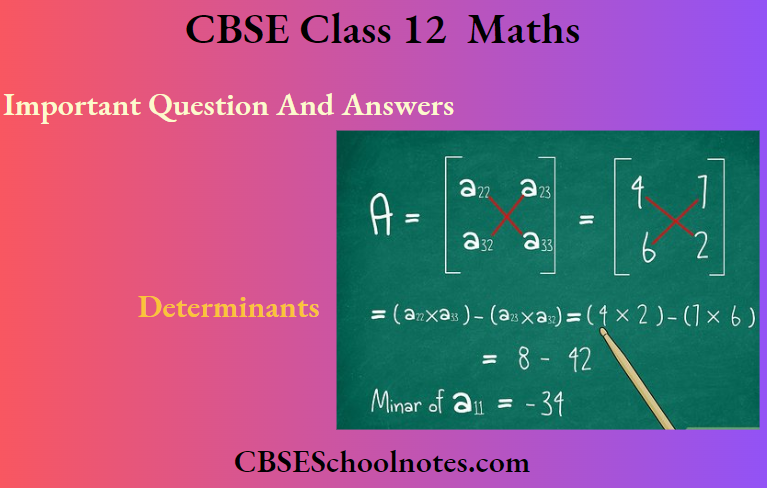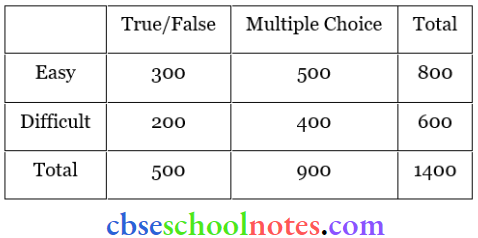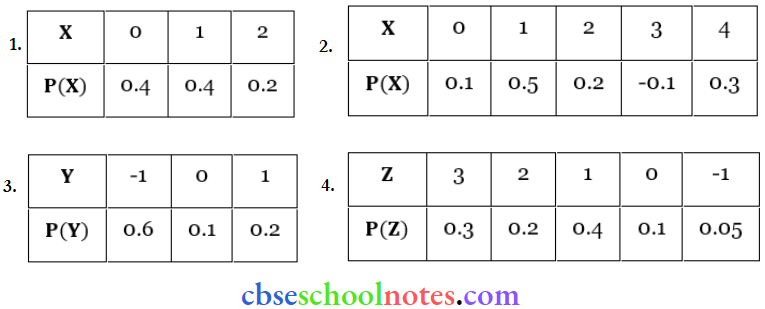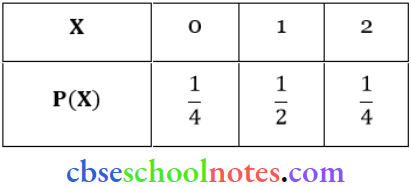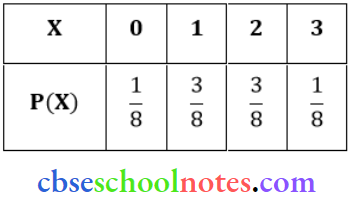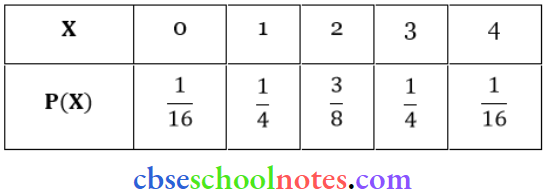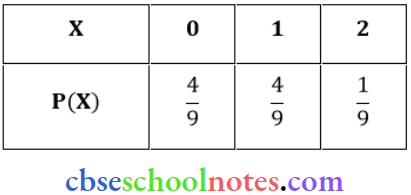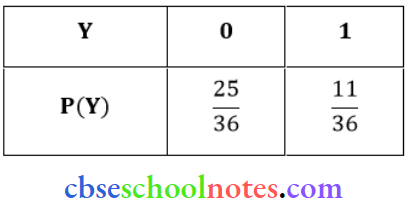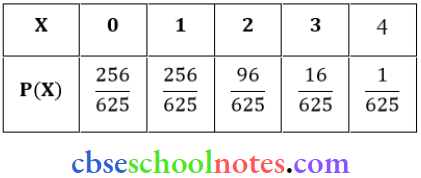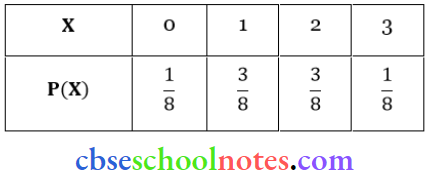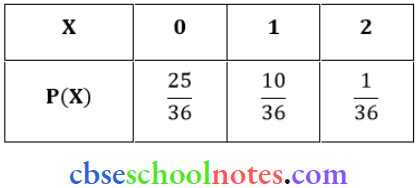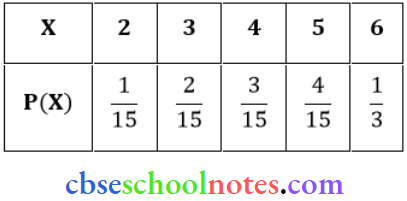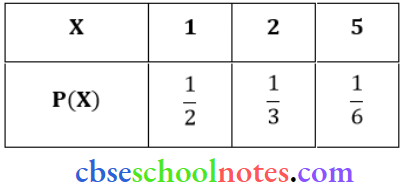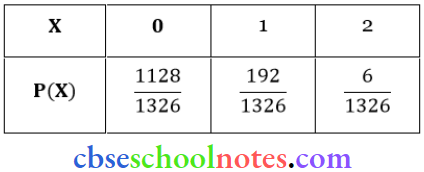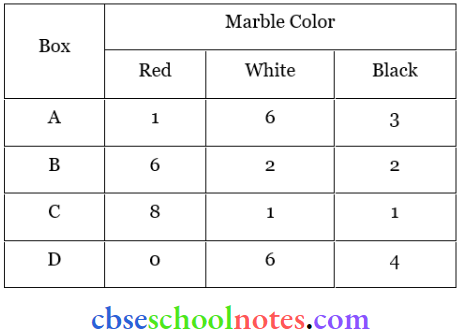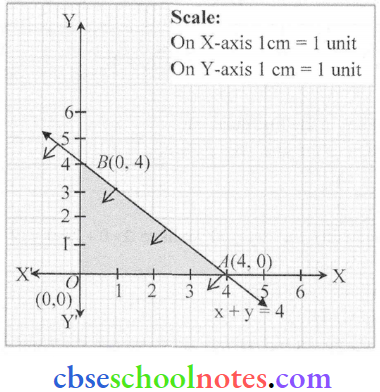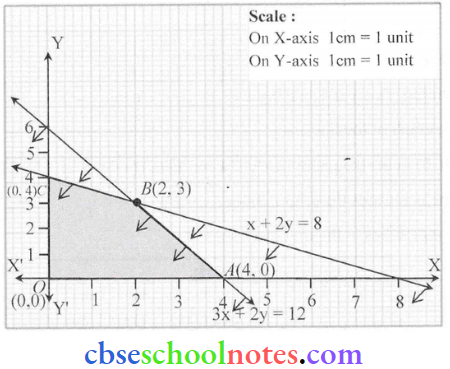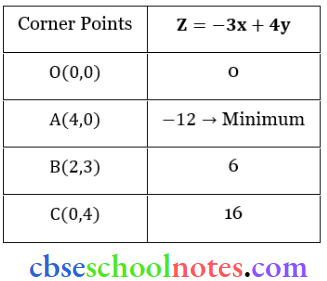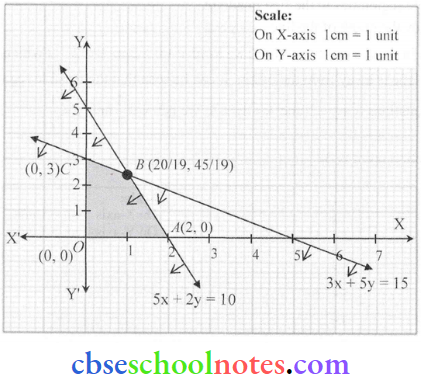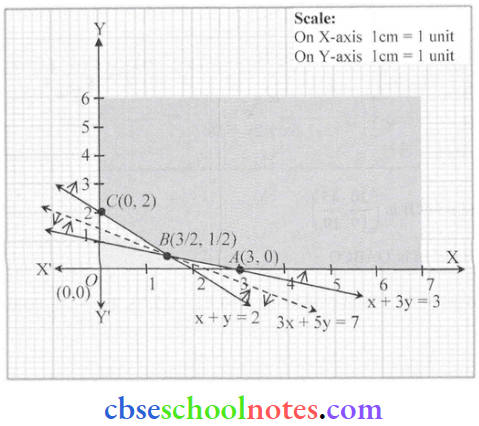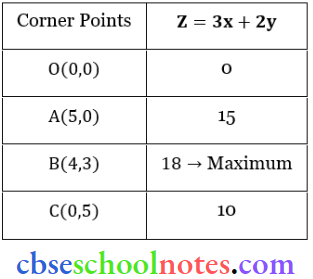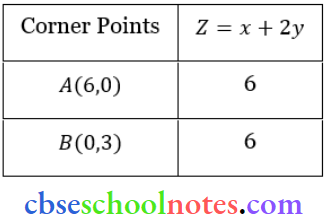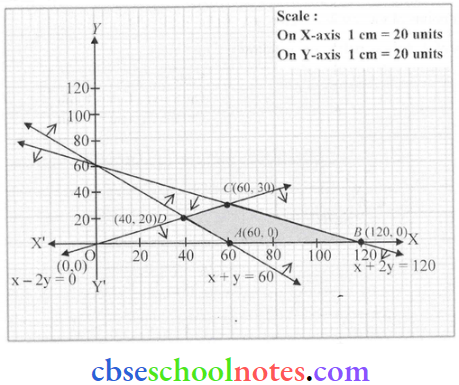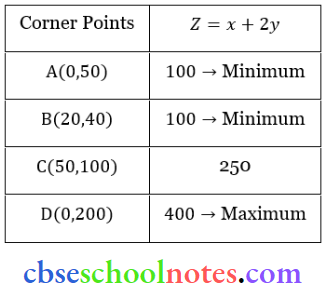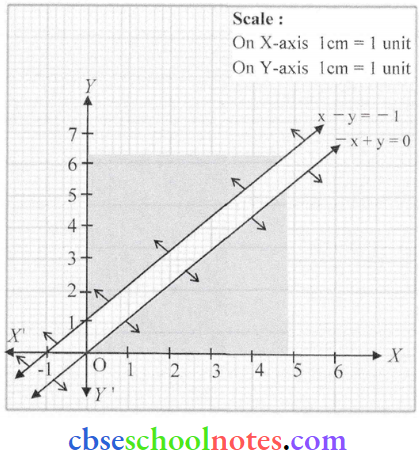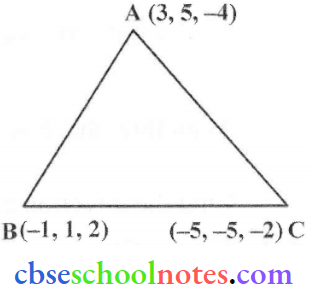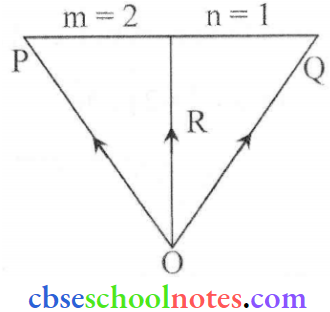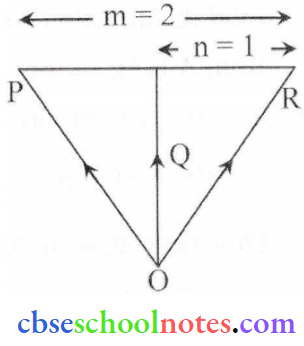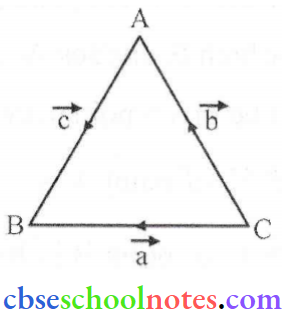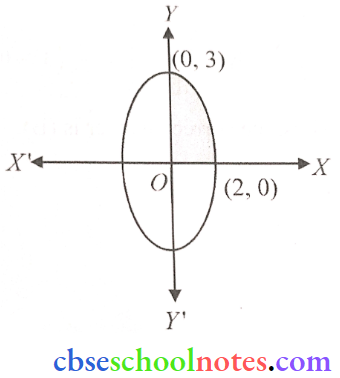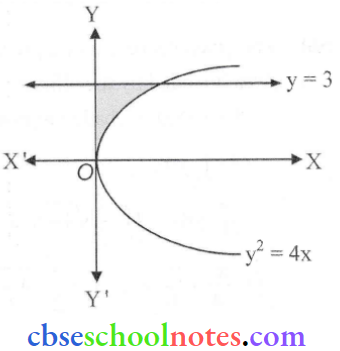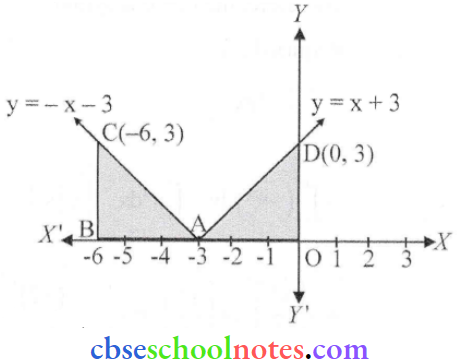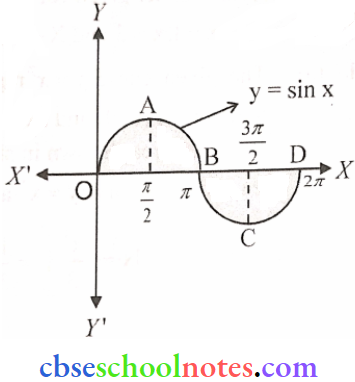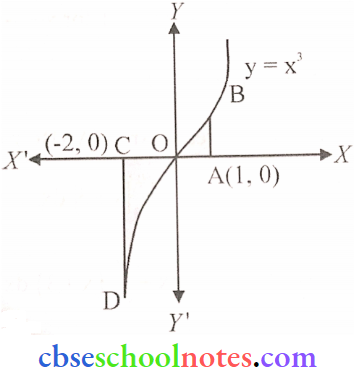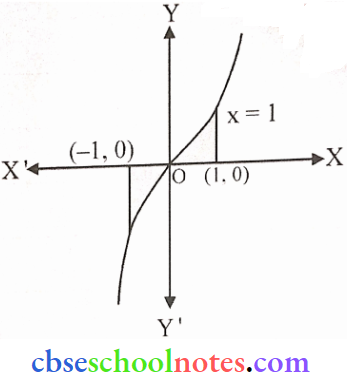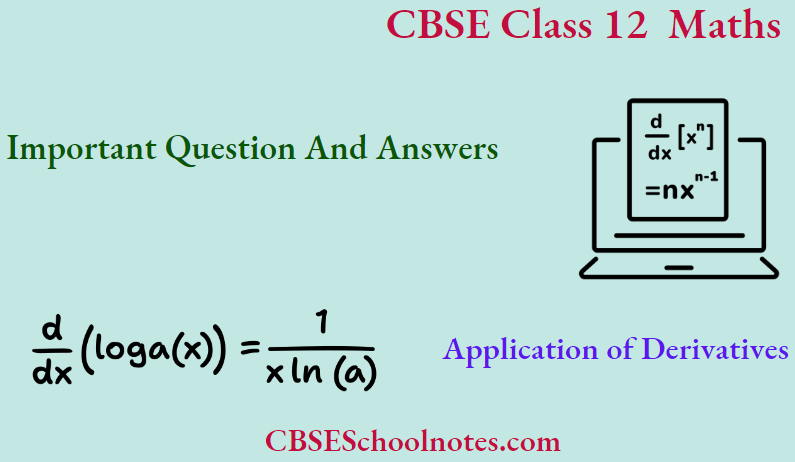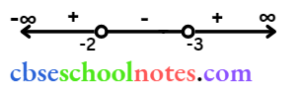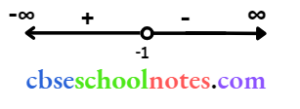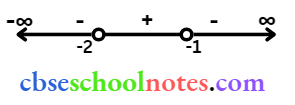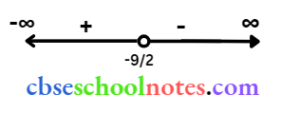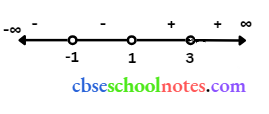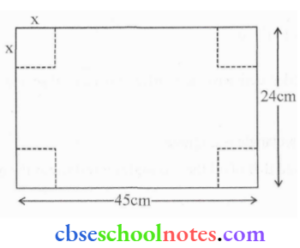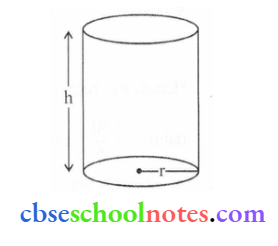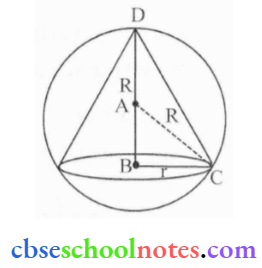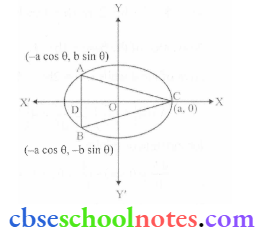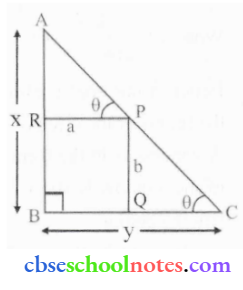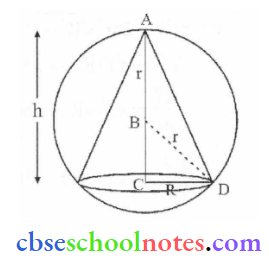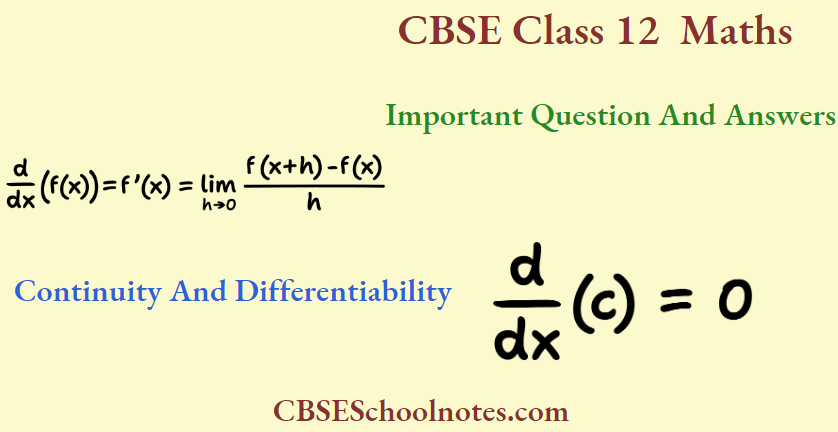Integrals Exercise 7.1
Find An antiderivative (Or Integral) Of the following function by the method of inspection.
Question 1. sin2x
Solution:
The anti-derivate of sin2x is a function of x whose derivative is sin2x. It is known that,
∵ \(\frac{d}{d x}(\cos 2 x)=-2 \sin 2 x \Rightarrow-\frac{1}{2} \frac{d}{d x}(\cos 2 x)=\sin 2 x \Rightarrow \frac{d}{d x}\left(-\frac{1}{2} \cos 2 x\right)=\sin 2 x\)
Therefore, the anti-derivates of sin2x is –\(\frac{1}{2}\) cos2x
Question 2. cos 3x
Solution:
The anti-derviative of cos 3x is a function of x whose derivative is cos 3x.
∵ \(\frac{d}{d x}(\sin 3 x)=3 \cos 3 x \Rightarrow \frac{1}{3} \frac{d}{d x}(\sin 3 x)=\cos 3 x \Rightarrow \frac{d}{d x}\left(\frac{1}{3} \sin 3 x\right)=\cos 3 x\)
Therefore, the anti-derivates of sos 3x is –\(\frac{1}{3}\) sin 3x.
Question 3. e2x
Solution:
The anti-derviative of cos 3x is a function of x whose derivative is cos 3x.
∵ \(\frac{\mathrm{d}}{\mathrm{dx}}\left(\mathrm{e}^{2 \mathrm{x}}\right)=2 \mathrm{e}^{2 \mathrm{x}} \Rightarrow \frac{1}{2} \frac{\mathrm{d}}{\mathrm{dx}}\left(\mathrm{e}^{2 \mathrm{x}}\right)=\mathrm{e}^{2 \mathrm{x}} \Rightarrow \frac{\mathrm{d}}{\mathrm{dx}}\left(\frac{1}{2} \mathrm{e}^{2 \mathrm{x}}\right)=\mathrm{e}^{2 \mathrm{x}}\)
Therefore, the anti-derivates of e2x is –\(\frac{1}{2}\) e2x.
Question 4. (ax + b)²
Solution:
The anti-derviative of (ax+b)² is a function of x whose derivative is (ax+b)².
It is known that,
∵ \(\frac{d}{d x}(a x+b)^3=3 a(a x+b)^2 \Rightarrow \frac{1}{3 a} \frac{d}{d x}(a x+b)^3\)
= \((a x+b)^2 \Rightarrow \frac{d}{d x}\left(\frac{1}{3 a}(a x+b)^3\right)=(a x+b)^2\)
Therefore, the anti-derivates of (ax+b) is –\(\frac{1}{3a}\) (ax+b).
Question 5. sin 2x – 4e3x
Solution:
The anti-derivative of (sin 2x – 4e3x) is a function of x whose derivative is (sin 2x – 4e3x).
∵ \(\frac{d}{d x}(\cos 2 x)=-2 \sin 2 x \Rightarrow-\frac{1}{2} \frac{d}{d x}(\cos 2 x)=\sin 2 x \Rightarrow \frac{d}{d x}\left(-\frac{1}{2} \cos 2 x\right)=\sin 2 x\)
Similarly, \(\frac{d}{d x}\left(\frac{4}{3} e^{3 x}\right)=4 e^{3 x}\)
∵ \(\frac{d}{d x}\left(-\frac{1}{2} \cos 2 x\right)-\frac{d}{d x}\left(\frac{4}{3} e^{3 x}\right)=\sin 2 x-4 e^{3 x} \Rightarrow \frac{d}{d x}\left(-\frac{1}{2} \cos 2 x-\frac{4}{3} e^{3 x}\right)=\sin 2 x-4 e^{3 x}\)
Therefore, the antiderivative of \(\left(\sin 2 x-4 e^{3 x}\right)\) is \(\left(-\frac{1}{2} \cos 2 x-\frac{4}{3} e^{3 x}\right)\)
Find The Following Integrals
Question 6. \(\int\left(4 e^{3 x}+1\right) d x\)
Solution:
Let \(\mathrm{I}=\int\left(4 \mathrm{e}^{3 \mathrm{x}}+1\right) \mathrm{dx}\)
= \(4 \int e^{3 x} d x+\int 1 d x=4\left(\frac{e^{3 x}}{3}\right)+x+C=\frac{4}{3} e^{3 x}+x+C\)
Question 7. \(\int x^2\left(1-\frac{1}{x^2}\right) d x\)
Solution:
⇒ \(\int x^2\left(1-\frac{1}{x^2}\right) d x=\int\left(x^2-1\right) d x=\int x^2 d x-\int 1 d x=\frac{x^3}{3}-x+C\)
Read and Learn More Class 12 Maths Chapter Wise with Solutions
Question 8. \(\int\left(a x^2+b x+c\right) d x\)
Solution:
Let \(I=\int\left(a x^2+b x+c\right) d x=a \int x^2 d x+b \int x d x+c \int 1 . d x\)
= \(a\left(\frac{x^3}{3}\right)+b\left(\frac{x^2}{2}\right)+c x+C=\frac{a x^3}{3}+\frac{b x^2}{2}+c x+C\)
Question 9. \(\int\left(2 x^2+e^x\right) d x\)
Solution:
Let \(\mathrm{I}=\int\left(2 \mathrm{x}^2+\mathrm{e}^{\mathrm{x}}\right) \mathrm{dx}=2 \int \mathrm{x}^2 \mathrm{dx}+\int \mathrm{e}^{\mathrm{x}} \mathrm{dx}=2\left(\frac{\mathrm{x}^3}{3}\right)+\mathrm{e}^{\mathrm{x}}+\mathrm{C}=\frac{2}{3} \mathrm{x}^3+\mathrm{e}^{\mathrm{x}}+\mathrm{C}\)
Question 10. \(\int\left(\sqrt{\mathrm{x}}-\frac{1}{\sqrt{\mathrm{x}}}\right)^2 \mathrm{dx}\)
Solution:
Let \(I=\int\left(\sqrt{x}-\frac{1}{\sqrt{x}}\right)^2 d x=\int\left(x+\frac{1}{x}-2\right) d x\)
= \(\int x d x+\int \frac{1}{x} d x-2 \int 1, d x=\frac{x^2}{2}+\log |x|-2 x+C\)
Question 11. \(\int \frac{x^3+5 x^2-4}{x^2} d x\)
Solution:
Let \(I=\int \frac{x^3+5 x^2-4}{x^2} d x=\int\left(x+5-4 x^{-2}\right) d x=\int x d x+5 \int 1 . d x-4 \int x^{-2} d x\)
= \(\frac{x^2}{2}+5 x-4\left(\frac{x^{-1}}{-1}\right)+C=\frac{x^2}{2}+5 x+\frac{4}{x}+C\)
Question 12. \(\int \frac{x^3+3 x+4}{\sqrt{x}} d x\)
Solution:
Let \(\mathrm{I}=\int \frac{\mathrm{x}^3+3 \mathrm{x}+4}{\sqrt{\mathrm{x}}} \mathrm{dx}=\int\left(\mathrm{x}^{\frac{5}{2}}+3 \mathrm{x}^{\frac{1}{2}}+4 \mathrm{x}^{\frac{-1}{2}}\right) \mathrm{dx}\)
(because \(\int \mathrm{x}^{\mathrm{n}} \mathrm{dx}=\frac{\mathrm{x}^{\mathrm{n}+1}}{\mathrm{n}+1}+\mathrm{C}\))
= \(\frac{x^{\left(\frac{7}{2}\right)}}{\frac{7}{2}}+\frac{3\left(x^{\frac{3}{2}}\right)}{\frac{3}{2}}+\frac{4\left(x^{\frac{1}{2}}\right)}{\frac{1}{2}}+C=\frac{2}{7} x^{\frac{7}{2}}+2 x^{\frac{3}{2}}+8 x^{\frac{1}{2}}+C=\frac{2}{7} x^{\frac{7}{2}}+2 x^{\frac{3}{2}}+8 \sqrt{x}+C\)
Question 13. \(\int \frac{x^3-x^2+x-1}{x-1} d x\)
Solution:
Let \(\mathrm{I}=\int \frac{\mathrm{x}^3-\mathrm{x}^2+\mathrm{x}-1}{\mathrm{x}-1} \mathrm{dx}\)
On dividing, we obtain
I = \(\int \frac{x^2(x-1)+1(x-1)}{x-1} d x=\int \frac{(x-1)\left(x^2+1\right)}{(x-1)} d x=\int x^2 d x+\int 1 \cdot d x=\frac{x^3}{3}+x+C\)
Question 14. \(\int(1-x) \sqrt{x} d x\)
Solution:
Let \(I=\int(1-x) \sqrt{x} d x=\int\left(\sqrt{x}-x^{\frac{3}{2}}\right) d x=\int x^{\frac{1}{2}} d x-\int x^{\frac{3}{2}} d x\)
=\(\frac{x^{\frac{3}{2}}}{3 / 2}-\frac{x^{\frac{5}{2}}}{5 / 2}+C=\frac{2}{3} x^{3 / 2}-\frac{2}{5} x^{5 / 2}+C\)
Question 15. \(\int \sqrt{\mathrm{x}}\left(3 \mathrm{x}^2+2 \mathrm{x}+3\right) \mathrm{dx}\)
Solution:
Let \(\mathrm{I}=\int \sqrt{\mathrm{x}}\left(3 \mathrm{x}^2+2 \mathrm{x}+3\right) \mathrm{dx}=\int\left(3 \mathrm{x}^{\frac{5}{2}}+2 \mathrm{x}^{\frac{3}{2}}+3 \mathrm{x}^{\frac{1}{2}}\right) \mathrm{dx}\)
= \(3 \int \mathrm{x}^{-\frac{5}{2}} \mathrm{dx}+2 \int \mathrm{x}^{\frac{3}{2}} \mathrm{dx}+3 \int \mathrm{x}^{\frac{1}{2}} d x\)
= \(3\left(\frac{x^{\frac{7}{2}}}{\frac{7}{2}}\right)+2\left(\frac{x^{\frac{5}{2}}}{\frac{5}{2}}\right)+3\left(\frac{x^{\frac{3}{2}}}{\frac{3}{2}}\right)+C=\frac{6}{7} x^{\frac{7}{2}}+\frac{4}{5} x^{\frac{5}{2}}+2 x^{\frac{3}{2}}+C\)
Question 16. \(\int\left(2 x-3 \cos x+e^x\right) d x\)
Solution:
Let \(I=\int\left(2 x-3 \cos x+e^x\right) d x=2 \int x d x-3 \int \cos x d x+\int e^x d x\)
= \(\frac{2 \mathrm{x}^2}{2}-3(\sin \mathrm{x})+\mathrm{e}^{\mathrm{x}}+\mathrm{C}=\mathrm{x}^2-3 \sin \mathrm{x}+\mathrm{e}^{\mathrm{x}}+\mathrm{C}\)
Question 17. \(\int\left(2 x^2-3 \sin x+5 \sqrt{x}\right) d x\)
Solution:
Let \(I=\int\left(2 x^2-3 \sin x+5 \sqrt{x}\right) d x=2 \int x^2 d x-3 \int \sin x d x+5 \int x^{\frac{1}{2}} d x\)
= \(\frac{2 x^3}{3}-3(-\cos x)+5\left(\frac{x^{\frac{3}{2}}}{\frac{3}{2}}\right)+C=\frac{2}{3} x^3+3 \cos x+\frac{10}{3} x^{\frac{3}{2}}+C\)
Question 18. \(\int \sec x(\sec x+\tan x) d x\)
Solution:
Let \(I=\int \sec x(\sec x+\tan x) d x=\int\left(\sec ^2 x+\sec x \tan x\right) d x\)
= \(\tan \mathrm{x}+\sec \mathrm{x}+\mathrm{C}\)
Question 19. \(\int \frac{\sec ^2 x}{\mathrm{cosec}^2 x} d x\)
Solution:
Let \(I=\int \frac{\sec ^2 x}{\mathrm{cosec}^2 x} d x=\int \frac{\frac{1}{\cos ^2 x}}{\frac{1}{\sin ^2 x}} d x=\int \frac{\sin ^2 x}{\cos ^2 x} d x\)
= \(\int \tan ^2 x d x=\int\left(\sec ^2 x-1\right) d x=\int \sec ^2 x d x-\int 1 d x=\tan x-x+C\)
Question 20. \(\int \frac{2-3 \sin x}{\cos ^2 x} d x\)
Solution:
Let I = \(\int \frac{2-3 \sin x}{\cos ^2 x} d x=\int\left(\frac{2}{\cos ^2 x}-\frac{3 \sin x}{\cos ^2 x}\right) d x\)
= \(\int 2 \sec ^2 x d x-3 \int \tan x \sec x d x=2 \tan x-3 \sec x+C\)
Choose The Correct Answer In The Following
Question 21. The anti derivative of \(\left(\sqrt{\mathrm{x}}+\frac{1}{\sqrt{\mathrm{x}}}\right)\) equals?
- \(\frac{1}{3} \mathrm{x}^{\frac{1}{3}}+2 \mathrm{x}^{\frac{1}{2}}+C\)
- \(\frac{2}{3} \mathrm{x}^{\frac{2}{3}}+\frac{1}{2} \mathrm{x}^2+\mathrm{C}\)
- \(\frac{2}{3} \mathrm{x}^{\frac{3}{2}}+2 \mathrm{x}^{\frac{1}{2}}+\mathrm{C}\)
- \(\frac{3}{2} \mathrm{x}^{\frac{3}{2}}+\frac{1}{2} \mathrm{x}^{\frac{1}{2}}+\mathrm{C}\)
Solution: 3. \(\frac{2}{3} \mathrm{x}^{\frac{3}{2}}+2 \mathrm{x}^{\frac{1}{2}}+\mathrm{C}\)
Let \(\mathrm{I}=\int\left(\sqrt{\mathrm{x}}+\frac{1}{\sqrt{\mathrm{x}}}\right) \mathrm{dx}=\int \mathrm{x}^{\frac{1}{2}} \mathrm{dx}+\int \mathrm{x}^{-\frac{1}{2}} \mathrm{dx}=\frac{\mathrm{x}^{\frac{3}{2}}}{3 / 2}+\frac{\mathrm{x}^{\frac{1}{2}}}{1 / 2}+\mathrm{C}=\frac{2}{3} \mathrm{x}^{\frac{3}{2}}+2 \mathrm{x}^{\frac{1}{2}}+\mathrm{C}\)
Hence, the correct Answer is 3.
Question 22. If \(\frac{\mathrm{d}}{\mathrm{dx}}(f(\mathrm{x}))=4 \mathrm{x}^3-\frac{3}{\mathrm{x}^4}\) such that f(2)=0, then f(x) is?
- \(x^4+\frac{1}{x^3}-\frac{129}{8}\)
- \(x^3+\frac{1}{x^4}+\frac{129}{8}\)
- \(\mathrm{x}^4+\frac{1}{\mathrm{x}^3}+\frac{129}{8}\)
- \(\mathrm{x}^3+\frac{1}{\mathrm{x}^4}-\frac{129}{8}\)
Solution: 1. \(x^4+\frac{1}{x^3}-\frac{129}{8}\)
It is given that, \(\frac{\mathrm{d}}{\mathrm{dx}}(f(\mathrm{x}))=4 \mathrm{x}^3-\frac{3}{\mathrm{x}^4}\)
∴ Integrating both sides with respect to x
∴ \(f(\mathrm{x})=\int\left(4 \mathrm{x}^3-\frac{3}{\mathrm{x}^4}\right) \mathrm{dx} \Rightarrow f(\mathrm{x})=4 \int \mathrm{x}^3 \mathrm{dx}-3 \int\left(\mathrm{x}^{-4}\right) \mathrm{dx}\)
⇒ \(f(\mathrm{x})=4\left(\frac{\mathrm{x}^4}{4}\right)-3\left(\frac{\mathrm{x}^{-3}}{-3}\right)+\mathrm{C}\)
∴ \(f(\mathrm{x})=\mathrm{x}^4+\frac{1}{\mathrm{x}^3}+\mathrm{C}\)
Also, f(2)=0
∴ \(f(2)=(2)^4+\frac{1}{(2)^3}+\mathrm{C}=0 \Rightarrow 16+\frac{1}{8}+\mathrm{C}=0 \Rightarrow \mathrm{C}=-\left(16+\frac{1}{8}\right) \Rightarrow \mathrm{C}=-\frac{129}{8}\)
Put the value of C in equation (1)
f(x) = \(x^4+\frac{1}{x^3}-\frac{129}{8} \text {. }\)
Hence, the correct answer is (1).
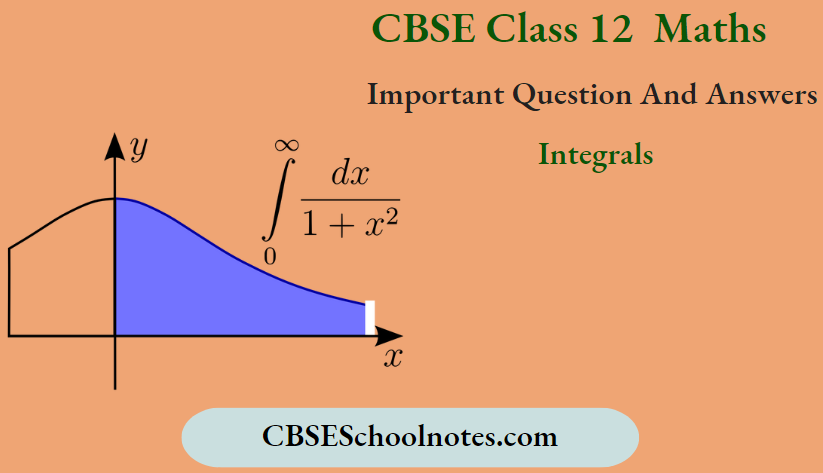
Integrals Exercise 7.2
IntegrateThe Functions
Question 1. \(\int \frac{2 \mathrm{x}}{1+\mathrm{x}^2} \mathrm{dx}\)
Solution:
Let \(\mathrm{I}=\int \frac{2 \mathrm{x}}{1+\mathrm{x}^2} \mathrm{dx}\)
Put \(1+\mathrm{x}^2=\mathrm{t} \Rightarrow 2 \mathrm{xdx}=\mathrm{dt}\)
⇒ \(\mathrm{I}=\int_{\mathrm{t}}^1 \frac{1}{\mathrm{dt}}=\log |\mathrm{t}|+\mathrm{C}=\log \left|1+\mathrm{x}^2\right|+\mathrm{C}=\log \left(1+\mathrm{x}^2\right)+\mathrm{C}\)
Question 2. \(\int \frac{(\log |\mathrm{x}|)^2}{\mathrm{x}} \mathrm{dx}\)
Solution:
Let \(\mathrm{I}=\int \frac{(\log |\mathrm{x}|)^2}{\mathrm{x}} \mathrm{dx}\)
Put \(\log |x|=t \Rightarrow \frac{1}{x} d x=d t \Rightarrow I=\int t^2 d t=\frac{t^3}{3}+C=\frac{(\log |x|)^3}{3}+C\)
Question 3. \(\int \frac{1}{x+x \log x} d x\)
Solution:
Let \(I=\int \frac{1}{x+x \log x} d x=\int \frac{1}{x(1+\log x)} d x\)
Put \(1+\log \mathrm{x}=\mathrm{t} \Rightarrow \frac{1}{\mathrm{x}} \mathrm{dx}=\mathrm{dt}\)
Question 4. \(\int \sin x \cdot \sin (\cos x) d x\)
Solution:
Let \(\mathrm{I}=\int \sin \mathrm{x}, \sin (\cos \mathrm{x}) \mathrm{dx}\)
Put \(\cos \mathrm{x}=\mathrm{t} \Rightarrow-\sin \mathrm{x} \mathrm{dx}=\mathrm{dt}\)
⇒ \(\mathrm{I}=-\int \sin \mathrm{tdt}=-[-\cos \mathrm{t}]+\mathrm{C}=\cos (\cos \mathrm{x})+\mathrm{C}\)
Question 5.\(\int \sin (a x+b) \cos (a x+b) d x\)
Solution:
Let \(\mathrm{I}=\int \sin (a \mathrm{ax}+\mathrm{b}) \cos (a \mathrm{ax}+\mathrm{b}) \mathrm{dx}=\frac{1}{2} \int \sin 2(a \mathrm{a}+\mathrm{b}) \mathrm{dx}\)
Put \(2(a x+b)=t \Rightarrow d x=\frac{d t}{2 a}\)
⇒ I = \(\frac{1}{2} \int \frac{\sin t d t}{2 a}=\frac{1}{4 a}[-\cos t]+C=\frac{-1}{4 a} \cos 2(a x+b)+C\)
Question 6. \(\int \sqrt{a x+b} d x\)
Solution:
Let \(I=\int \sqrt{a x+b} d x\)
Put \(a x+b=t^2 \Rightarrow a d x=2 t d t\)
∴ I = \(\int t \cdot \frac{2 t}{a} d t=\frac{2}{a} \int t^2 d t=\frac{2}{a} \cdot \frac{t^3}{3}+C=\frac{2}{3 a}(a x+b)^{3 / 2}+C\)
Question 7. \(\int x \sqrt{x+2} d x\)
Solution:
Let \(\mathrm{I}=\int \mathrm{x} \sqrt{\mathrm{x}+2} \mathrm{dx}\)
Put \(x+2=t^2 \Rightarrow d x=2 t d t\)
∴ \(\mathrm{I}=\int\left(\mathrm{t}^2-2\right) \cdot \mathrm{t} \cdot 2 \mathrm{tdt}=\int\left(2 \mathrm{t}^4-4 \mathrm{t}^2\right) \mathrm{dt}\)
= \(\frac{2}{5} \mathrm{t}^5-\frac{4}{3} \mathrm{t}^3+\mathrm{C}=\frac{2}{5}(\mathrm{x}+2)^{5 / 2}-\frac{4}{3}(\mathrm{x}+2)^{3 / 2}+\mathrm{C}\)
Question 8. \(\int x \sqrt{1+2 x^2} d x\)
Solution:
Let \(\mathrm{I}=\int \mathrm{x} \sqrt{1+2 \mathrm{x}^2} \mathrm{dx}\)
Put \(1+2 x^2=t^2 \Rightarrow 4 x d x=2 t d t \Rightarrow x d x=\frac{t}{2} d t\)
∴ I = \(\int t \cdot \frac{t}{2} d t=\frac{1}{2} \int t^2 d t=\frac{1}{6} t^3+C=\frac{1}{6}\left(1+2 x^2\right)^{3 / 2}+C\)
Question 9. \(\int(4 x+2) \sqrt{x^2+x+1} d x\)
Solution:
Let \(\mathrm{I}=\int(4 \mathrm{x}+2) \sqrt{\mathrm{x}^2+\mathrm{x}+1} \mathrm{dx}\)
Put \(x^2+x+1=t^2 \Rightarrow(2 x+1) d x=2 t d t\)
⇒ \(\mathrm{I}=2 \int \mathrm{t} \cdot 2 \mathrm{tdt}=4 \int \mathrm{t}^2 \mathrm{dt}=\frac{4}{3} \mathrm{t}^3+\mathrm{C}=\frac{4}{3}\left(\mathrm{x}^2+\mathrm{x}+1\right)^{3 / 2}+\mathrm{C}\)
Question 10. \(\int \frac{1}{x-\sqrt{x}} d x\)
Solution:
Let \(I=\int \frac{1}{x-\sqrt{x}} d x=\int \frac{1}{\sqrt{x}(\sqrt{x}-1)} d x\)
Put \((\sqrt{\mathrm{x}}-1)=\mathrm{t} \Rightarrow \frac{1}{2 \sqrt{\mathrm{x}}} \mathrm{dx}=\mathrm{dt} \Rightarrow \frac{1}{\sqrt{\mathrm{x}}} \mathrm{dx}=2 \mathrm{dt}\)
∴ I = \(\int \frac{1}{t} \cdot 2 d t=2 \log |t|+C=2 \log |\sqrt{x}-1|+C\)
Question 11. \(\int \frac{\mathrm{x}}{\sqrt{\mathrm{x}+4}} \cdot \mathrm{dx}, \mathrm{x}>0\)
Solution:
Let \(\mathrm{I}=\int \frac{\mathrm{x}}{\sqrt{\mathrm{x}+4}} \cdot \mathrm{dx}, \mathrm{x}>0\)
Put \(x+4=t^2 \Rightarrow x=t^2-4 \Rightarrow d x=2 t d t\)
∴ I = \(\int \frac{\left(t^2-4\right)}{t} \cdot 2 t d t=2 \int\left(t^2-4\right) d t=2\left[\frac{t^3}{3}-4 t\right]+C\)
= \(\frac{2}{3} t\left[t^2-12\right]+C=\frac{2}{3} \sqrt{x+4}(x-8)+C\)
Question 12. \(\int\left(x^3-1\right)^{\frac{1}{3}} x^5 d x\)
Solution:
Let \(I=\int\left(x^3-1\right)^{\frac{1}{3}} x^5 d x\)
I = \(\int\left(x^3-1\right)^{1 / 3} \cdot x^3 \cdot x^2 d x\)
Put \(x^3-1=t^3 \Rightarrow x^3=t^3+1 \Rightarrow x^2 d x=t^2 d t\)
∴ I = \(\int t \cdot\left(t^3+1\right) \cdot t^2 d t=\int\left(t^6+t^3\right) d t=\frac{t^7}{7}+\frac{t^4}{4}+C=\frac{1}{7}\left(x^3-1\right)^{7 / 3}+\frac{1}{4}\left(x^3-1\right)^{4 / 3}+C\)
Question 13. \(\int \frac{x^2}{\left(2+3 x^3\right)^3} d x\)
Solution:
Let \(I=\int \frac{x^2}{\left(2+3 x^3\right)^3} d x\)
Put \(2+3 x^3=t \Rightarrow 9 x^2 d x=d t\)
∴ \(\mathrm{I}=\int \frac{1}{\mathrm{t}^3}, \frac{\mathrm{dt}}{9}=\frac{1}{9} \int \frac{1}{\mathrm{t}^3} \mathrm{dt}=\frac{1}{9}\left[\frac{\mathrm{t}^{-2}}{-2}\right]+\mathrm{C}=-\frac{1}{18}\left[\frac{1}{\mathrm{t}^2}\right]+\mathrm{C}=-\frac{1}{18\left(2+3 \mathrm{x}^3\right)^2}+\mathrm{C}\)
Question 14. \(\int \frac{1}{x(\log x)^m} d x, x>0, m \neq 1\)
Solution:
Let \(\mathrm{I}=\int \frac{1}{\mathrm{x}(\log \mathrm{x})^{\mathrm{m}}} \mathrm{dx}\)
Put \(\log \mathrm{x}=\mathrm{t} \Rightarrow \frac{1}{\mathrm{x}} \mathrm{dx}=\mathrm{dt}\)
⇒ \(\mathrm{I}=\int \frac{\mathrm{dt}}{(\mathrm{t})^{\mathrm{m}}}=\int \mathrm{t}^{-\mathrm{m}} \mathrm{dt}=\left(\frac{\mathrm{t}^{1-\mathrm{m}}}{1-\mathrm{m}}\right)+\mathrm{C}=\frac{(\log \mathrm{x})^{1-\mathrm{m}}}{(1-\mathrm{m})}+\mathrm{C}\)
Question 15. \(\int \frac{x}{9-4 x^2} d x\)
Solution:
Let \(I=\int \frac{x}{9-4 x^2} d x\)
Put \(9-4 \mathrm{x}^2=\mathrm{t} \Rightarrow-8 \mathrm{xdx}=\mathrm{dt}\)
∴ I = \(\frac{-1}{8} \int_t^1 \frac{1}{t}=\frac{-1}{8} \log |t|+C=\frac{-1}{8} \log \left|9-4 x^2\right|+C\)
Question 16. \(\int \mathrm{e}^{2 \mathrm{x}+3} \mathrm{dx}\)
Solution:
Let \(I=\int e^{2 x+3} d x\)
Put \(2 \mathrm{x}+3=\mathrm{t} \Rightarrow \mathrm{dx}=\frac{\mathrm{dt}}{2}\)
∴ \(\mathrm{I}=\frac{1}{2} \int \mathrm{e}^{\mathrm{t}} \mathrm{dt}=\frac{1}{2}\left(\mathrm{e}^{\mathrm{t}}\right)+\mathrm{C}=\frac{1}{2} \mathrm{e}^{(2 \mathrm{x}+3)}+\mathrm{C}\)
Question 17. \(\int \frac{\mathrm{x}}{\mathrm{e}^{\mathrm{x}^2}} \mathrm{dx}\)
Solution:
Let \(\mathrm{I}=\int \frac{\mathrm{x}}{\mathrm{e}^{\mathrm{x}^2}} \mathrm{dx}\)
Put \(\mathrm{x}^2=\mathrm{t} \Rightarrow 2 \mathrm{xdx}=\mathrm{dt}\)
∴ \(\mathrm{I}=\frac{1}{2} \int \frac{1}{\mathrm{e}^{\mathrm{t}}} \mathrm{dt}=\frac{1}{2} \int \mathrm{e}^{-t} \mathrm{dt}=\frac{1}{2}\left(\frac{\mathrm{e}^{-1}}{-1}\right)+\mathrm{C}=-\frac{1}{2} \mathrm{e}^{-\mathrm{x}^2}+\mathrm{C}=\frac{-1}{2 \mathrm{e}^{\mathrm{x}^2}}+\mathrm{C}\)
Question 18. \(\int \frac{e^{\sin -1 x}}{1+x^2} d x\)
Solution:
Let \(\mathrm{I}=\int \frac{\mathrm{e}^{\mathrm{lin}^{-1} \mathrm{x}}}{1+\mathrm{x}^2} \mathrm{dx}\)
Put \(\tan ^{-1} \mathrm{x}=\mathrm{t} \Rightarrow \frac{1}{1+\mathrm{x}^2} \mathrm{dx}=\mathrm{dt}\)
∴ \(\mathrm{I}=\int \mathrm{e}^t \mathrm{dt}=\mathrm{e}^{\mathrm{t}}+\mathrm{C}=\mathrm{e}^{\tan ^{-1} \mathrm{x}}+\mathrm{C}
\)
Question 19. \(\int \frac{\mathrm{e}^{2 \mathrm{x}}-1}{\mathrm{e}^{2 \mathrm{x}}+1} \mathrm{dx}\)
Solution:
Let \(\mathrm{I}=\int \frac{\mathrm{e}^{2 \mathrm{x}}-1}{\mathrm{e}^{2 \mathrm{x}}+1} \mathrm{dx} \Rightarrow \mathrm{I}=\int \frac{\mathrm{e}^{\mathrm{x}}-\mathrm{e}^{-\mathrm{x}}}{\mathrm{e}^{\mathrm{x}}+\mathrm{e}^{-\mathrm{x}}} \mathrm{dx}\)
Dividing numerator and denominator by \(\mathrm{e}^{\mathrm{x}}\)
Put \(\mathrm{e}^{\mathrm{x}}+\mathrm{e}^{-\mathrm{x}}=\mathrm{t} \Rightarrow\left(\mathrm{e}^{\mathrm{x}}-\mathrm{e}^{-x}\right) \mathrm{dx}=\mathrm{dt}\)
∴ \(I=\int \frac{d t}{t}=\log |t|+C=\log \left|e^x+e^{-x}\right|+C\)
Question 20. \(\int \frac{e^{2 x}-e^{-2 x}}{e^{2 x}+e^{-2 x}} d x\)
Solution:
Let \(\mathrm{I}=\int \frac{\mathrm{e}^{2 \mathrm{x}}-\mathrm{e}^{-2 \mathrm{x}}}{\mathrm{e}^{2 \mathrm{x}}+\mathrm{e}^{-2 \mathrm{x}}} \mathrm{dx}\)
Put \(\mathrm{e}^{2 \mathrm{x}}+\mathrm{e}^{-2 \mathrm{x}}=\mathrm{t} \Rightarrow\left(2 \mathrm{e}^{2 \mathrm{x}}-2 \mathrm{e}^{-2 \mathrm{x}}\right) \mathrm{dx}=\mathrm{dt} \Rightarrow\left(\mathrm{e}^{2 \mathrm{x}}-\mathrm{e}^{-2 \mathrm{x}}\right) \mathrm{dx}=\frac{\mathrm{dt}}{2}\)
∴ \(\mathrm{I}=\frac{1}{2} \int_{\mathrm{t}}^1 \mathrm{dt}=\frac{1}{2} \log |\mathrm{t}|+\mathrm{C}=\frac{1}{2} \log \left|\mathrm{e}^{2 \mathrm{x}}+\mathrm{e}^{-2 \mathrm{x}}\right|+\mathrm{C}\)
Question 21. \(\int \tan ^2(2 x-3) d x\)
Solution:
Let \(\mathrm{I}=\int \tan ^2(2 \mathrm{x}-3) \mathrm{dx}\)
Put \(2 \mathrm{x}-3=\mathrm{t} \Rightarrow \mathrm{dx}=\frac{\mathrm{dt}}{2}\)
∴ I = \(\frac{1}{2} \int \tan ^2 t \cdot d t=\frac{1}{2} \int\left(\sec ^2 t-1\right) d t\)
= \(\frac{1}{2}[\tan t-t]+C_1=\frac{1}{2}[\tan (2 x-3)-(2 x-3)]+C_1\)
= \(\frac{1}{2} \tan (2 x-3)-x+\frac{3}{2}+C_1=\frac{1}{2} \tan (2 x-3)-x+C \text {; where } C_1=C_1+\frac{3}{2}\)
Question 22. \(\int \sec ^2(7-4 x) d x\)
Solution:
Let \(\mathrm{I}=\int \sec ^2(7-4 \mathrm{x}) \mathrm{dx}\)
Put \(7-4 \mathrm{x}=\mathrm{t} \Rightarrow-4 \mathrm{dx}=\mathrm{dt}\)
∴ \(\mathrm{I}=-\frac{1}{4} \int \sec ^2 \mathrm{tdt}=\frac{-1}{4}(\tan \mathrm{t})+\mathrm{C}=\frac{-1}{4} \tan (7-4 \mathrm{x})+\mathrm{C}\)
Question 23. \(\int \frac{\sin ^{-1} x}{\sqrt{1-x^2}} d x\)
Solution:
Let \(\mathrm{I}=\int \frac{\sin ^{-1} \mathrm{x}}{\sqrt{1-\mathrm{x}^2}} \mathrm{dx}\)
Put \(\sin ^{-1} \mathrm{x}=\mathrm{t} \Rightarrow \frac{1}{\sqrt{1-\mathrm{x}^2}} \mathrm{dx}=\mathrm{dt}\)
∴ \(\mathrm{I}=\int \mathrm{tdt}=\frac{\mathrm{t}^2}{2}+\mathrm{C}=\frac{\left(\sin ^{-1} \mathrm{x}\right)^2}{2}+\mathrm{C}\)
Question 24. \(\int \frac{2 \cos x-3 \sin x}{6 \cos x+4 \sin x} d x\)
Solution:
Let \(\mathrm{I}=\int \frac{2 \cos \mathrm{x}-3 \sin \mathrm{x}}{6 \cos \mathrm{x}+4 \sin \mathrm{x}} \mathrm{dx}=\frac{1}{2} \int \frac{2 \cos \mathrm{x}-3 \sin \mathrm{x}}{3 \cos \mathrm{x}+2 \sin \mathrm{x}} \mathrm{dx}\)
Put \(3 \cos x+2 \sin x=t \Rightarrow(-3 \sin x+2 \cos x) d x=d t\)
⇒ \((2 \cos x-3 \sin x) d x=d t\)
⇒ I = \(\frac{1}{2} \int_t^1 \frac{d t}{t}=\frac{1}{2} \log |t|+C=\frac{1}{2} \log |2 \sin x+3 \cos x|+C\)
Question 25. \(\int \frac{1}{\cos ^2 x(1-\tan x)^2} d x\)
Solution:
Let \(I=\int \frac{1}{\cos ^2 x(1-\tan x)^2} d x=\int \frac{\sec ^2 x}{(1-\tan x)^2} d x\)
Put \((1-\tan x)=t \Rightarrow \sec ^2 x d x=-d t\)
∴ I = \(\int \frac{-d t}{t^2}=-\int t^{-2} d t=\frac{1}{t}+C=\frac{1}{(1-\tan x)}+C\)
Question 26. \(\int \frac{\cos \sqrt{x}}{\sqrt{x}} d x\)
Solution:
Let \(I=\int \frac{\cos \sqrt{x}}{\sqrt{x}} d x\)
Put \(\sqrt{\mathrm{x}}=\mathrm{t} \Rightarrow \frac{1}{2 \sqrt{\mathrm{x}}} \mathrm{dx}=\mathrm{dt}\)
∴ I = \(2 \int \cos t d t=2 \sin \mathrm{t}+C=2 \sin \sqrt{x}+C\)
Question 27. \(\int \sqrt{\sin 2 x} \cos 2 x d x\)
Solution:
Let \(\mathrm{I}=\int \sqrt{\sin 2 \mathrm{x}} \cos 2 \mathrm{x} d \mathrm{x}\)
Put \(\sin 2 x=t^2 \Rightarrow 2 \cos 2 x d x=2 t d t \Rightarrow \cos 2 x d x=t d t\)
∴ \(\mathrm{I}=\int \mathrm{t} \cdot \mathrm{tdt}=\int \mathrm{t}^2 \mathrm{dt}=\frac{\mathrm{t}^3}{3}+\mathrm{C}=\frac{1}{3}(\sin 2 \mathrm{x})^{3 / 2}+\mathrm{C}\)
Question 28. \(\int \frac{\cos x}{\sqrt{1+\sin x}} d x\)
Solution:
Let \(I=\int \frac{\cos x}{\sqrt{1+\sin x}} d x\)
Put \(1+\sin x=t^2 \Rightarrow \cos x d x=2 t d t\)
∴ \(\mathrm{I}=\int \frac{1}{\mathrm{t}} \cdot 2 \mathrm{tdt}=2 \int 1 \cdot \mathrm{dt}=2 \mathrm{t}+\mathrm{C}=2 \sqrt{1+\sin \mathrm{x}}+\mathrm{C}\)
Question 29. \(\int \cot x \log \sin x d x\)
Solution:
Let \(\mathrm{I}=\int \cot \mathrm{x} \log \sin \mathrm{x} \mathrm{dx}\)
Put \(\log \sin x=t \Rightarrow \frac{1}{\sin x} \cdot \cos x d x=d t \Rightarrow \cot x d x=d t\)
∴ \(\mathrm{I}=\int \mathrm{tdt}=\frac{\mathrm{t}^2}{2}+\mathrm{C}=\frac{1}{2}(\log \sin \mathrm{x})^2+\mathrm{C}\)
Question 30. \(\int \frac{\sin x}{1+\cos x} d x\)
Solution:
Let \(I=\int \frac{\sin x}{1+\cos x} d x\)
Put \(1+\cos x=t \Rightarrow-\sin x d x=d t\)
∴ I =\(\int-\frac{d t}{t}=-\log |t|+C=-\log |1+\cos x|+C\)
Question 31. \(\int \frac{\sin x}{(1+\cos x)^2} d x\)
Solution:
Let \(I=\int \frac{\sin x}{(1+\cos x)^2} d x\)
Put \(1+\cos \mathrm{x}=\mathrm{t} \Rightarrow-\sin \mathrm{x} d \mathrm{x}=\mathrm{dt}\)
∴ I = \(\int-\frac{d t}{t^2}=-\int t^{-2} d t=\frac{1}{t}+C=\frac{1}{1+\cos x}+C\)
Question 32. \(\int \frac{1}{1+\cot x} d x\)
Solution:
Let \(I=\int \frac{1}{1+\cot x} d x=\int \frac{1}{1+\left(\frac{\cos x}{\sin x}\right)} d x=\int \frac{\sin x}{\sin x+\cos x} d x=\frac{1}{2} \int \frac{2 \sin x}{\sin x+\cos x} d x\)
= \(\frac{1}{2} \int \frac{(\sin x+\cos x)+(\sin x-\cos x)}{(\sin x+\cos x)} d x=\frac{1}{2} \int 1 d x-\frac{1}{2} \int \frac{\cos x-\sin x}{\sin x+\cos x} d x\)
= \(\frac{x}{2}-\frac{1}{2} \log |\sin x+\cos x|+C\) (because \(\int \frac{f^{\prime}(x)}{f(x)} d x=\log |f(x)|+C\))
Question 33. \(\int \frac{1}{1-\tan x} d x\)
Solution:
Let I = \(\int \frac{1}{1-\tan x} d x=\int \frac{1}{1-\left(\frac{\sin x}{\cos x}\right)} d x=\int \frac{\cos x}{\cos x-\sin x} d x=\frac{1}{2} \int \frac{2 \cos x}{\cos x-\sin x} d x\)
= \(\frac{1}{2} \int \frac{(\cos x-\sin x)+(\cos x+\sin x)}{(\cos x-\sin x)} d x=\frac{1}{2} \int 1 d x-\frac{1}{2} \int \frac{(-\sin x-\cos x)}{(\cos x-\sin x)} d x\)
= \(\frac{x}{2}-\frac{1}{2} \log |\cos x-\sin x|+C\) (because \(\int \frac{f^{\prime}(x)}{f(x)} d x=\log |f(x)|+C\))
Question 34. \(\int \frac{\sqrt{\tan x}}{\sin x \cos x} d x\)
Solution:
Let \(I=\int \frac{\sqrt{\tan x}}{\sin x \cos x} d x=\int \frac{\sqrt{\tan x}}{\frac{\sin x}{\cos x} \cdot \cos ^2 x} d x=\int \frac{\sqrt{\tan x}}{\tan x \cdot \cos ^2 x} d x\)
⇒\(\mathrm{I}=\int \frac{\sec ^2 x d x}{\sqrt{\tan x}}\)
Let \(\tan x=t^2 \Rightarrow \sec ^2 x d x=2 t d t\)
∴ I = \(\int \frac{1}{t} \cdot 2 t d t=2 \int 1 d t=2 t+C=2 \sqrt{\tan x}+C\)
Question 35. \(\int \frac{(1+\log x)^2}{x} d x\)
Solution:
Let \(\mathrm{I}=\int \frac{(1+\log \mathrm{x})^2}{\mathrm{x}} \mathrm{dx}\)
Put \(1+\log x=t \Rightarrow \frac{1}{x} d x=d t\)
∴ I = \(\int t^2 d t=\frac{t^3}{3}+C=\frac{(1+\log x)^3}{3}+C\)
Question 36. \(\int \frac{(x+1)(x+\log x)^2}{x} d x\)
Solution:
Let \(I=\int \frac{(x+1)(x+\log x)^2}{x} d x\)
Put \((x+\log x)=t \Rightarrow\left(1+\frac{1}{x}\right) d x=d t \Rightarrow\left(\frac{x+1}{x}\right) d x=d t\)
∴ \(\mathrm{I}=\int \mathrm{t}^2 \mathrm{dt}=\frac{\mathrm{t}^3}{3}+\mathrm{C}=\frac{1}{3}(\mathrm{x}+\log \mathrm{x})^3+\mathrm{C}\)
Question 37. \(\int \frac{x^3 \sin \left(\tan ^{-1} x^4\right)}{1+x^8} d x\)
Solution:
Let \(I=\int \frac{x^3 \sin \left(\tan ^{-1} x^4\right)}{1+x^8} d x\)
Put \(\tan ^{-1} x^4=t \Rightarrow \frac{4 x^3}{\left(1+x^8\right)} d x=d t \Rightarrow \frac{x^3}{\left(1+x^8\right)} d x=\frac{d t}{4}\)
∴ \(I=\frac{1}{4} \int \sin t \cdot d t=\frac{1}{4}(-\cos t)+C=-\frac{1}{4} \cos \left(\tan ^{-1} x^4\right)+C\)
Choose The Correct Answer
Question 38. \(\int \frac{10 x^9+10^x \log _e 10}{x^{10}+10^x} d x\) equals:
- \(10^x-\mathrm{x}^{10}+\mathrm{C}\)
- \(10^5+\mathrm{x}^{10}+\mathrm{C}\)
- \(\left(10^5-x^{10}\right)^{-1}+C\)
- \(\log \left(10^x+x^{10}\right)+C\)
Solution: 4. \(\log \left(10^x+x^{10}\right)+C\)
Let \(\mathrm{I}=\int \frac{10 \mathrm{x}^9+10^{\mathrm{x}} \log _{\mathrm{c}} 10}{\mathrm{x}^{10}+10^{\mathrm{x}}} \mathrm{dx}\)
Put \(x^{10}+10^x=t \Rightarrow\left(10 x^9+10^x \log , 10\right) d x=d t\)
∴ \(I=\int \frac{d t}{t}=\log |t|+C=\log \left|10^x+x^{10}\right|+C\)
Hence, the correct answer is (4)
Question 39. \(\int \frac{d x}{\sin ^2 x \cos ^2 x}\) equals?
- \(\tan x+\cot x+C\)
- \(\tan x-\cot x+C\)
- \(\tan \mathrm{x} \cdot \cot \mathrm{x}+\mathrm{C}\)
- \(\tan x-\cot 2 x+C\)
Solution: 2. \(\tan x-\cot x+C\)
Let I = \(\int \frac{d x}{\sin ^2 x \cos ^2 x}=\int \frac{1}{\sin ^2 x \cos ^2 x} d x\)
= \(\int \frac{\sin ^2 x+\cos ^2 x}{\sin ^2 x \cos ^2 x} d x\)
= \(\int \frac{\sin ^2 x}{\sin ^2 x \cos ^2 x} d x+\int \frac{\cos ^2 x}{\sin ^2 x \cos ^2 x} d x\)
= \(\int \sec ^2 x d x+\int \mathrm{cosec}^2 x d x\)
= \(\tan x-\cot x+C\) (because \(\sin ^2 x+\cos ^2=1\))
Hence, the correct answer is (2).
Integrals Exercise 7.3
Find The Integrals Of The Function
Question 1. \(\int \sin ^2(2 x+5) d x\)
Solution:
Let I = \(\int \sin ^2(2 x+5) d x=\frac{1}{2} \int 2 \sin ^2(2 x+5) d x\)
I = \(\frac{1}{2} \int\{1-\cos (4 x+10)\} d x=\frac{1}{2} \int 1 d x-\frac{1}{2} \int \cos (4 x+10) d x\)
= \(\frac{1}{2} x-\frac{1}{2}\left(\frac{\sin (4 x+10)}{4}\right)+C=\frac{1}{2} x-\frac{1}{8} \sin (4 x+10)+C\)
Question 2. \(\int \sin 3 x \cos 4 x d x\)
Solution:
Let \(\mathrm{I}=\int \sin 3 \mathrm{x} \cos 4 \mathrm{xdx}=\frac{1}{2} \int 2 \sin 3 \mathrm{x} \cos 4 \mathrm{xdx}=\frac{1}{2} \int\{\sin 7 \mathrm{x}+\sin (-\mathrm{x})\} \mathrm{dx}\)
= \(\frac{1}{2} \int\{\sin 7 x-\sin x\} d x=\frac{1}{2} \int \sin 7 x d x-\frac{1}{2} \int \sin x d x=\frac{1}{2}\left(\frac{-\cos 7 x}{7}\right)-\frac{1}{2}(-\cos x)+C\)
= \(\frac{-\cos 7 x}{14}+\frac{\cos x}{2}+C\)
Question 3. \(\int \cos 2 x \cos 4 x \cos 6 x d x\)
Solution:
Let \(I=\int \cos 2 x \cos 4 x \cos 6 x d x=\frac{1}{2} \int \cos 2 x(2 \cos 4 x \cos 6 x) d x\)
= \(\frac{1}{2} \int \cos 2 x[\cos (4 x+6 x)+\cos (4 x-6 x)] d x\)
= \(\frac{1}{2} \int\{\cos 2 x \cos 10 x+\cos 2 x \cos (-2 x)\} d x\) (because \(\cos (-\theta)=\cos \theta\))
= \(\frac{1}{2} \int\left\{\cos 2 x \cos 10 x+\cos ^2 2 x\right\} d x=\frac{1}{4} \int\left\{2 \cos 2 x \cos 10 x+2 \cos ^2 2 x\right\} d x\)
= \(\frac{1}{4} \int(\cos 12 x+\cos 8 x+1+\cos 4 x) d x=\frac{1}{4}\left[\frac{\sin 12 x}{12}+\frac{\sin 8 x}{8}+x+\frac{\sin 4 x}{4}\right]+C\)
Question 4. \(\int \sin ^3(2 x+1) \mathrm{d} x\)
Solution:
Let \(\mathrm{I}=\int \sin ^3(2 \mathrm{x}+1) \mathrm{dx}=\int\left(1-\cos ^2(2 \mathrm{x}+1)\right\} \sin (2 \mathrm{x}+1) \mathrm{dx}\)
Put \(\cos (2 \mathrm{x}+1)=\mathrm{t} \Rightarrow-2 \sin (2 \mathrm{x}+1) \mathrm{dx}=\mathrm{dt} \Rightarrow \sin (2 \mathrm{x}+1) \mathrm{dx}=-\frac{\mathrm{dt}}{2}\)
∴ I = \(\frac{-1}{2} \int\left(1-t^2\right) d t=\frac{-1}{2}\left\{t-\frac{t^3}{3}\right\}+C=\frac{-1}{2}\left\{\cos (2 x+1)-\frac{\cos ^3(2 x+1)}{3}\right\}+C\)
= \(\frac{-\cos (2 x+1)}{2}+\frac{\cos ^3(2 x+1)}{6}+C\)
Question 5. \(\int \sin ^3 x \cos ^3 x d x\)
Solution:
Let \(I=\int \sin ^3 x \cos ^3 x \cdot d x=\int \cos ^3 x \cdot \sin ^2 x \cdot \sin x \cdot d x=\int \cos ^3 x\left(1-\cos ^2 x\right) \sin x \cdot d x\)
Put \(\cos \mathrm{x}=\mathrm{t} \Rightarrow-\sin \mathrm{x} \cdot \mathrm{dx}=\mathrm{dt}\)
∴ I = \(-\int t^3\left(1-t^2\right) d t=-\int\left(t^3-t^5\right) d t=-\left\{\frac{t^4}{4}-\frac{t^6}{6}\right\}+C\)
= \(-\left\{\frac{\cos ^4 x}{4}-\frac{\cos ^6 x}{6}\right\}+C=\frac{\cos ^6 x}{6}-\frac{\cos ^4 x}{4}+C\)
Question 6. \(\int \sin x \sin 2 x \sin 3 x d x\)
Solution:
Let I = \(\int \sin x \sin 2 x \sin 3 x d x=\frac{1}{2} \int \sin x\{2 \sin 2 x \sin 3 x\} d x\)
∴ I = \(\frac{1}{2} \int[\sin x \cdot\{\cos (2 x-3 x)-\cos (2 x+3 x)\}] d x\)
= \(\frac{1}{2} \int(\sin x \cos (-x)-\sin x \cos 5 x) d x=\frac{1}{2} \int(\sin x \cos x-\sin x \cos 5 x) d x\)
= \(\frac{1}{4} \int(2 \sin x \cos x-2 \sin x \cos 5 x) d x=\frac{1}{4} \int \sin 2 x d x-\frac{1}{4} \int\{\sin 6 x+\sin (-4 x)\} d x\)
= \(\frac{1}{4} \int \sin 2 x d x-\frac{1}{4} \int\{\sin 6 x-\sin 4 x\} d x\)
= \(\frac{-\cos 2 x}{8}-\frac{1}{4}\left[\frac{-\cos 6 x}{6}+\frac{\cos 4 x}{4}\right]+C=-\frac{\cos 2 x}{8}-\frac{1}{8}\left[-\frac{\cos 6 x}{3}+\frac{\cos 4 x}{2}\right]+C\)
= \(\frac{1}{8}\left[\frac{\cos 6 x}{3}-\frac{\cos 4 x}{2}-\cos 2 x\right]+C\)
Question 7. \(\int \sin 4 x \sin 8 x d x\)
Solution:
Let \(I=\int \sin 4 x \sin 8 x d x=\frac{1}{2} \int 2 \sin 4 x \sin 8 x d x\)
∴ I = \(\frac{1}{2} \int\{\cos (4 x-8 x)-\cos (4 x+8 x)\} d x=\frac{1}{2} \int(\cos (-4 x)-\cos 12 x) d x\)
= \(\frac{1}{2} \int(\cos 4 x-\cos 12 x) d x=\frac{1}{2}\left[\frac{\sin 4 x}{4}-\frac{\sin 12 x}{12}\right]+C\)
Question 8. \(\int \frac{1-\cos x}{1+\cos x} d x\)
Solution:
Let \(I=\int \frac{1-\cos x}{1+\cos x} d x=\int \frac{2 \sin ^2 x / 2}{2 \cos ^2 x / 2} d x=\int \tan ^2 \frac{x}{2} d x=\int\left(\sec ^2 \frac{x}{2}-1\right) d x\)
= \(\left[\frac{\tan \frac{x}{2}}{\frac{1}{2}}-x\right]+C=2 \tan \frac{x}{2}-x+C\)
Question 9. \(\int \frac{\cos x}{1+\cos x} d x\)
Solution:
Let \(I=\int \frac{\cos x}{1+\cos x} d x=\int \frac{\cos ^2 \frac{x}{2}-\sin ^2 \frac{x}{2}}{2 \cos ^2 \frac{x}{2}} d x\)
∴ I = \(\frac{1}{2} \int\left(1-\tan ^2 \frac{x}{2}\right) d x=\frac{1}{2} \int\left(1-\sec ^2 \frac{x}{2}+1\right) d x=\frac{1}{2} \int\left(2-\sec ^2 \frac{x}{2}\right) d x\)
= \(\frac{1}{2}\left[2 x-\frac{\tan \frac{x}{2}}{1 / 2}\right]+C=x-\tan \frac{x}{2}+C\)
Question 10. \(\int \sin ^4 x d x\)
Solution:
Let \(I=\int \sin ^4 x d x=\int \sin ^2 x \sin ^2 x d x=\int\left(\frac{1-\cos 2 x}{2}\right)\left(\frac{1-\cos 2 x}{2}\right) d x\)
= \(\int \frac{1}{4}(1-\cos 2 x)^2 d x=\frac{1}{4} \int\left[1+\cos ^2 2 x-2 \cos 2 x\right] d x\)
= \(\frac{1}{4} \int\left[1+\left(\frac{1+\cos 4 x}{2}\right)-2 \cos 2 x\right] d x\)
= \(\frac{1}{4} \int\left[1+\frac{1}{2}+\frac{1}{2} \cos 4 x-2 \cos 2 x\right] d x=\frac{1}{4} \int\left[\frac{3}{2}+\frac{1}{2} \cos 4 x-2 \cos 2 x\right] d x\)
= \(\frac{3 x}{8}+\frac{1}{32} \sin 4 x-\frac{1}{4} \sin 2 x+C\)
Question 11. \(\int \cos ^4 2 x d x\)
Solution:
Let \(I=\int \cos ^4 2 x d x=\int\left(\cos ^2 2 x\right)^2 d x=\int\left(\frac{1+\cos 4 x}{2}\right)^2 d x\)
= \(\frac{1}{4} \int\left[1+\cos ^2 4 x+2 \cos 4 x\right] d x\)
= \(\frac{1}{4} \int\left[1+\left(\frac{1+\cos 8 x}{2}\right)+2 \cos 4 x\right] d x=\frac{1}{4} \int\left[1+\frac{1}{2}+\frac{\cos 8 x}{2}+2 \cos 4 x\right] d x\)
= \(\frac{1}{4} \int\left[\frac{3}{2}+\frac{\cos 8 x}{2}+2 \cos 4 x\right] d x=\int\left(\frac{3}{8}+\frac{\cos 8 x}{8}+\frac{\cos 4 x}{2}\right) d x\)
= \(\frac{3}{8} x+\frac{\sin 8 x}{64}+\frac{\sin 4 x}{8}+C\)
Question 12. \(\int \frac{\sin ^2 x}{1+\cos x} d x\)
Solution:
Let \(I=\int \frac{\sin ^2 x}{1+\cos x} d x=\int \frac{\left(1-\cos ^2 x\right)}{(1+\cos x)} d x=\int(1-\cos x) d x=x-\sin x+C\)
Question 13. \(\int \frac{\cos 2 x-\cos 2 \alpha}{\cos x-\cos \alpha} d x\)
Solution:
Let, I=\(\int \frac{\cos 2 x-\cos 2 \alpha}{\cos x-\cos \alpha} d x=\int \frac{\left(2 \cos ^2 x-1\right)-\left(2 \cos ^2 \alpha-1\right)}{(\cos x-\cos \alpha)} d x=\int \frac{2\left(\cos ^2 x-\cos ^2 \alpha\right)}{(\cos x-\cos \alpha)} d x\)
= \(2 \int(\cos x+\cos \alpha) d x=2 \sin x+2 x \cos \alpha+C=2[\sin x+x \cos \alpha]+C\)
Question 14. \(\int \frac{\cos x-\sin x}{1+\sin 2 x} d x\)
Solution:
Let \(I=\int \frac{\cos x-\sin x}{1+\sin 2 x} d x=\int \frac{\cos x-\sin x}{(\sin x+\cos x)^2} d x\) (because \(1+\sin 2 x=(\sin x+\cos x)^2\))
Put \(\sin \mathrm{x}+\cos \mathrm{x}=\mathrm{t} \Rightarrow(\cos \mathrm{x}-\sin \mathrm{x}) \mathrm{dx}=\mathrm{dt}\)
∴ I = \(\int \frac{1}{t^2} d t=-\frac{1}{t}+C=-\frac{1}{(\sin x+\cos x)}+C\)
Question 15. \(\int \tan ^3 2 x \sec 2 x d x\)
Solution:
Let \(I=\int \tan ^3 2 x \sec 2 x d x=\int \tan ^2 2 x \cdot \sec 2 x \tan 2 x d x\)
= \(\int\left(\sec ^2 2 x-1\right) \sec 2 x \tan 2 x d x\)
Put sec 2x=t
⇒ sec 2x tan 2x dx = \(\frac{d t}{2}\)
∴ I = \(\int\left(t^2-1\right) \cdot \frac{d t}{2}=\frac{1}{2} \int\left(t^2-1\right) d t=\frac{1}{2}\left[\frac{t^3}{3}-t\right]+C\)
= \(\frac{1}{6}(\sec 2 x)^3-\frac{1}{2}(\sec 2 x)+C=\frac{1}{6} \sec ^3 2 x-\frac{1}{2} \sec 2 x+C\)
Question 16. \(\int \tan ^4 x d x\)
Solution:
Let \(I=\int \tan ^4 x d x=\int \tan ^2 x \cdot \tan ^2 x d x=\int\left(\sec ^2 x-1\right) \tan ^2 x d x\)
= \(\int\left(\tan ^2 x \sec ^2 x-\tan ^2 x\right) d x=\int \tan ^2 x \sec ^2 x d x-\int \sec ^2 x d x+\int 1 d x\)
= \(\frac{\tan ^3 x}{3}-\tan x+x+C\) (because \(\int\{f(x)\}^{\prime \prime} \cdot f^{\prime}(x) d x=\frac{\{f(x)\}^{n+1}}{n+1}+C\))
Question 17. \(\int \frac{\sin ^3 x+\cos ^3 x}{\sin ^2 x \cos ^2 x} d x\)
Solution:
Let \(I=\int \frac{\sin ^3 x+\cos ^3 x}{\sin ^2 x \cos ^2 x} d x=\int\left(\frac{\sin ^3 x}{\sin ^2 x \cos ^2 x}+\frac{\cos ^3 x}{\sin ^2 x \cos ^2 x}\right) d x\)
= \(\int\left(\frac{\sin x}{\cos ^2 x}+\frac{\cos x}{\sin ^2 x}\right) d x=\int(\tan x \sec x+\cot x \mathrm{cosec} x) d x=\sec x-\mathrm{cosec} x+C\)
Question 18. \(\int \frac{\cos 2 x+2 \sin ^2 x}{\cos ^2 x} d x\)
Solution:
Let \(I=\int \frac{\cos 2 x+2 \sin ^2 x}{\cos ^2 x} d x=\int \frac{\left(1-2 \sin ^2 x\right)+2 \sin ^2 x}{\cos ^2 x} d x\)
= \(\int \frac{1}{\cos ^2 x} d x=\int \sec ^2 x d x=\tan x+C\)
Question 19. \(\int \frac{1}{\sin x \cos ^3 x} d x\)
Solution:
Let \(I=\int \frac{1}{\sin x \cos ^3 x} d x=\int \frac{\sin ^2 x+\cos ^2 x}{\sin x \cos ^3 x} d x=\int\left(\frac{\sin x}{\cos ^3 x}+\frac{1}{\sin x \cos x}\right) d x\)
= \(\int\left(\tan x \sec ^2 x+\frac{\sec ^2 x}{\tan x}\right) d x\)
∴ I = \(\int \tan x \sec ^2 x d x+\int \frac{\sec ^2 x}{\tan x} d x\)
Put tan x = \(t \Rightarrow \sec ^2 \mathrm{x} d \mathrm{x}=\mathrm{dt}\)
⇒ \(\mathrm{I}=\int \mathrm{tdt}+\int \frac{1}{\mathrm{t}} \mathrm{dt}=\frac{\mathrm{t}^2}{2}+\log |\mathrm{t}|+\mathrm{C}=\frac{1}{2} \tan ^2 \mathrm{x}+\log |\tan \mathrm{x}|+\mathrm{C}\)
Question 20. \(\int \frac{\cos 2 x}{(\cos x+\sin x)^2} d x\)
Solution:
Let \(I=\int \frac{\cos 2 x}{(\cos x+\sin x)^2} d x=\int \frac{\left(\cos ^2 x-\sin ^2 x\right)}{(\cos x+\sin x)^2} d x=\int \frac{(\cos x+\sin x)(\cos x-\sin x)}{(\cos x+\sin x)^2} d x\)
= \(\int \frac{(\cos x-\sin x)}{(\cos x+\sin x)} d x=\log |\sin x+\cos x|+C\) (because \(\int \frac{f^{\prime}(x)}{f(x)} d x=\log |f(x)|+C\))
Question 21. \(\int \sin ^{-1}(\cos x) d x\)
Solution:
Let \(I=\int \sin ^{-1}(\cos x) d x=\int \sin ^{-1}\left[\sin \left(\frac{\pi}{2}-x\right)\right] d x=\int\left(\frac{\pi}{2}-x\right) d x=\frac{\pi}{2} x-\frac{x^2}{2}+C\)
Question 22. \(\int \frac{1}{\cos (x-a) \cos (x-b)} d x\)
Solution:
Let \(I=\int \frac{1}{\cos (x-a) \cos (x-b)} d x=\frac{1}{\sin (a-b)} \int\left[\frac{\sin (a-b)}{\cos (x-a) \cos (x-b)}\right] d x\)
= \(\frac{1}{\sin (a-b)} \int\left[\frac{\sin [(x-b)-(x-a)]}{\cos (x-a) \cos (x-b)}\right] d x\)
= \(\frac{1}{\sin (a-b)} \int\left[\frac{[\sin (x-b) \cos (x-a)-\cos (x-b) \sin (x-a)]}{\cos (x-a) \cos (x-b)}\right] d x\)
= \(\frac{1}{\sin (a-b)} \int[\tan (x-b)-\tan (x-a)] d x\)
= \(\frac{1}{\sin (a-b)}[-\log |\cos (x-b)|+\log |\cos (x-a)|]\)
= \(\frac{1}{\sin (a-b)}\left[\log \left|\frac{\cos (x-a)}{\cos (x-b)}\right|\right]+C\)
Choose The Correct Answer
Question 23. \(\int \frac{\sin ^2 x-\cos ^2 x}{\sin ^2 x \cos ^2 x} d x\) is equal to ?
- \(\tan x+\cot x\)+C
- \(\tan x+\mathrm{cosec}x\)+C
- \(-\tan x+\cot x\)+C
- \(\tan x+\sec x+\)C
Solution: 1. \(\tan x+\cot x\)+C
Let \(I=\int \frac{\sin ^2 x-\cos ^2 x}{\sin ^2 x \cos ^2 x} d x=\int\left(\frac{\sin ^2 x}{\sin ^2 x \cos ^2 x}-\frac{\cos ^2 x}{\sin ^2 x \cos ^2 x}\right) d x\)
= \(\int\left(\sec ^2 \mathrm{x}-\mathrm{cosec}^2 \mathrm{x}\right) \mathrm{dx}=\tan \mathrm{x}+\cot \mathrm{x}+\mathrm{C}\)
Hence, the correct answer is (1).
Question 24. \(\int \frac{e^x(1+x)}{\cos ^2\left(e^x x\right)} d x\) equals ?
- \(-\cot \left(e x^x\right)+C\)
- \(\tan \left(\mathrm{xe}^x\right)+C\)
- \(\tan \left(e^x\right)+C\)
- \(\cot \left(e^x\right)+C\)
Solution: 2. \(\tan \left(\mathrm{xe}^x\right)+C\)
Let I = \(\int \frac{e^x(1+x)}{\cos ^2\left(e^x x\right)} d x\)
Put \(e^x \cdot x=t \Rightarrow\left(e^x \cdot x+e^x \cdot 1\right) d x=d t\)
⇒ \(e^x(x+1) d x=d t\)
∴ \(I=\int \frac{d t}{\cos ^2 t}=\int \sec ^2 t d t\)
= \(\tan t+C=\tan \left(e^x \cdot x\right)+C=\tan \left(x \cdot e^x\right)+C\)
Hence, the correct answer is (2).
Integrals Exercise 7.4
Integrate The Function
Question 1. \(\int \frac{3 x^2}{x^6+1} d x\)
Solution:
Let \(\mathrm{I}=\int \frac{3 \mathrm{x}^2}{\mathrm{x}^6+1} \mathrm{dx}\)
Put \(\mathrm{x}^3=\mathrm{t} \Rightarrow 3 \mathrm{x}^2 \mathrm{dx}=\mathrm{dt}\)
∴ I = \(\int \frac{3 x^2}{\left(x^3\right)^2+1} d x=\int \frac{d t}{t^2+1}=\tan ^{-1} t+C=\tan ^{-1}\left(x^3\right)+C\)
Question 2. \(\int \frac{1}{\sqrt{1+4 \mathrm{x}^2}} \mathrm{dx}\)
Solution:
Let \(\mathrm{I}=\int \frac{1}{\sqrt{1+4 \mathrm{x}^2}} \mathrm{dx}\)
Put \(2 \mathrm{x}=\mathrm{t} \Rightarrow 2 \mathrm{dx}=\mathrm{dt}\)
∴ \(\mathrm{I}=\int \frac{1}{\sqrt{1+(2 \mathrm{x})^2}} \mathrm{dx}=\frac{1}{2} \int \frac{\mathrm{dt}}{\sqrt{1+\mathrm{t}^2}}=\frac{1}{2}\left[\log \left|\mathrm{t}+\sqrt{\mathrm{t}^2+1}\right|\right]+\mathrm{C}=\frac{1}{2} \log \left|2 \mathrm{x}+\sqrt{4 \mathrm{x}^2+1}\right|+\mathrm{C}\)
Question 3. \(\int \frac{1}{\sqrt{(2-x)^2+1}} d x\)
Solution:
Let \(I=\int \frac{1}{\sqrt{(2-x)^2+1}} d x\)
Put \(2-\mathrm{x}=\mathrm{t} \Rightarrow-\mathrm{dx}=\mathrm{dt}\)
∴ I = \(-\int \frac{1}{\sqrt{t^2+1}} d t=-\log \left|t+\sqrt{t^2+1}\right|+C=-\log \left|(2-x)+\sqrt{(2-x)^2+1}\right|+C\)
= \(\log \left|\frac{1}{(2-x)+\sqrt{x^2-4 x+5}}\right|+C\)
Question 4. \(\int \frac{1}{\sqrt{9-25 x^2}} d x\)
Solution:
Let \(\mathrm{I}=\int \frac{1}{\sqrt{9-25 \mathrm{x}^2}} \mathrm{dx}\)
Put \(5 \mathrm{x}=\mathrm{t} \Rightarrow 5 \mathrm{dx}=\mathrm{dt}\)
∴ \(I=\frac{1}{5} \int \frac{1}{\sqrt{9-t^2}} d t=\frac{1}{5} \int \frac{1}{\sqrt{3^2-t^2}} d t=\frac{1}{5} \sin ^{-1}\left(\frac{t}{3}\right)+C=\frac{1}{5} \sin ^{-1}\left(\frac{5 x}{3}\right)+C\)
Question 5. \(\int \frac{3 x}{1+2 x^4} d x\)
Solution:
Let \(\mathrm{I}=\int \frac{3 \mathrm{x}}{1+2 \mathrm{x}^4} \mathrm{dx}\)
Put \(\sqrt{2} \mathrm{x}^2=\mathrm{t} \Rightarrow 2 \sqrt{2} \mathrm{xdx}=\mathrm{dt}\)
∴ \(\mathrm{I}=\frac{3}{2 \sqrt{2}} \int \frac{\mathrm{dt}}{1+\mathrm{t}^2}=\frac{3}{2 \sqrt{2}}\left(\tan ^{-1} \mathrm{t}\right)+\mathrm{C}=\frac{3}{2 \sqrt{2}} \tan ^{-1}\left(\sqrt{2} \mathrm{x}^2\right)+\mathrm{C}\)
Question 6. \(\int \frac{x^2}{1-x^6} d x\)
Solution:
Let \(\mathrm{I}=\int \frac{\mathrm{x}^2}{1-\mathrm{x}^6} \mathrm{dx} \Rightarrow \mathrm{I}=\int \frac{\mathrm{x}^2}{1-\left(\mathrm{x}^3\right)^2} \mathrm{dx}\)
Put \(\mathrm{x}^3=\mathrm{t} \Rightarrow 3 \mathrm{x}^2 \mathrm{dx}=\mathrm{dt}\)
= \(\frac{1}{3} \int \frac{\mathrm{dt}}{1-\mathrm{t}^2}=\frac{1}{3}\left[\frac{1}{2} \log \left|\frac{1+\mathrm{t}}{1-\mathrm{t}}\right|\right]+\mathrm{C}=\frac{1}{6} \log \left|\frac{1+\mathrm{x}^3}{1-\mathrm{x}^3}\right|+\mathrm{C}\)
Question 7. \(\int \frac{\mathrm{x}-1}{\sqrt{\mathrm{x}^2-1}} \mathrm{dx}\)
Solution:
Let \(I=\int \frac{x-1}{\sqrt{x^2-1}} d x \Rightarrow \int \frac{x}{\sqrt{x^2-1}} d x-\int \frac{1}{\sqrt{x^2-1}} d x\)
= \(\int \frac{x}{\sqrt{x^2-1}} d x-\log \left|x+\sqrt{x^2-1}\right|\)
Put \(x^2-1=t^2 \Rightarrow 2 x d x=2 t d t\)
∴ I = \(\int \frac{t d t}{t}-\log \left|x+\sqrt{x^2-1}\right|=\int 1 d t-\log \left|x+\sqrt{x^2-1}\right|\)
= \(t-\log \left|x+\sqrt{x^2-1}\right|=\sqrt{x^2-1}-\log \left|x+\sqrt{x^2-1}\right|+C\)
Question 8. \(\int \frac{x^2}{\sqrt{x^6+a^6}} d x\)
Solution:
Let \(I=\int \frac{x^2}{\sqrt{x^6+a^6}} d x \Rightarrow \int \frac{x^2}{\sqrt{\left(x^3\right)^2+\left(a^3\right)^2}} d x\)
Put \(\mathrm{x}^3=\mathrm{t} \Rightarrow 3 \mathrm{x}^2 \mathrm{dx}=\mathrm{dt}\)
= \(\frac{1}{3} \int \frac{\mathrm{dt}}{\sqrt{\mathrm{t}^2+\left(\mathrm{a}^3\right)^2}}=\frac{1}{3} \log \left|\mathrm{t}+\sqrt{\mathrm{t}^2+\mathrm{a}^6}\right|+\mathrm{C}=\frac{1}{3} \log \left|\mathrm{x}^3+\sqrt{\mathrm{x}^6+\mathrm{a}^6}\right|+\mathrm{C}\)
Question 9. \(\int \frac{\sec ^2 x}{\sqrt{\tan ^2 x+4}} d x\)
Solution:
Let \(\mathrm{I}=\int \frac{\sec ^2 \mathrm{x}}{\sqrt{\tan ^2 \mathrm{x}+4}} \mathrm{dx}\)
Put \(\tan \mathrm{x}=\mathrm{t} \Rightarrow \sec ^2 \mathrm{x} d \mathrm{x}=\mathrm{dt}\)
∴ \(I=\int \frac{d t}{\sqrt{t^2+2^2}}=\log \left|t+\sqrt{t^2+4}\right|+C=\log \left|\tan x+\sqrt{\tan ^2 x+4}\right|+C\)
Question 10. \(\int \frac{1}{\sqrt{\mathrm{x}^2+2 \mathrm{x}+2}} \mathrm{dx}\)
Solution:
Let \(I=\int \frac{1}{\sqrt{x^2+2 x+2}} d x=\int \frac{1}{\sqrt{(x+1)^2+1}} d x\)
Put \(\mathrm{x}+1=\mathrm{t} \Rightarrow \mathrm{dx}=\mathrm{dt}\)
∴ I = \(\int \frac{1}{\sqrt{t^2+1}} d t=\log \left|t+\sqrt{t^2+1}\right|+C\)
= \(\log \left|(x+1)+\sqrt{(x+1)^2+1}\right|+C\)
= \(\log \left|(x+1)+\sqrt{x^2+2 x+2}\right|+C\)
Question 11. \(\int \frac{1}{\left(9 x^2+6 x+5\right)} d x\)
Solution:
Let \(\mathrm{I}=\int \frac{1}{\left(9 \mathrm{x}^2+6 \mathrm{x}+5\right)} \mathrm{dx}=\int \frac{1}{(3 \mathrm{x}+1)^2+4} \mathrm{dx}\)
Put \((3 \mathrm{x}+1)=\mathrm{t} \Rightarrow 3 \mathrm{dx}=\mathrm{dt}\)
∴ \(\mathrm{I}=\frac{1}{3} \int \frac{1}{\mathrm{t}^2+2^2} \mathrm{dt}=\frac{1}{3}\left[\frac{1}{2} \tan ^{-1}\left(\frac{\mathrm{t}}{2}\right)\right]+\mathrm{C}=\frac{1}{6} \tan ^{-1}\left(\frac{3 \mathrm{x}+1}{2}\right)+\mathrm{C}\)
Question 12. \(\int \frac{1}{\sqrt{7-6 x-x^2}} d x\)
Solution:
Let \(I=\int \frac{1}{\sqrt{7-6 x-x^2}} d x=\int \frac{1}{\sqrt{16-(x+3)^2}} d x\)
Put \(\mathrm{x}+3=\mathrm{t} \Rightarrow \mathrm{dx}=\mathrm{dt}\)
∴ I = \(\int \frac{1}{\sqrt{(4)^2-(t)^2}} d t=\sin ^{-1}\left(\frac{t}{4}\right)+C=\sin ^{-1}\left(\frac{x+3}{4}\right)+C\)
Question 13. \(\int \frac{1}{\sqrt{(x-1)(x-2)}} d x\)
Solution:
Let \(I=\int \frac{1}{\sqrt{(x-1)(x-2)}} d x=\int \frac{1}{\sqrt{x^2-3 x+2}} d x=\int \frac{1}{\sqrt{\left(x-\frac{3}{2}\right)^2-\frac{1}{4}}} d x\)
Put \(x-\frac{3}{2}=t \Rightarrow d x=d t\)
∴ I = \(\int \frac{1}{\sqrt{t^2-\left(\frac{1}{2}\right)^2}} d t=\log \left|t+\sqrt{t^2-\left(\frac{1}{2}\right)^2}\right|+C=\log \left|\left(x-\frac{3}{2}\right)+\sqrt{x^2-3 x+2}\right|+C\)
Question 14. \(\int \frac{1}{\sqrt{8+3 \mathrm{x}-\mathrm{x}^2}} \mathrm{dx}\)
Solution:
Let \(\mathrm{I}=\int \frac{1}{\sqrt{8+3 \mathrm{x}-\mathrm{x}^2}} \mathrm{dx} \Rightarrow \mathrm{I}=\int \frac{1}{\sqrt{\frac{41}{4}-\left(\mathrm{x}-\frac{3}{2}\right)^2}} \mathrm{dx}\)
Put \(\mathrm{x}-\frac{3}{2}=\mathrm{t} \Rightarrow \mathrm{dx}=\mathrm{dt}\)
∴ I = \(\int \frac{1}{\left(\frac{\sqrt{41}}{2}\right)^2-t^2} d t=\sin ^{-1}\left(\frac{t}{\frac{\sqrt{41}}{2}}\right)+C=\sin ^{-1}\left(\frac{x-3 / 2}{\frac{\sqrt{41}}{2}}\right)+C=\sin ^{-1}\left(\frac{2 x-3}{\sqrt{41}}\right)+C\)
Question 15. \(\int \frac{1}{\sqrt{(x-a)(x-b)}} d x\)
Solution:
Let \(I=\int \frac{1}{\sqrt{(x-a)(x-b)}} d x=\int \frac{1}{\sqrt{x^2-(a+b) x+a b}} d x=\int \frac{1}{\sqrt{\left\{x-\left(\frac{a+b}{2}\right)\right\}^2-\left(\frac{a-b}{2}\right)^2}} d x\)
Put \(\mathrm{x}-\left(\frac{\mathrm{a}+\mathrm{b}}{2}\right)=\mathrm{t} \Rightarrow \mathrm{dx}=\mathrm{dt}\)
⇒ \(\int \frac{1}{\sqrt{\left\{x-\left(\frac{a+b}{2}\right)\right\}^2-\left(\frac{a-b}{2}\right)^2}} d x=\int \frac{1}{\sqrt{t^2-\left(\frac{a-b}{2}\right)^2}} d t\)
= \(\log \left|t+\sqrt{t^2-\left(\frac{a-b}{2}\right)^2}\right|+C=\log \left|\left(x-\frac{a+b}{2}\right)+\sqrt{\left\{x-\left(\frac{a+b}{2}\right)\right\}^2-\left(\frac{a-b}{2}\right)^2}\right|+C\)
= \(\log \left|\left\{x-\left(\frac{a+b}{2}\right)\right\}+\sqrt{(x-a)(x-b)}\right|+C\)
Question 16. \(\int \frac{4 \mathrm{x}+1}{\sqrt{2 \mathrm{x}^2+\mathrm{x}-3}} \mathrm{dx}\)
Solution:
Let \(\mathrm{I}=\int \frac{4 \mathrm{x}+1}{\sqrt{2 \mathrm{x}^2+\mathrm{x}-3}} \mathrm{dx}\)
Put \(2 \mathrm{x}^2+\mathrm{x}-3=\mathrm{t}^2 \Rightarrow(4 \mathrm{x}+1) \mathrm{dx}=2 \mathrm{t} d \mathrm{t}\)
∴ \(\mathrm{I}=\int \frac{2 \mathrm{t}}{\mathrm{t}} \mathrm{dt}=2 \int 1 \mathrm{dt}=2 \mathrm{t}+\mathrm{C}=2 \sqrt{2 \mathrm{x}^2+\mathrm{x}-3}+\mathrm{C}\)
Question 17. \(\int \frac{x+2}{\sqrt{x^2-1}} d x\)
Solution:
Let \(\mathrm{I}=\int \frac{\mathrm{x}+2}{\sqrt{\mathrm{x}^2-1}} \mathrm{dx}\)
Let x+2=A \(\frac{d}{d x}\left(x^2-1\right)+B\)
⇒ \(\mathrm{x}+2=\mathrm{A}(2 \mathrm{x})+\mathrm{B}\)
Equating the coefficients of x and constant term on both sides, we get 2A=1 \(A=\frac{1}{2}, B=2\)
From (1), we obtain, \((x+2)=\frac{1}{2}(2 x)+2\)
∴ I = \(\int \frac{\frac{1}{2}(2 x)+2}{\sqrt{x^2-1}} d x=\frac{1}{2} \int \frac{2 x}{\sqrt{x^2-1}} d x+\int \frac{2}{\sqrt{x^2-1}} d x\)
= \(\frac{1}{2} \int \frac{2 x}{\sqrt{x^2-1}} d x+2 \int \frac{1}{\sqrt{x^2-1}} d x=\frac{1}{2} \int \frac{2 x}{\sqrt{x^2-1}} d x+2 \log \left|x+\sqrt{x^2-1}\right|\)
Put \(x^2-1=t^2 \Rightarrow 2 x d x=2 t d t\)
∴ \(\mathrm{I}=\frac{1}{2} \int \frac{2 t}{t} \mathrm{dt}+2 \log \left|\mathrm{x}+\sqrt{\mathrm{x}^2-1}\right|=\int 1 \mathrm{dt}+2 \log \left|\mathrm{x}+\sqrt{\mathrm{x}^2-1}\right|\)
= \(\mathrm{t}+2 \log \left|\mathrm{x}+\sqrt{\mathrm{x}^2-1}\right|+\mathrm{C}=\sqrt{\mathrm{x}^2-1}+2 \log \left|\mathrm{x}+\sqrt{\mathrm{x}^2-1}\right|+\mathrm{C}\)
Question 18. \(\int \frac{5 x-2}{1+2 x+3 x^2} d x\)
Solution:
Let \(I=\int \frac{5 x-2}{1+2 x+3 x^2} d x\)
Let \(5 \mathrm{x}-2=\mathrm{A} \frac{\mathrm{d}}{\mathrm{dx}}\left(1+2 \mathrm{x}+3 \mathrm{x}^2\right)+\mathrm{B} \Rightarrow 5 \mathrm{x}-2=\mathrm{A}(2+6 \mathrm{x})+\mathrm{B}\)
Equating the coefficients of x and the constant term on both sides, we get
6\(\mathrm{~A}=5 \Rightarrow \mathrm{A}=\frac{5}{6}, 2 \mathrm{~A}+\mathrm{B}=-2 \Rightarrow \mathrm{B}=-2-2 \mathrm{~A}=-\frac{11}{3} \Rightarrow 5 \mathrm{x}-2=\frac{5}{6}(2+6 \mathrm{x})-\frac{11}{3}\)
∴ \(\mathrm{I}=\int \frac{\frac{5}{6}(2+6 \mathrm{x})-\frac{11}{3}}{1+2 \mathrm{x}+3 \mathrm{x}^2} \mathrm{dx}=\frac{5}{6} \int \frac{2+6 \mathrm{x}}{1+2 \mathrm{x}+3 \mathrm{x}^2} \mathrm{dx}-\frac{11}{3} \int \frac{1}{1+2 \mathrm{x}+3 \mathrm{x}^2} \mathrm{dx}\)
Let \(I_1=\int \frac{2+6 x}{1+2 x+3 x^2} d x\) and \(I_2=\int \frac{1}{1+2 x+3 x^2} d x\)
∴ \(\mathrm{I}=\frac{5}{6} \mathrm{I}_1-\frac{11}{3} \mathrm{I}_2\)……(1)
Now, \(I_1=\int \frac{2+6 x}{1+2 x+3 x^2} d x=\log \left|1+2 x+3 x^2\right|+C_1\)….(2)
(because \(\int \frac{f^{\prime}(x)}{f(x)} d x=\log |f(x)|+C\))
⇒ \(I_2=\int \frac{1}{1+2 x+3 x^2} d x=\int \frac{1}{3\left[x^2+\frac{2 x}{3}+\frac{1}{3}\right]} d x=\frac{1}{3} \int \frac{1}{\left[\left(x+\frac{1}{3}\right)^2+\frac{2}{9}\right]} d x\)
= \(\frac{1}{3} \int \frac{1}{\left(x+\frac{1}{3}\right)^2+\left(\frac{\sqrt{2}}{3}\right)} d x=\frac{1}{3} \cdot \frac{1}{(\sqrt{2} / 3)} \tan ^{-1}\left\{\frac{(x+1 / 3)}{\sqrt{2} / 3}\right\}+C_2\)
⇒ \(I_2=\frac{1}{\sqrt{2}} \tan ^{-1}\left(\frac{3 x+1}{\sqrt{2}}\right)+C_2\)
Using eq. (2) and (3) in eq. (1)
∴ \(\mathrm{I}=\frac{5}{6} \log \left|1+2 \mathrm{x}+3 \mathrm{x}^2\right|+\frac{5}{6} \mathrm{C}_1-\frac{11}{3}\left[\frac{1}{\sqrt{2}} \tan ^{-1}\left(\frac{3 \mathrm{x}+1}{\sqrt{2}}\right)\right]-\frac{11}{3} \mathrm{C}_2\)
= \(\frac{5}{6} \log \left|1+2 \mathrm{x}+3 \mathrm{x}^2\right|-\frac{11}{3 \sqrt{2}} \tan ^{-1}\left(\frac{3 \mathrm{x}+1}{\sqrt{2}}\right)+\mathrm{C}\)
where \(\mathrm{C}=\frac{5}{6} \mathrm{C}_1-\frac{11}{3} \mathrm{C}_2\)
Question 19. \(\int \frac{6 x+7}{\sqrt{(x-5)(x-4)}} d x\)
Solution:
Let \(I=\int \frac{6 x+7}{\sqrt{(x-5)(x-4)}} d x=\int \frac{6 x+7}{\sqrt{x^2-9 x+20}} d x\)
Let \(6 x+7=A \frac{d}{d x}\left(x^2-9 x+20\right)+B \Rightarrow 6 x+7=A(2 x-9)+B\)
Equating the coefficients of x and the constant term, we get
⇒ \(2 \mathrm{~A}=6 \Rightarrow \mathrm{A}=3\)
⇒ \(-9 \mathrm{~A}+\mathrm{B}=7 \Rightarrow \mathrm{B}=7+9 \mathrm{~A}=34\)
⇒ \(6 \mathrm{x}+7=3(2 \mathrm{x}-9)+34\)
∴ \(\mathrm{I}=\int \frac{3(2 \mathrm{x}-9)+34}{\sqrt{\mathrm{x}^2-9 x+20}} d x=3 \int \frac{2 \mathrm{x}-9}{\sqrt{\mathrm{x}^2-9 \mathrm{x}+20}} \mathrm{dx}+34 \int \frac{1}{\sqrt{\mathrm{x}^2-9 \mathrm{x}+20}} \mathrm{dx}\)
Let \(I_1=\int \frac{2 x-9}{\sqrt{x^2-9 x+20}} d x\) and \(I_2=\int \frac{1}{\sqrt{x^2-9 x+20}} d x\)
∴ \(\mathrm{I}=3 \mathrm{I}_1+34 \mathrm{I}_2\)….(1)
Now, \(I_1=\int \frac{2 x-9}{\sqrt{x^2-9 x+20}} d x\)
Put \(\mathrm{x}^2-9 \mathrm{x}+20=\mathrm{t}^2 \Rightarrow(2 \mathrm{x}-9) \mathrm{dx}=2 \mathrm{t} d \mathrm{t}\)
∴ \(I_1=\int \frac{2 t}{t} d t=2 \int 1 d t=2 t+C_1=2 \sqrt{x^2-9 x+20}+C_1\)….(2)
and \(I_2=\int \frac{1}{\sqrt{x^2-9 x+20}} d x=\int \frac{1}{\sqrt{\left(x-\frac{9}{2}\right)^2-\frac{1}{4}}} d x\)
⇒ \(I_2=\log \left|\left(x-\frac{9}{2}\right)+\sqrt{x^2-9 x+20}\right|+C_2\)
Using equations (2) and (3) in (1), we get
I = \(3\left[2 \sqrt{x^2-9 x+20}\right]+3 C_1+34 \log \left[\left(x-\frac{9}{2}\right)+\sqrt{x^2-9 x+20}\right]+34 C_2\)
∴ I = \(6 \sqrt{x^2-9 x+20}+34 \log \left[\left(x-\frac{9}{2}\right)+\sqrt{x^2-9 x+20}\right]+ \) where \(C=3 C_1+34 C_2\)
Question 20. \(\int \frac{\mathrm{x}+2}{\sqrt{4 \mathrm{x}-\mathrm{x}^2}} \mathrm{dx}\)
Solution:
Let \(I=\int \frac{x+2}{\sqrt{4 x-x^2}} d x\)
Let \(\mathrm{x}+2=\mathrm{A} \frac{\mathrm{d}}{\mathrm{dx}}\left(4 \mathrm{x}-\mathrm{x}^2\right)+\mathrm{B} \Rightarrow \mathrm{x}+2=\mathrm{A}(4-2 \mathrm{x})+\mathrm{B}\)
Equating the coefficients of x and constant term on both sides, we get \(-2 \mathrm{~A}=1 \Rightarrow \mathrm{A}=\frac{-1}{2} \Rightarrow 4 \mathrm{~A}+\mathrm{B}=2 \Rightarrow \mathrm{B}=2-4 \mathrm{~A}=4 \Rightarrow(\mathrm{x}+2)=-\frac{1}{2}(4-2 \mathrm{x})+4\)
∴ \(\mathrm{I}=\int \frac{-\frac{1}{2}(4-2 \mathrm{x})+4}{\sqrt{4 \mathrm{x-x^{2 }}}} \mathrm{dx}=-\frac{1}{2} \int \frac{4-2 \mathrm{x}}{\sqrt{4 \mathrm{x}-\mathrm{x}^2}} \mathrm{dx}+4 \int \frac{1}{\sqrt{4 \mathrm{x}-\mathrm{x}^2}} d x\)
Let \(I_1=\int \frac{4-2 x}{\sqrt{4 x-x^2}} d x\) and \(I_2=\int \frac{1}{\sqrt{4 x-x^2}} d x\)
∴ I = \(-\frac{1}{2} I_1+4 I_2\)….(1)
Now, \(I_1=\int \frac{4-2 x}{\sqrt{4 x-x^2}} d x\)
Put \(4 \mathrm{x}-\mathrm{x}^2=\mathrm{t}^2 \Rightarrow(4-2 \mathrm{x}) \mathrm{dx}=2 \mathrm{tdt}\)
∴ \(I_1=\int \frac{2 t}{t} d t=2 \int 1 d t=2 t+C_1=2 \sqrt{4 x-x^2}+C_1\)….(2)
Again, \(I_2=\int \frac{1}{\sqrt{4 x-x^2}} d x=\int \frac{1}{\sqrt{4-(x-2)^2}} d x\)
= \(\int \frac{1}{\sqrt{(2)^2-(x-2)^2}} d x=\sin ^{-1}\left(\frac{x-2}{2}\right)+C_2\)
Using equations (2) and (3) in (1), we get
I = \(-\frac{1}{2}\left(2 \sqrt{4 x-x^2}\right)-\frac{1}{2} C_1+4 \sin ^{-1}\left(\frac{x-2}{2}\right)+4 C_2\)
= \(-\sqrt{4 x-x^2}+4 \sin ^{-1}\left(\frac{x-2}{2}\right)+C\) where C=4 \(C_2-\frac{1}{2} C_1\)
Question 21. \(\int \frac{\mathrm{x}+2}{\sqrt{\mathrm{x}^2+2 \mathrm{x}+3}} \mathrm{dx}\)
Solution:
Let \(I=\int \frac{x+2}{\sqrt{x^2+2 x+3}} d x=\frac{1}{2} \int \frac{2(x+2)}{\sqrt{x^2+2 x+3}} d x=\frac{1}{2} \int \frac{(2 x+2)+2}{\sqrt{x^2+2 x+3}} d x\)
= \(\frac{1}{2} \int \frac{2 \mathrm{x}+2}{\sqrt{\mathrm{x}^2+2 \mathrm{x}+3}} \mathrm{dx}+\frac{1}{2} \int \frac{2}{\sqrt{\mathrm{x}^2+2 \mathrm{x}+3}} \mathrm{dx}=\frac{1}{2} \int \frac{2 \mathrm{x}+2}{\sqrt{\mathrm{x}^2+2 \mathrm{x}+3}} \mathrm{dx}+\int \frac{1}{\sqrt{\mathrm{x}^2+2 \mathrm{x}+3}} \mathrm{dx}\)
Let \(I_1=\int \frac{2 x+2}{\sqrt{x^2+2 x+3}} d x\) and \(I_2=\int \frac{1}{\sqrt{x^2+2 x+3}} d x\)
∴ I=\(\frac{1}{2} I_1+I_2\)…..(1)
Now, \(\mathrm{I}_1=\int \frac{2 \mathrm{x}+2}{\sqrt{\mathrm{x}^2+2 \mathrm{x}+3}} \mathrm{dx}\)
Put \(\mathrm{x}^2+2 \mathrm{x}+3=\mathrm{t}^2 \Rightarrow(2 \mathrm{x}+2) \mathrm{dx}=2 \mathrm{tdt}\)
∴ \(I_1=\int \frac{2 t}{t} d t=2 \int 1 d t=2 t+C_1 \Rightarrow I_1=2 \sqrt{x^2+2 x+3}+C_1\)…..(2)
Again, \(\mathrm{J}_2=\int \frac{1}{\sqrt{\mathrm{x}^2+2 \mathrm{x}+3}} \mathrm{dx}=\int \frac{1}{\sqrt{(\mathrm{x}+1)^2+(\sqrt{2})^2}} \mathrm{dx}\)
∴ \(I_2=\log \left|(x+1)+\sqrt{x^2+2 x+3}\right|+C_2\)…..(3)
Using equations (2) and (3) in (1), we get
I = \(\frac{1}{2}\left[2 \sqrt{x^2+2 x+3}\right]+\frac{1}{2} C_1+\log \left|(x+1)+\sqrt{x^2+2 x+3}\right|+C_2\)
= \(\sqrt{x^2+2 x+3}+\log \left|(x+1)+\sqrt{x^2+2 x+3}\right|+C\) where C = \(\frac{1}{2} C_1+C_2\)
Question 22. \(\int \frac{x+3}{x^2-2 x-5} d x\)
Solution:
Let \(I=\int \frac{x+3}{x^2-2 x-5} d x\)
Let \(\mathrm{x}+3=\mathrm{A} \frac{\mathrm{d}}{\mathrm{dx}}\left(\mathrm{x}^2-2 \mathrm{x}-5\right)+\mathrm{B} \Rightarrow \mathrm{x}+3=\mathrm{A}(2 \mathrm{x}-2)+\mathrm{B}\)
Equating the coefficients of x and the constant term on both sides, we obtain
2\(\mathrm{~A}=1 \Rightarrow \mathrm{A}=\frac{1}{2} \Rightarrow-2 \mathrm{~A}+\mathrm{B}=3 \Rightarrow \mathrm{B}=3+2 \mathrm{~A}=4\)
therefore \((\mathrm{x}+3)=\frac{1}{2}(2 \mathrm{x}-2)+4\)
∴ \(\mathrm{I}=\int \frac{\frac{1}{2}(2 \mathrm{x}-2)+4}{\mathrm{x}^2-2 \mathrm{x}-5} \mathrm{dx}=\frac{1}{2} \int \frac{(2 \mathrm{x}-2)}{\mathrm{x}^2-2 \mathrm{x}-5} \mathrm{dx}+4 \int \frac{1}{\mathrm{x}^2-2 \mathrm{x}-5} \mathrm{dx}\)
Let \(I_1=\int \frac{2 x-2}{x^2-2 x-5} d x\) and \(I_2=\int \frac{1}{x^2-2 x-5} d x\)
∴ \(\mathrm{I}=\frac{1}{2} \mathrm{I}_1+4 \mathrm{I}_2\)…..(1)
Now, \(I_1=\int \frac{2 x-2}{x^2-2 x-5} d x\)
Put \(x^2-2 x-5=t \Rightarrow(2 x-2) d x=d t=\int \frac{d t}{t}=\log |t|+C_1\)
∴ \(I_1=\log \left|x^2-2 x-5\right|+C_1\)….(2)
Again, \(I_2=\int \frac{1}{x^2-2 x-5} d x=\int \frac{1}{\left(x^2-2 x+1\right)-6} d x=\int \frac{1}{(x-1)^2-(\sqrt{6})^2} d x\)
= \(\frac{1}{2 \sqrt{6}} \log \left(\frac{x-1-\sqrt{6}}{x-1+\sqrt{6}}\right)+C_2\)….(3)
Using equations (2) and (3) in (1), we get:
I = \(\frac{1}{2} \log \left|x^2-2 x-5\right|+\frac{1}{2} C_1+\frac{4}{2 \sqrt{6}} \log \left|\frac{x-1-\sqrt{6}}{x-1+\sqrt{6}}\right|+4 C_2\)
= \(\frac{1}{2} \log \left|x^2-2 x-5\right|+\frac{2}{\sqrt{6}} \log \left|\frac{x-1-\sqrt{6}}{x-1+\sqrt{6}}\right|+C \text { where } C=\frac{1}{2} C_1+4 C_2\)
Question 23. \(\int \frac{5 x+3}{\sqrt{x^2+4 x+10}} d x\)
Solution:
Let \(I=\int \frac{5 x+3}{\sqrt{x^2+4 x+10}} d x\)
Let \(5 \mathrm{x}+3=\mathrm{A} \frac{\mathrm{d}}{\mathrm{dx}}\left(\mathrm{x}^2+4 \mathrm{x}+10\right)+\mathrm{B} \Rightarrow 5 \mathrm{x}+3=\mathrm{A}(2 \mathrm{x}+4)+\mathrm{B}\)
Equating the coefficients of x and the constant term, we get
⇒ \(2 \mathrm{~A}=5 \Rightarrow \mathrm{A}=\frac{5}{2}, 4 \mathrm{~A}+\mathrm{B}=3\)
⇒ \(\mathrm{B}=3-4\left(\frac{5}{2}\right)=-7 \Rightarrow 5 \mathrm{x}+3=\frac{5}{2}(2 \mathrm{x}+4)-7\)
∴ \(\mathrm{I}=\int \frac{\frac{5}{2}(2 \mathrm{x}+4)-7}{\sqrt{\mathrm{x}^2+4 \mathrm{x}+10}} \mathrm{dx}=\frac{5}{2} \int \frac{2 \mathrm{x}+4}{\sqrt{\mathrm{x}^2+4 \mathrm{x}+10}} \mathrm{dx}-7 \int \frac{1}{\sqrt{\mathrm{x}^2+4 \mathrm{x}+10}} \mathrm{dx}\)
Let, \(I_1=\int \frac{2 x+4}{\sqrt{x^2+4 x+10}} d x\) and \(I_2=\int \frac{1}{\sqrt{x^2+4 x+10}} d x\)
∴ \(\mathrm{I}=\frac{5}{2} \mathrm{I}_1-7 \mathrm{I}_2\)
Now, \(\mathrm{I}_1=\int \frac{2 \mathrm{x}+4}{\sqrt{\mathrm{x}^2+4 \mathrm{x}+10}} \mathrm{dx}\)
Put \(x^2+4 x+10=t^2 \Rightarrow(2 x+4) d x=2 t d t\)
∴ \(I_1=\int \frac{2 t}{t} d t=2 \int 1 d t=2 t+C_1=2 \sqrt{x^2+4 x+10}+C_1\)
Again, \(I_2=\int \frac{1}{\sqrt{x^2+4 x+10}} d x=\int \frac{1}{\sqrt{\left(x^2+4 x+4\right)+6}} d x=\int \frac{1}{\sqrt{(x+2)^2+(\sqrt{6})^2}} d x\)
= \(\log \left|(\mathrm{x}+2)+\sqrt{\mathrm{x}^2+4 \mathrm{x}+10}\right|+\mathrm{C}_2\)
Using equations (2) and (3) in (1), we get
I = \(\frac{5}{2}\left[2 \sqrt{x^2+4 x+10}\right]+\frac{5}{2} C_1-7 \log \left|(x+2)+\sqrt{x^2+4 x+10}\right|-7 C_2\),
= \(5 \sqrt{x^2+4 x+10}-7 \log \left|(x+2)+\sqrt{x^2+4 x+10}\right|+C ; \text { where } C=\frac{5}{2} C_1-7 C_2\)
Choose The Correct Answer In The Following
Question 24. \(\int \frac{\mathrm{dx}}{\mathrm{x}^2+2 \mathrm{x}+2}\) equals ?
- \(x \tan ^{-1}(x+1)+C\)
- \(\tan ^{-1}(x+1)+C\)
- \((x+1) \tan ^{-1} x+C\)
- \(\tan ^{-1} x+C\)
Solution: 2. \(\tan ^{-1}(x+1)+C\)
Let \(\tan ^{-1}(x+1)+C\)
I = \(\int \frac{\mathrm{dx}}{\mathrm{x}^2+2 \mathrm{x}+2}\)
= \(\int \frac{\mathrm{dx}}{\left(\mathrm{x}^2+2 \mathrm{x}+1\right)+1}=\int \frac{1}{(\mathrm{x}+1)^2+(1)^2} \mathrm{dx}\)
= \(\left[\tan ^{-1}(\mathrm{x}+1)\right]+C\)
⇒ \(\tan ^{-1}(x+1)+C\)
Hence, the correct answer is (2).
Question 25. \(\int \frac{\mathrm{dx}}{\sqrt{9 \mathrm{x}-4 \mathrm{x}^2}}\) { equals?
- \(\frac{1}{9} \sin ^{-1}\left(\frac{9 x-8}{8}\right)+C\)
- \(\frac{1}{2} \sin ^{-1}\left(\frac{8 x-9}{9}\right)+C\)
- \(\frac{1}{3} \sin ^{-1}\left(\frac{9 x-8}{8}\right)+C\)
- \(\frac{1}{2} \sin ^{-1}\left(\frac{9 x-8}{9}\right)+C\)
Solution: 2. \(\frac{1}{2} \sin ^{-1}\left(\frac{8 x-9}{9}\right)+C\)
Let I = \(\int \frac{d x}{\sqrt{9 x-4 x^2}}=\int \frac{1}{\sqrt{-4\left(x^2-\frac{9}{4} x\right)}} d x=\int \frac{1}{\sqrt{-4\left(x^2-\frac{9}{4} x+\frac{81}{64}-\frac{81}{64}\right)}} d x\)
= \(\int \frac{1}{\left.\sqrt{-4\left[\left(x-\frac{9}{8}\right)^2-\left(\frac{9}{8}\right)^2\right.}\right]} d x=\frac{1}{2} \int \frac{1}{\sqrt{\left(\frac{9}{8}\right)^2-\left(x-\frac{9}{8}\right)^2}} d x\)
= \(\frac{1}{2}\left[\sin ^{-1}\left(\frac{x-\frac{9}{8}}{\frac{9}{8}}\right)\right]+C=\frac{1}{2} \sin ^{-1}\left(\frac{8 x-9}{9}\right)+C\)
Hence, the correct answer is (2).
Integrals Exercise 7.5
Integrate The Rational Functions
Question 1. \(\int \frac{x}{(x+1)(x+2)} d x\)
Solution:
Let \(I=\int \frac{x}{(x+1)(x+2)} d x\)
Let \(\frac{x}{(x+1)(x+2)}=\frac{A}{(x+1)}+\frac{B}{(x+2)}\)
x=A(x+2)+B(x+1)…..(1)
In equation (1)
Put x=-1 ⇒ A=-1
x=-2 ⇒ -B=-2 ⇒ B=2
∴ \(\frac{x}{(x+1)(x+2)}=\frac{-1}{(x+1)}+\frac{2}{(x+2)}\)
∴ I = \(\int \frac{-1}{(x+1)} d x+\int \frac{2}{(x+2)} d x\)
= \(-\log |x+1|+2 \log |x+2|+C=\log (x+2)^2-\log |x+1|+C=\log \left|\frac{(x+2)^2}{(x+1)}\right|+C\)
Question 2. \(\int \frac{1}{x^2-9} d x\)
Solution:
Let \(I=\int \frac{1}{x^2-9} d x=\int \frac{1}{(x+3)(x-3)} d x\)
Let \(\frac{1}{(x+3)(x-3)}=\frac{A}{(x+3)}+\frac{B}{(x-3)} \Rightarrow 1=A(x-3)+B(x+3)\)…..(1)
From equation (1)
Put \(x=-3 \Rightarrow-6 A=1 \Rightarrow A=\frac{-1}{6}\) and \(x=3 \Rightarrow 6 B=1 \Rightarrow B=\frac{1}{6}\)
∴ \(\frac{1}{(x+3)(x-3)}=\frac{-1}{6(x+3)}+\frac{1}{6(x-3)}\)
∴ I = \(\int\left(\frac{-1}{6(x+3)}+\frac{1}{6(x-3)}\right) d x\)
= \(-\frac{1}{6} \log |x+3|+\frac{1}{6} \log |x-3|+C=\frac{1}{6} \log \left|\frac{(x-3)}{(x+3)}\right|+C\)
Question 3. \(\int \frac{3 x-1}{(x-1)(x-2)(x-3)} d x\)
Solution:
Let \(I=\int \frac{3 x-1}{(x-1)(x-2)(x-3)} d x\)
Let \(\frac{3 x-1}{(x-1)(x-2)(x-3)}=\frac{A}{(x-1)}+\frac{B}{(x-2)}+\frac{C}{(x-3)}\)
3\(\mathrm{x}-1=\mathrm{A}(\mathrm{x}-2)(\mathrm{x}-3)+\mathrm{B}(\mathrm{x}-1)(\mathrm{x}-3)+\mathrm{C}(\mathrm{x}-1)(\mathrm{x}-2)\)….(1)
Put x=1,2, and 3 in equation (1), we get
A=1, \(\mathrm{~B}=-5\), and \(\mathrm{C}=4\) respectively
Now, \(\int \frac{3 x-1}{(x-1)(x-2)(x-3)} d x=\int\left(\frac{1}{(x-1)}-\frac{5}{(x-2)}+\frac{4}{(x-3)}\right) d x\)
= \(\log |\mathrm{x}-1|-5 \log |\mathrm{x}-2|+4 \log |\mathrm{x}-3|+\mathrm{C}\)
Question 4. \(\int \frac{x}{(x-1)(x-2)(x-3)} d x\)
Solution:
Let \(\mathrm{I}=\int \frac{\mathrm{x}}{(\mathrm{x}-1)(\mathrm{x}-2)(\mathrm{x}-3)} \mathrm{dx}\)
Let \(\frac{x}{(x-1)(x-2)(x-3)}=\frac{A}{(x-1)}+\frac{B}{(x-2)}+\frac{C}{(x-3)}\)
x= \(\mathrm{A}(\mathrm{x}-2)(\mathrm{x}-3)+\mathrm{B}(\mathrm{x}-1)(\mathrm{x}-3)+\mathrm{C}(\mathrm{x}-1)(\mathrm{x}-2)\)……(1)
Put x=1,2 and 3 in equation (1), and we get \(\mathrm{A}=\frac{1}{2}, \mathrm{~B}=-2\), and \(\mathrm{C}=\frac{3}{2}\) respectively
∴ \(\frac{x}{(x-1)(x-2)(x-3)}=\frac{1}{2(x-1)}-\frac{2}{(x-2)}+\frac{3}{2(x-3)}\)
∴ \(I=\int\left\{\frac{1}{2(x-1)}-\frac{2}{(x-2)}+\frac{3}{2(x-3)}\right\} d x=\frac{1}{2} \log |x-1|-2 \log |x-2|+\frac{3}{2} \log |x-3|+C\)
Question 5. \(\int \frac{2 x}{x^2+3 x+2} d x\)
Solution:
Let \(I=\int \frac{2 x}{x^2+3 x+2} d x, \frac{2 x}{x^2+3 x+2}=\frac{2 x}{(x+1)(x+2)}=\frac{A}{(x+1)}+\frac{B}{(x+2)}\)
⇒ \(2 \mathrm{x}=\mathrm{A}(\mathrm{x}+2)+\mathrm{B}(\mathrm{x}+1)\)….(1)
Put x=-1 and -2 equation (1), we get A=-2 and B=4 respectively
⇒ \(\frac{2 x}{(x+1)(x+2)}=\frac{-2}{(x+1)}+\frac{4}{(x+2)}\)
⇒ I = \(\int\left\{\frac{4}{(x+2)}-\frac{2}{(x+1)}\right\} d x=4 \log |x+2|-2 \log |x+1|+C\)
Question 6. \(\int \frac{1-x^2}{x(1-2 x)} d x\)
Solution:
Let \(I=\int \frac{1-x^2}{x(1-2 x)} d x\)
Given integrand is an improper rational function. So, on dividing we get \(\frac{1-x^2}{x(1-2 x)}=\frac{1}{2}+\frac{1}{2}\left(\frac{2-x}{x(1-2 x)}\right)\)….(1)
Let \(\frac{2-x}{x(1-2 x)}=\frac{A}{x}+\frac{B}{(1-2 x)} \Rightarrow 2-x=A(1-2 x)+B x\)
Put x=0 and \(\frac{1}{2}\) in equation (1), we get A=2 and B=3 respectively
∴ \(\frac{2-x}{x(1-2 x)}=\frac{2}{x}+\frac{3}{1-2 x}\)
∴ I = \(\int\left\{\frac{1}{2}+\frac{1}{2}\left(\frac{2}{x}+\frac{3}{1-2 x}\right)\right\} d x\)
= \(\frac{x}{2}+\log |x|+\frac{3}{2(-2)} \log |1-2 x|+C=\frac{x}{2}+\log |x|-\frac{3}{4} \log |1-2 x|+C\)
Question 7. \(\int \frac{x}{\left(x^2+1\right)(x-1)} d x\)
Solution:
Let \(I=\int \frac{x}{\left(x^2+1\right)(x-1)} d x\)
Put \(\frac{x}{\left(x^2+1\right)(x-1)}=\frac{A x+B}{\left(x^2+1\right)}+\frac{C}{(x-1)}, x=(A x+B)(x-1)+C\left(x^2+1\right)\)….(1)
In eq. (1), Put x=1 \(\Rightarrow C=\frac{1}{2}\)
Equating the coefficients of x² and the constant term, we get
A+C = \(0 \Rightarrow A=-C=-\frac{1}{2},-B+C=0 \Rightarrow B=C=\frac{1}{2}\)
∴ \(\frac{x}{\left(x^2+1\right)(x-1)}=\frac{\left(-\frac{1}{2} x+\frac{1}{2}\right)}{x^2+1}+\frac{\frac{1}{2}}{(x-1)}\)
∴ I = \(-\frac{1}{2} \int \frac{x}{x^2+1} d x+\frac{1}{2} \int \frac{1}{x^2+1} d x+\frac{1}{2} \int \frac{1}{x-1}\)
= \(-\frac{1}{4} \int \frac{2 x}{x^2+1} d x+\frac{1}{2} \tan ^{-1} x+\frac{1}{2} \log |x-1|+C\)
= \(-\frac{1}{4} \log \left|\mathrm{x}^2+1\right|+\frac{1}{2} \tan ^{-1} \mathrm{x}+\frac{1}{2} \log |\mathrm{x}-1|+\mathrm{C}\)
= \(\frac{1}{2} \log |\mathrm{x}-1|-\frac{1}{4} \log \left|\mathrm{x}^2+1\right|+\frac{1}{2} \tan ^{-1} \mathrm{x}+\mathrm{C}\)
Question 8. \(\int \frac{x}{(x-1)^2(x+2)} d x\)
Solution:
Let \(I=\int \frac{x}{(x-1)^2(x+2)} d x\)
Let \(\frac{x}{(x-1)^2(x+2)}=\frac{A}{(x-1)}+\frac{B}{(x-1)^2}+\frac{C}{(x+2)}\)
x = \(=\mathrm{A}(\mathrm{x}-1)(\mathrm{x}+2)+\mathrm{B}(\mathrm{x}+2)+\mathrm{C}(\mathrm{x}-1)^2\)
In equation (1)
Put x = \(1 \Rightarrow \mathrm{B}=\frac{1}{3}, \mathrm{x}=-2 \Rightarrow \mathrm{C}=-\frac{2}{9}\)
On equating the coefficients of \(\mathrm{x}^2, \mathrm{~A}+\mathrm{C}=0 \Rightarrow \mathrm{A}=-\mathrm{C}=\frac{2}{9}\)
∴ \(\frac{x}{(x-1)^2(x+2)}=\frac{2}{9(x-1)}+\frac{1}{3(x-1)^2}-\frac{2}{9(x+2)}\)
∴ I = \(\frac{2}{9} \int \frac{1}{(x-1)} d x+\frac{1}{3} \int \frac{1}{(x-1)^2} d x-\frac{2}{9} \int \frac{1}{(x+2)} d x\)
= \(\frac{2}{9} \log |x-1|+\frac{1}{3}\left(\frac{-1}{x-1}\right)-\frac{2}{9} \log |x+2|+C=\frac{2}{9} \log \left|\frac{x-1}{x+2}\right|-\frac{1}{3(x-1)}+C\)
Question 9. \(\int \frac{3 x+5}{x^3-x^2-x+1} d x\)
Solution:
Let \(I=\int \frac{3 x+5}{x^3-x^2-x+1} d x\)
Let \(\frac{3 x+5}{(x-1)^2(x+1)}=\frac{A}{(x-1)}+\frac{B}{(x-1)^2}+\frac{C}{(x+1)}\)
3 \(\mathrm{x}+5=\mathrm{A}(\mathrm{x}-1)(\mathrm{x}+1)+\mathrm{B}(\mathrm{x}+1)+\mathrm{C}(\mathrm{x}-1)^2\)…..(1)
Put x=1 and x=-1 in equation (1), we get B=4 and C = \(\frac{1}{2}\)
Equating the coefficients of \(x^2\) we get A+C=0 ⇒ A=-C=\(-\frac{1}{2}\)
∴ \(\frac{3 x+5}{(x-1)^2(x+1)}=\frac{-1}{2(x-1)}+\frac{4}{(x-1)^2}+\frac{1}{2(x+1)}\)
∴ I = \(-\frac{1}{2} \int \frac{1}{x-1} d x+4 \int \frac{1}{(x-1)^2} d x+\frac{1}{2} \int \frac{1}{(x+1)} d x\)
= \(-\frac{1}{2} \log |x-1|+4\left(\frac{-1}{x-1}\right)+\frac{1}{2} \log |x+1|+C\)
= \(\frac{1}{2} \log \left|\frac{x+1}{x-1}\right|-\frac{4}{(x-1)}+C\)
Question 10. \(\int \frac{2 \mathrm{x}-3}{\left(\mathrm{x}^2-1\right)(2 \mathrm{x}+3)} \mathrm{dx}\)
Solution:
Let I = \(\int \frac{2 x-3}{\left(x^2-1\right)(2 x+3)} d x=\int \frac{2 x-3}{(x+1)(x-1)(2 x+3)} \cdot d x\)
Let \(\frac{2 x-3}{(x+1)(x-1)(2 x+3)}=\frac{A}{(x+1)}+\frac{B}{(x-1)}+\frac{C}{(2 x+3)}\)
⇒ \((2 \mathrm{x}-3)=\mathrm{A}(\mathrm{x}-1)(2 \mathrm{x}+3)+\mathrm{B}(\mathrm{x}+1)(2 \mathrm{x}+3)+\mathrm{C}(\mathrm{x}+1)(\mathrm{x}-1)\)….(1)
Put x=-1,1 and \(-\frac{3}{2}\) in eq. (1), we get
∴ \(\mathrm{A}=\frac{5}{2}, \mathrm{~B}=-\frac{1}{10}, \mathrm{C}=-\frac{24}{5}\) respectively
∴ \(\frac{2 x-3}{(x+1)(x-1)(2 x+3)}=\frac{5}{2(x+1)}-\frac{1}{10(x-1)}-\frac{24}{5(2 x+3)} \)
∴ \(\mathrm{I}=\frac{5}{2} \int \frac{1}{(\mathrm{x}+1)} \mathrm{dx}-\frac{1}{10} \int \frac{1}{\mathrm{x}-1} \mathrm{dx}-\frac{24}{5} \int \frac{1}{(2 \mathrm{x}+3)} \mathrm{dx}\)
= \(\frac{5}{2} \log |\mathrm{x}+1|-\frac{1}{10} \log |\mathrm{x}-1|-\frac{24}{5 \times 2} \log |2 \mathrm{x}+3|+\mathrm{C}\)
= \(\frac{5}{2} \log |x+1|-\frac{1}{10} \log |x-1|-\frac{12}{5} \log |2 x+3|+C\)
Question 11. \(\int \frac{5 x}{(x+1)\left(x^2-4\right)} d x\)
Solution:
Let \(I=\int \frac{5 x}{(x+1)\left(x^2-4\right)} d x=\int \frac{5 x}{(x+1)(x+2)(x-2)} d x\)
Let \(\frac{5 x}{(x+1)(x+2)(x-2)}=\frac{A}{(x+1)}+\frac{B}{(x+2)}+\frac{C}{(x-2)}\)
5\(\mathrm{x}=\mathrm{A}(\mathrm{x}+2)(\mathrm{x}-2)+\mathrm{B}(\mathrm{x}+1)(\mathrm{x}-2)+\mathrm{C}(\mathrm{x}+1)(\mathrm{x}+2)\)…..(1)
Put x=-1,-2, and 2 in equation (1), we get
∴ \(\mathrm{A}=\frac{5}{3}, \mathrm{~B}=-\frac{5}{2}\) and \(\mathrm{C}=\frac{5}{6}\) respectively
∴ \(\frac{5 x}{(x+1)(x+2)(x-2)}=\frac{5}{3(x+1)}-\frac{5}{2(x+2)}+\frac{5}{6(x-2)}\)
I = \(\frac{5}{3} \int \frac{1}{(x+1)} d x-\frac{5}{2} \int \frac{1}{(x+2)} d x+\frac{5}{6} \int \frac{1}{(x-2)} d x\)
= \(\frac{5}{3} \log |x+1|-\frac{5}{2} \log |x+2|+\frac{5}{6} \log |x-2|+C\)
Question 12. \(\int \frac{x^3+x+1}{x^2-1} d x\)
Solution:
Let \(\mathrm{I}=\int \frac{\mathrm{x}^3+\mathrm{x}+1}{\mathrm{x}^2-1} \mathrm{dx}\)
Given integrand is an improper rational function.
So, on dividing \(\left(x^3+x+1\right)\) by \(x^2-1\), we get \(\frac{x^3+x+1}{x^2-1}=x+\frac{2 x+1}{x^2-1}\)
Let \(\frac{2 x+1}{x^2-1}=\frac{A}{(x+1)}+\frac{B}{(x-1)} \Rightarrow 2 x+1=A(x-1)+B(x+1)\)
Put x=-1 and 1 in equation (1), we get \(A=\frac{1}{2}\) and \(B=\frac{3}{2}\)
∴ \(\frac{x^3+x+1}{x^2-1}=x+\frac{1}{2(x+1)}+\frac{3}{2(x-1)}\)
∴ I = \(\int x d x+\frac{1}{2} \int \frac{1}{(x+1)} d x+\frac{3}{2} \int \frac{1}{(x-1)} d x=\frac{x^2}{2}+\frac{1}{2} \log |x+1|+\frac{3}{2} \log |x-1|+C\)
Question 13. \(\int \frac{2}{(1-\mathrm{x})\left(1+\mathrm{x}^2\right)} \mathrm{dx}\)
Solution:
Let \(I=\int \frac{2}{(1-x)\left(1+x^2\right)} d x=\int \frac{2}{(1-x)\left(1+x^2\right)} d x\)
Let \(\frac{2}{(1-x)\left(1+x^2\right)}=\frac{A}{(1-x)}+\frac{B x+C}{\left(1+x^2\right)}\)
2 = \(A\left(1+x^2\right)+(B x+C)(1-x)\)….(1)
In equation (1), Put x=1 ⇒ A=1
Now, on equating the coefficient of \(x^2\) and constant term, we get
∴ \(\mathrm{A}-\mathrm{B}=0 \Rightarrow \mathrm{B}=\mathrm{A}=1\)
∴ \(\mathrm{~A}+\mathrm{C}=2 \Rightarrow \mathrm{C}=2-\mathrm{A}=1\)
∴ \(\frac{2}{(1-\mathrm{x})\left(1+\mathrm{x}^2\right)}=\frac{1}{1-\mathrm{x}}+\frac{\mathrm{x}+1}{1+\mathrm{x}^2}\)
⇒ \(\mathrm{I}=\int \frac{1}{1-\mathrm{x}} \mathrm{dx}+\int \frac{\mathrm{x}}{1+\mathrm{x}^2} \mathrm{dx}+\int \frac{1}{1+\mathrm{x}^2} \mathrm{dx}\)
= \(-\int \frac{1}{\mathrm{x}-1} \mathrm{dx}+\frac{1}{2} \int \frac{2 \mathrm{x}}{1+\mathrm{x}^2} \mathrm{dx}+\int \frac{1}{1+\mathrm{x}^2} \mathrm{dx}\)
= \(-\log |\mathrm{x}-1|+\frac{1}{2} \log \left|1+\mathrm{x}^2\right|+\tan ^{-1} \mathrm{x}+\mathrm{C}\)
Question 14. \(\int \frac{3 x-1}{(x+2)^2} d x\)
Solution:
Let \(I=\int \frac{3 x-1}{(x+2)^2} d x=\int \frac{3 x-1}{(x+2)^2} d x\)
Let \(\frac{3 x-1}{(x+2)^2}=\frac{A}{(x+2)}+\frac{B}{(x+2)^2} \Rightarrow 3 x-1=A(x+2)+B\)
In eq. (1), Put x=-2 ⇒ B=-7
On equating the coefficients of x, we get A=3
∴ \(\frac{3 x-1}{(x+2)^2}=\frac{3}{(x+2)}-\frac{7}{(x+2)^2}\)
⇒ I = \(3 \int \frac{1}{(x+2)} d x-7 \int \frac{1}{(x+2)^2} d x=3 \log |x+2|-7\left(\frac{-1}{(x+2)}\right)+C=3 \log |x+2|+\frac{7}{(x+2)}+C\)
Question 15. \(\int \frac{1}{\mathrm{x}^4-1} \mathrm{dx}\)
Solution:
Let \(I=\int \frac{1}{x^4-1} d x \Rightarrow \frac{1}{\left(x^4-1\right)}=\frac{1}{\left(x^2-1\right)\left(x^2+1\right)}=\frac{1}{(x+1)(x-1)\left(1+x^2\right)}\)
Let \(\frac{1}{(x+1)(x-1)\left(x^2+1\right)}=\frac{A}{(x+1)}+\frac{B}{(x-1)}+\frac{C x+D}{\left(x^2+1\right)}\)
I = \(A(x-1)\left(x^2+1\right)+B(x+1)\left(x^2+1\right)+(C x+D)\left(x^2-1\right)\)….(1)
In equation (1)
Put x=-1 and 1 we get \(A=-\frac{1}{4}\) and \(B=\frac{1}{4}\)
On equating the coefficients of x³ and the constant term, we get
A+B+C =0 ⇒ C=-(A+B)=0
-A+B-D=1 ⇒ D=-A+B-1= \(-\frac{1}{2}\)
∴ \(\frac{1}{x^4-1}=\frac{-1}{4(x+1)}+\frac{1}{4(x-1)}-\frac{1}{2\left(x^2+1\right)}\)
∴ I = \(-\frac{1}{4} \int \frac{1}{x+1} d x+\frac{1}{4} \int \frac{1}{x-1} d x-\frac{1}{2} \int \frac{1}{x^2+1} d x\)
= \(-\frac{1}{4} \log |x+1|+\frac{1}{4} \log |x-1|-\frac{1}{2} \tan ^{-1} x+C=\frac{1}{4} \log \left|\frac{x-1}{x+1}\right|-\frac{1}{2} \tan ^{-1} x+C\)
Question 16. \(\int \frac{1}{x\left(x^n+1\right)} d x\)
Solution:
Let \(\mathrm{I}=\int \frac{1}{\mathrm{x}\left(\mathrm{x}^{\mathrm{n}}+1\right)} \mathrm{dx}\)
⇒ \(\frac{1}{\mathrm{x}\left(\mathrm{x}^n+1\right)}=\frac{\mathrm{x}^{n-1}}{\mathrm{x}^n\left(\mathrm{x}^n+1\right)}\) (because Multiplying numerator and denominator by \(\mathrm{x}^{n-1}\))
Put \(\mathrm{x}^{\mathrm{t}}=\mathrm{t} \Rightarrow \mathrm{nx}^{\mathrm{s}-1} \mathrm{dx}=\mathrm{dt}\)
∴ I = \(\int \frac{x^{n-1}}{x^n\left(x^n+1\right)} d x=\frac{1}{n} \int \frac{1}{t(t+1)} d t\)
⇒ \(\frac{1}{n} \int\left\{\frac{1}{t}-\frac{1}{(t+1)}\right\} d x=\frac{1}{n}[\log |t|-\log |t+1|]+C\)
= \(\frac{1}{n}\left[\log \left|x^n\right|-\log \left|x^n+1\right|\right]+C=\frac{1}{n} \log \left|\frac{x^n}{x^n+1}\right|+C\)
Alternate :
I = \(\int \frac{1}{x\left(x^n+1\right)} d x=\int \frac{1}{x^{n+1}\left(1+x^{-n}\right)} d x\)
Put \(1+x^{-n}=t \Rightarrow-n x^{-a-1} d x=d t \Rightarrow \frac{1}{x^{n+1}} d x=-\frac{d t}{n}\)
∴ I = \(-\frac{1}{n} \int_t^1 \frac{d t}{t}=-\frac{1}{n} \log |t|+C=-\frac{1}{n} \log \left|1+x^{-n}\right|+C=\frac{1}{n} \log \left|\frac{x^n}{x^n+1}\right|+C\)
Question 17. \(\int \frac{\cos x}{(1-\sin x)(2-\sin x)} d x\)
Solution:
Let I = \(\int \frac{\cos x}{(1-\sin x)(2-\sin x)} d x\)
Put sin x=t ⇒ cos x dx = dt
∴ I = \(\int \frac{d t}{(1-t)(2-t)}\)
Let \(\frac{1}{(1-t)(2-t)}=\frac{A}{(1-t)}+\frac{B}{(2-t)}\)
I = \(\mathrm{A}(2-\mathrm{t})+\mathrm{B}(1-\mathrm{t})\)….(1)
Put t=1 and t=2 in equation (1), we get A=1 and B=-1 respectively
∴ \(\frac{1}{(1-t)(2-t)}=\frac{1}{(1-t)}-\frac{1}{(2-t)}\)
⇒ \(I=\int\left\{\frac{1}{1-t}-\frac{1}{(2-t)}\right\} d x=-\log |1-t|+\log |2-t|+C\)
= \(\log \left|\frac{2-t}{1-t}\right|+C=\log \left|\frac{2-\sin x}{1-\sin x}\right|+C\)
Question 18. \(\int \frac{\left(x^2+1\right)\left(x^2+2\right)}{\left(x^2+3\right)\left(x^2+4\right)} d x\)
Solution:
Let \(I=\int \frac{\left(x^2-1\right)\left(x^2+2\right)}{\left(x^2+3\right)\left(x^2+4\right)} d x, x^2=y\), then \(\frac{(y+1)(y+2)}{(y+3)(y+4)}=1+\frac{(-4 y-10)}{(y+3)(y+4)}=1+\frac{A}{y+3}+\frac{B}{y+4}\)
y+1)(y+2)=(y+3)(y+4)+A(y+4)+B(y+3) …..(1)
In equation (1)
Put y=-3 and y=-4, we get A=2 and B=-6 respectively
∴ \(\frac{(y+1)(y+2)}{(y+3)(y+4)}=1+\frac{2}{(y+3)}-\frac{6}{(y+4)}\)
∴ \(\frac{\left(x^2+1\right)\left(x^2+2\right)}{\left(x^2+3\right)\left(x^2+4\right)}\)
= \(1+\frac{2}{x^2+3}-\frac{6}{x^2+4}\) (because \(x^2=y\))
I = \(\int 1 d x+2 \int \frac{1}{x^2+3} d x-6 \int \frac{1}{x^2+4} d x\)
= \(x+2 \cdot \frac{1}{\sqrt{3}} \tan ^{-1} \frac{x}{\sqrt{3}}-6 \cdot \frac{1}{2} \tan ^{-1} \frac{x}{2}+C=x+\frac{2}{\sqrt{3}} \tan ^{-1} \frac{x}{\sqrt{3}}-3 \tan ^{-1} \frac{x}{2}+C\)
Question 19. \(\int \frac{2 \mathrm{x}}{\left(\mathrm{x}^2+1\right)\left(\mathrm{x}^2+3\right)} \mathrm{dx}\)
Solution:
Let \(I=\int \frac{2 x}{\left(x^2+1\right)\left(x^2+3\right)} d x\)
Put \(\mathrm{x}^2=\mathrm{t} \Rightarrow 2 \mathrm{xdx}=\mathrm{dt}\)
∴ I = \(\int \frac{d t}{(t+1)(t+3)}=\int \frac{1}{(t+1)(t+3)} d x\)
Let \(\frac{A}{t+1}+\frac{B}{t+3}\)
I = \((t+3) A+(t+1) B, 1=(A+B) t+(3 t+B)\)
⇒ A = \(\frac{1}{2} \text { and } B=-\frac{1}{2}\)
∴ I = \(\int \frac{1}{2}\left[\frac{1}{(t+1)}-\frac{1}{(t+3)}\right] d t=\frac{1}{2} \int \frac{1}{t+1} d t-\frac{1}{2} \int \frac{1}{t+3} d t=\frac{1}{2} \log |t+1|-\frac{1}{2} \log |t+3|+C\)
= \(\frac{1}{2} \log \left|\frac{t+1}{t+3}\right|+C=\frac{1}{2} \log \left|\frac{x^2+1}{x^2+3}\right|+C\)
Question 20. \(\int \frac{1}{\mathrm{x}\left(\mathrm{x}^4-1\right)} \mathrm{dx}\)
Solution:
Let \(I=\int \frac{1}{x\left(x^4-1\right)} d x=\int \frac{x^3}{x^4\left(x^4-1\right)} d x \) (Multiply Nr. and Dr. by \(x^3\))
Put \(\mathrm{x}^4=\mathrm{t} \Rightarrow 4 \mathrm{x}^3 \mathrm{dx}=\mathrm{dt}\)
∴\(\int \frac{1}{x\left(x^4-1\right)} d x =\frac{1}{4} \int \frac{d t}{t(t-1)}=\frac{1}{4} \int\left[\frac{1}{t-1}-\frac{1}{t}\right] d t=\frac{1}{4} \int \frac{1}{t-1} d t-\frac{1}{4} \int \frac{1}{t} d t\)
= \(\frac{1}{4} \log |t-1|-\frac{1}{4} \log |t|+C=\frac{1}{4} \log \left|\frac{t-1}{t}\right|+C=\frac{1}{4} \log \left|\frac{x^4-1}{x^4}\right|+C\)
Question 21. \(\int \frac{1}{\left(e^{\mathrm{x}}-1\right)} \mathrm{dx}\)
Solution:
Let \(\mathrm{I}=\int \frac{1}{\left(\mathrm{e}^{\mathrm{x}}-1\right)} \mathrm{dx}\)
Let \(\mathrm{e}^{\mathrm{x}}=\mathrm{t} \Rightarrow \mathrm{e}^{\mathrm{x}} \mathrm{dx}=\mathrm{dt} \Rightarrow \mathrm{dx}=\frac{\mathrm{dt}}{\mathrm{t}}\)
∴ I = \(\int \frac{1}{t-1} \times \frac{d t}{t}=\int \frac{1}{t(t-1)} d t=\int\left[\frac{1}{t-1}-\frac{1}{t}\right] d t=\log |t-1|-\log |t|+C\)
= \(\log \left|\frac{t-1}{t}\right|+C=\log \left|\frac{e^x-1}{e^x}\right|+C\)
Choose The Correct Answer
Question 22. \(\int \frac{x d x}{(x-1)(x-2)}\) equals ?
- \(\log \left|\frac{(x-1)^2}{x-2}\right|+C\)
- \(\log \left|\frac{(x-2)^2}{x-1}\right|+C\)
- \(\log \left|\left(\frac{(x-1)}{x-2}\right)^2\right|+C\)
- \(\log |(x-1)(x-2)|+C\)
Solution: 2. \(\log \left|\frac{(x-2)^2}{x-1}\right|+C\)
Let \(I=\int \frac{x d x}{(x-1)(x-2)}\)
x = \(\mathrm{A}(\mathrm{x}-2)+\mathrm{B}(\mathrm{x}-1)\)
Put x=1 and 2 in (1), we get A=-1 and B=2 respectively,
∴ \(\frac{x}{(x-1)(x-2)}=-\frac{1}{(x-1)}+\frac{2}{(x-2)}\)
I = \(\int\left\{\frac{-1}{(x-1)}+\frac{2}{(x-2)}\right\} d x=-\log |x-1|+2 \log |x-2|+C=\log \left|\frac{(x-2)^2}{(x-1)}\right|+C\)
Hence, the correct answer is (2).
Question 23. \(\int \frac{\mathrm{dx}}{\mathrm{x}\left(\mathrm{x}^2+1\right)}\) equals?
- \(\log |\mathrm{x}|-\frac{1}{2} \log \left(\mathrm{x}^2+1\right)+\mathrm{C}\)
- \(\log |\mathrm{x}|+\frac{1}{2} \log \left(\mathrm{x}^2+1\right)+\mathrm{C}\)
- –\(\log |x|+\frac{1}{2} \log \left(x^2+1\right)+C\)
- \(\frac{1}{2} \log |\mathrm{x}|+\log \left(\mathrm{x}^2+1\right)+\mathrm{C}\)
Solution: 1. \(\log |\mathrm{x}|-\frac{1}{2} \log \left(\mathrm{x}^2+1\right)+\mathrm{C}\)
Let \(\mathrm{I}=\int \frac{\mathrm{dx}}{\mathrm{x}\left(\mathrm{x}^2+1\right)} \mathrm{dx}\)
Let \(\frac{1}{x\left(x^2+1\right)}=\frac{A}{x}+\frac{B x+C}{x^2+1}\)
I = \(\mathrm{A}\left(\mathrm{x}^2+1\right)+(\mathrm{Bx}+\mathrm{C}) \mathrm{x}\)
In equation (1), Put x=0 ⇒ A=1
On equating the coefficients of \(x^2, x\), we get A+B=0 ⇒ B=-A=-1, A=1 and C=0
∴ \(\frac{1}{x\left(x^2+1\right)}=\frac{1}{x}+\left(\frac{-x}{x^2+1}\right)\)
I = \(\int\left\{\frac{1}{x}-\frac{x}{x^2+1}\right\} d x=\log |x|-\frac{1}{2} \log \left|x^2+1\right|+C\)
Hence, the correct answer is (1).
Integrals Exercise 7.6
Integrate The Function
Question 1. \(\int x \sin x d x\)
Solution:
Let \(I=\int x \sin x d x\)
Taking x as the first function and sin x as the second function and integrating by parts, we obtain
I = \(x \int \sin x d x-\int\left\{\left(\frac{d}{d x}(x)\right) \int \sin x d x\right\} d x\)
= \(x(-\cos x)+\int 1 \cdot(\cos x) d x=-x \cos x+\sin x+C\)
Question 2. Let \(\int x \sin 3 x d x\)
Solution:
I = \(\int x \sin 3 x d x\)
Taking x as the first function and sin 3x as the second function and integrating by parts, we obtain
I = \(x \int \sin 3 x d x-\int\left\{\left(\frac{d}{d x}(x)\right) \int \sin 3 x d x\right\} d x=x\left(\frac{-\cos 3 x}{3}\right)-\int 1 \cdot\left(\frac{-\cos 3 x}{3}\right) d x\)
= \(\frac{-x \cos 3 x}{3}+\frac{1}{3} \int \cos 3 x d x=\frac{-x \cos 3 x}{3}+\frac{1}{9} \sin 3 x+C\)
Question 3. \(\int x^2 e^x d x\)
Solution:
Let \(\mathrm{I}=\int \mathrm{x}^2 \mathrm{e}^{\mathrm{x}} \mathrm{dx}\)
Taking \(x^2\) as first function and \(\mathrm{e}^{\mathrm{x}}\) as second function and integrating by parts, we obtain
I = \(x^2 \int e^x d x-\int\left\{\left(\frac{d}{d x}\left(x^2\right)\right) \int e^x d x\right\} d x=x^2 e^x-\int 2 x \cdot e^x d x=x^2 e^x-2 \int x \cdot e^x d x\)
Again integrating by parts, we obtain
I = \(x^2 e^x-2\left[x \int e^x d x-\int\left\{\left(\frac{d}{d x}(x)\right) \cdot \int e^x d x\right] d x\right]=x^2 e^x-2\left[x e^x-\int e^x d x\right]\)
= \(x^2 e^x-2\left[x e^x-e^x\right]=x^2 e^x-2 x e^x+2 e^x+C=e^x\left(x^2-2 x+2\right)+C\)
Question 4. \(\int x \log x d x\)
Solution:
Let \(\mathrm{I}=\int \mathrm{x} \log \mathrm{x} \mathrm{x}\)
Taking \(\log \mathrm{x}\) as first function and x as second function and integrating by parts, we obtain
I = \(\log x \int x d x-\int\left\{\left(\frac{d}{d x}(\log x)\right) \int x d x\right\} d x=\log x \cdot \frac{x^2}{2}-\int \frac{1}{x} \cdot \frac{x^2}{2} d x\)
= \(\frac{x^2 \log x}{2}-\int \frac{x}{2} d x=\frac{x^2 \log x}{2}-\frac{x^2}{4}+C\)
Question 5. \(\int x \log 2 x d x\)
Solution:
Let \(\mathrm{I}=\int \mathrm{x} \log 2 \mathrm{x} d \mathrm{x}\)
Taking log 2x as the first function and x as the second function and integrating by parts, we obtain
I = \(\log 2 x \int x d x-\int\left\{\left(\frac{d}{d x}(\log 2 x)\right) \int x d x\right\} d x=\log 2 x \cdot \frac{x^2}{2}-\int\left(\frac{2}{2 x} \cdot \frac{x^2}{2}\right) d x\)
= \(\frac{x^2 \log 2 x}{2}-\int \frac{x}{2} d x=\frac{x^2 \log 2 x}{2}-\frac{x^2}{4}+C\)
Question 6. \(\int x^2 \log x d x\)
Solution:
Let \(\mathrm{I}=\int \mathrm{x}^2 \log \mathrm{x} d \mathrm{x}\)
Taking log x as the first function and \(x^2\) as second function and integrating by parts, we obtain
I = \(\log x \int x^2 d x-\int\left\{\left(\frac{d}{d x}(\log x)\right) \int x^2 d x\right\} d x=\log x\left(\frac{x^3}{3}\right)-\int \frac{1}{x} \cdot \frac{x^3}{3} d x\)
= \(\frac{x^3 \log x}{3}-\int \frac{x^2}{3} d x=\frac{x^3 \log x}{3}-\frac{x^3}{9}+C\)
Question 7. \(\int x \sin ^{-1} x d x\)
Solution:
Let \(I=\int x \sin ^{-1} x d x\)
put \(\mathrm{x}=\sin \mathrm{t}, \mathrm{dx}=\cos \mathrm{dt}\)
= \(\int \sin t \sin ^{-1}(\sin t) \cos t d t=\int t \sin t \cos t d t\)
= \(\frac{1}{2} \int t(2 \sin t \cos t) d t=\frac{1}{2} \int t \sin 2 t d t\)
Taking t as the first function and sin 2t as the second function and integrating by parts, we obtain
= \(\frac{1}{2}\left[t \int \sin 2 t d t-\int\left(\frac{d(t)}{d t} \int \sin 2 t d t\right) d t\right]\)
= \(\frac{1}{2}\left[-t \frac{\cos 2 t}{2}+\int \frac{\cos 2 t}{2} d t\right]\)
= \(\frac{1}{2}\left[-\frac{t}{2} \cos 2 t+\frac{1}{4} \sin 2 t\right]+C=\frac{-t}{4} \cos 2 t+\frac{1}{8} \sin 2 t+C\)
= \(\frac{-t}{4}\left[1-2 \sin ^2 t\right]+\frac{1}{8} 2 \sin t \cos t+C=\frac{-t}{4}\left(1-2 \sin ^2 t\right)+\frac{1}{4} \sin t \sqrt{1-\sin ^2 t}+C\)
= \(\frac{-\sin ^{-1} x}{4}\left(1-2 x^2\right)+\frac{x}{4} \sqrt{1-x^2}+C=\frac{1}{4}\left(2 x^2-1\right) \sin ^{-1} x+\frac{x}{4} \sqrt{1-x^2}+C\)
Question 8. \(\int x \tan ^{-1} x d x\)
Solution:
I = \(\int x \tan ^{-1} x d x\)
Taking \(\tan ^{-1} \mathrm{x}\) as first function and x as second function and integrating by parts, we obtain
I = \(\tan ^{-1} x \int x d x-\int\left\{\left(\frac{d}{d x}\left(\tan ^{-1} x\right)\right) \int x d x\right\} d x=\tan ^{-1} x\left(\frac{x^2}{2}\right)-\int \frac{1}{1+x^2} \cdot \frac{x^2}{2} d x\)
= \(\frac{x^2 \tan ^{-1} x}{2}-\frac{1}{2} \int \frac{x^2}{1+x^2} d x=\frac{x^2 \tan ^{-1} x}{2}-\frac{1}{2} \int\left(\frac{x^2+1}{1+x^2}-\frac{1}{1+x^2}\right) d x\)
= \(\frac{x^2 \tan ^{-1} x}{2}-\frac{1}{2} \int\left(1-\frac{1}{1+x^2}\right) d x=\frac{x^2 \tan ^{-1} x}{2}-\frac{1}{2}\left(x-\tan ^{-1} x\right)+C\)
= \(\frac{x^2}{2} \tan ^{-1} x-\frac{x}{2}+\frac{1}{2} \tan ^{-1} x+C\)
Question 9. \(\int x \cos ^{-1} x d x\)
Solution:
Let \(I=\int x \cos ^{-1} x d x\)
put \(\mathrm{x}=\cos \mathrm{t}, \mathrm{dx}=-\sin \mathrm{dt}\)
I = \(-\int \cos t \cos ^{-1}(\cos t) \sin t d t=-\int t \sin t \cos t d t\)
= \(-\frac{1}{2} \int t(2 \sin t \cos t) d t=-\frac{1}{2} \int t(\sin 2 t) d t\)
Taking t as the first function and sin2 t as the second function and integrating by parts, we obtain
= \(-\frac{1}{2}\left[t \int \sin 2 t d t-\int\left(\frac{d(t)}{d t} \int \sin 2 t d t\right) d t=-\frac{1}{2}\left[-t \frac{\cos 2 t}{2}+\int \frac{\cos 2 t}{2} d t\right]\right. \)
= \(-\frac{1}{2}\left[-t \frac{\cos 2 t}{2}+\frac{\sin 2 t}{4}\right]+C=\frac{t}{4} \cos 2 t-\frac{\sin 2 t}{8}+C\)
= \(\frac{t}{4}\left(2 \cos ^2 t-1\right)-\frac{1}{8} 2 \sin t \cos t+C=\frac{t}{4}\left(2 \cos ^2 t-1\right)-\frac{1}{4} \cos t \sqrt{1-\cos ^2} t+C\)
= \(\frac{\cos ^{-1} x}{4}\left(2 x^2-1\right)-\frac{1}{4} x \sqrt{1-x^2}+C=\frac{\left(2 x^2-1\right)}{4} \cos ^{-1} x-\frac{x}{4} \sqrt{1-x^2}+C\)
Question 10. \(\int\left(\sin ^{-1} x\right)^2 \mathrm{dx}\)
Solution:
Let \(I=\int\left(\sin ^{-1} x\right)^2 \cdot 1 d x\)
Taking \(\left(\sin ^{-1} x\right)^2\) as the first function and 1 as the second function and integrating by parts, we obtain
I = \(\left(\sin ^{-1} x\right)^2 \int 1 d x-\int\left\{\frac{d}{d x}\left(\sin ^{-1} x\right)^2 \cdot \int 1 \cdot d x\right\} d x=x\left(\sin ^{-1} x\right)^2-2 \int \frac{x \sin ^{-1} x}{\sqrt{1-x^2}} d x\)
= \(x\left(\sin ^{-1} x\right)^2-2 \int t \cdot \sin t d t\)
∴ \(\left(\begin{array}{l}
\text { Put } \sin ^{-1} x=t \Rightarrow x=\sin t \\
\frac{1}{\sqrt{1-x^2}} d x=d t
\end{array}\right)\)
Again integrating by parts, we obtain
I = \(x\left(\sin ^{-1} x\right)^2-2\left[-t \cos t-\int(-\cos t) d t\right]=x\left(\sin ^{-1} x\right)^2+2 t \cos t-2 \sin t+C\)
I = \(x\left(\sin ^{-1} x\right)^2+2 t \sqrt{1-\sin ^2 t}-2 \sin t+C=x\left(\sin ^{-1} x\right)^2+2 \sin ^{-1} x \sqrt{1-x^2}-2 x+C\)
Question 11. \(\int \frac{x \cos ^{-1} x}{\sqrt{1-x^2}} d x\)
Solution:
Let \(\mathrm{I}=\int \frac{\mathrm{x} \cos ^{-1} \mathrm{x}}{\sqrt{1-\mathrm{x}^2}} \mathrm{dx}\)
Put \(\cos ^{-1} \mathrm{x}=\mathrm{t} \Rightarrow \mathrm{x}=\cos \mathrm{t}\)
⇒ \(\frac{1}{\sqrt{1-x^2}} d x=-d t\)
⇒ I = \(\int t \cos t d t\) (Using interagration by parts)
= \(-\left[t \sin t-\int \sin t d t\right]=-[t \sin t+\cos t]+C\)
⇒I = \(-\left[t \sqrt{1-\cos ^2 t}+\cos t\right]+C=-\left[\sqrt{1-x^2} \cos ^{-1} x+x\right]+C\)
Question 12. \(\int x \sec ^2 x d x\)
Solution:
Let \(\mathrm{I}=\int \mathrm{x} \sec ^2 \mathrm{xdx}\)
Taking x as first function and \(\sec ^2 \mathrm{x}\) as second function and integrating by parts, we obtain
I = \(x \int \sec ^2 x d x-\int\left\{\left\{\frac{d}{d x}(x)\right\} \int \sec ^2 x d x\right\} d x\)
= \(x \tan x-\int 1 \cdot \tan x d x=x \tan x+\log |\cos x|+C\)
Question 13. \(\int \tan ^{-1} x d x\)
Solution:
Let \(I=\int 1 \cdot \tan ^{-1} x d x\)
Taking \(\tan ^{-1} x\) as the first function and 1 as the second function and integrating by parts, we obtain
I = \(\tan ^{-1} x \int 1 d x-\int\left\{\left(\frac{d}{d x}\left(\tan ^{-1} x\right)\right) \int 1 \cdot d x\right\} d x\)
= \(\tan ^{-1} x \cdot x-\int \frac{1}{1+x^2} \cdot x d x=x \tan ^{-1} x-\frac{1}{2} \int \frac{2 x}{1+x^2} d x\)
Let \(1+\mathrm{x}^2=\mathrm{t} \Rightarrow 2 \mathrm{xdx}=\mathrm{dt}\)
⇒ I = \(x \tan ^{-1} x-\frac{1}{2} \int \frac{1}{t} d t=x \tan ^{-1} x-\frac{1}{2} \log |t|+C=x \tan ^{-1} x-\frac{1}{2} \log \left|1+x^2\right|+C\)
Question 14. \(\int x(\log x)^2 d x\)
Solution:
Let \(\mathrm{I}=\int \mathrm{x}(\log \mathrm{x})^2 \mathrm{dx}\)
Taking \((\log x)^2\) as first function and x as second function and integrating by parts, we obtain
I = \((\log x)^2 \int x d x-\int\left\{\left(\frac{d}{d x}(\log x)^2\right) \int x d x\right\} d x\)
= \(\frac{x^2}{2}(\log x)^2-\int\left[2 \log x \cdot \frac{1}{x} \cdot \frac{x^2}{2}\right] d x=\frac{x^2}{2}(\log x)^2-\int x \log x d x\)
Again integrating by parts, we obtain
I = \(\frac{x^2}{2}(\log x)^2-\left[\log x \int x d x-\int\left\{\left(\frac{d}{d x}(\log x)\right) \int x d x\right\} d x\right]\)
= \(\frac{x^2}{2}(\log x)^2-\left[\frac{x^2}{2} \log x-\int \frac{1}{x} \cdot \frac{x^2}{2} d x\right]=\frac{x^2}{2}(\log x)^2-\frac{x^2}{2} \log x+\frac{1}{2} \int x d x\)
= \(\frac{x^2}{2}(\log x)^2-\frac{x^2}{2} \log x+\frac{x^2}{4}+C\)
Question 15. \(\int\left(x^2+1\right) \log x d x\)
Solution:
Let \(I=\int\left(x^2+1\right) \log x d x=\int x^2 \log x d x+\int \log x d x\)
Let \(\mathrm{I}=\mathrm{I}_1+\mathrm{I}_2\)…..(1)
Where, \(I_1=\int x^2 \log x d x\) and \(I_2=\int \log x d x\)
⇒ \(I_1=\int x^2 \log x d x\)
Taking logx as first function and \(\mathrm{x}^2\) as second function and integrating by parts, we obtain
⇒ \(I_1=\log x \cdot \int x^2 d x-\int\left\{\left(\frac{d}{d x}(\log x)\right) \int x^2 d x\right\} d x=\log x \cdot \frac{x^3}{3}-\int \frac{1}{x} \cdot \frac{x^3}{3} d x\)
= \(\frac{x^3}{3} \log x-\frac{1}{3}\left(\int x^2 d x\right)=\frac{x^3}{3} \log x-\frac{x^3}{9}+C_1\)
∴ \(I_2=\int \log x d x\)
Taking log x as the first function and 1 as the second function and integrating by parts, we obtain
⇒ \(I_2 =\log x \int 1 \cdot d x-\int\left\{\left(\frac{d}{d x}(\log x)\right) \int 1 \cdot d x\right\} d x\)
= \(\log x \cdot x-\int \frac{1}{x} \cdot x d x=x \log x-\int 1 d x\)
= \(x \log x-x+C_2\)
Using equations (2) and (3) in (1), we obtain
I = \(\frac{x^3}{3} \log x-\frac{x^3}{9}+C_1+x \log x-x+C_2=\frac{x^3}{3} \log x-\frac{x^3}{9}+x \log x-x+\left(C_1+C_2\right)\)
= \(\left(\frac{x^3}{3}+x\right) \log x-\frac{x^3}{9}-x+C\) (because \(C_1+C_2=C\))
Question 16. \(\int e^x(\sin x+\cos x) d x\)
Solution:
Let \(I=\int e^x(\sin x+\cos x) d x\)
Let \(\mathrm{f}(\mathrm{x})=\sin \mathrm{x}\)
⇒ \(\mathrm{f}(\mathrm{x})=\cos \mathrm{x}\)
⇒ \(\mathrm{I}=\int \mathrm{e}^{\mathrm{x}}\left\{\mathrm{f}(\mathrm{x})+\mathrm{f}^{\prime}(\mathrm{x})\right\} \mathrm{dx}\)
It is known that, \(\int \mathrm{e}^{\mathrm{x}}\left\{\mathrm{f}(\mathrm{x})+\mathrm{f}^{\prime}(\mathrm{x})\right\} \mathrm{dx}=\mathrm{e}^{\mathrm{x}} \mathrm{f}(\mathrm{x})+\mathrm{C}\)
∴ \(\mathrm{I}=\mathrm{e}^{\mathrm{x}} \sin \mathrm{x}+\mathrm{C}\)
Question 17. \(\int \frac{\mathrm{xe}^{\mathrm{x}}}{(1+\mathrm{x})^2} \mathrm{dx}\)
Solution:
Let \(\mathrm{I}=\int \frac{\mathrm{xe}}{(1+\mathrm{x})^2} \mathrm{dx}=\int \mathrm{e}^x\left\{\frac{\mathrm{x}}{(1+\mathrm{x})^2}\right\} \mathrm{dx}=\int \mathrm{e}^{\mathrm{x}}\left\{\frac{1+\mathrm{x}-1}{(1+\mathrm{x})^2}\right\} \mathrm{dx}=\int \mathrm{e}^{\mathrm{x}}\left\{\frac{1}{1+\mathrm{x}}-\frac{1}{(1+\mathrm{x})^2}\right\} \mathrm{dx}\)
Let \(f(x)=\frac{1}{1+x} \Rightarrow f^{\prime}(x)=\frac{-1}{(1+x)^2} \Rightarrow \int \frac{x e^x}{(1+x)^2} d x=\int e^x\left\{f(x)+f^{\prime}(x)\right\} d x\)
It is known that, \(\int \mathrm{e}^{\mathrm{x}}\left\{\mathrm{f}(\mathrm{x})+\mathrm{f}^{\prime}(\mathrm{x})\right\} \mathrm{dx}=\mathrm{e}^{\mathrm{x}} \mathrm{f}(\mathrm{x})+\mathrm{C}\)
∴ \(\int \frac{x e^x}{(1+x)^2} d x=\frac{e^x}{1+x}+C\)
Question 18. \(\int e^x\left(\frac{1+\sin x}{1+\cos x}\right) d x\)
Solution:
⇒ \(e^x\left(\frac{1+\sin x}{1+\cos x}\right)=e^x\left(\frac{\sin ^2 \frac{x}{2}+\cos ^2 \frac{x}{2}+2 \sin \frac{x}{2} \cos \frac{x}{2}}{2 \cos ^2 \frac{x}{2}}\right)\)
= \(\frac{e^x\left(\sin \frac{x}{2}+\cos \frac{x}{2}\right)^2}{2 \cos ^2 \frac{x}{2}}\)
= \(\frac{1}{2} e^x \cdot\left(\frac{\sin \frac{x}{2}+\cos \frac{x}{2}}{\cos \frac{x}{2}}\right)^2=\frac{1}{2} e^x\left[\tan \frac{x}{2}+1\right]^2=\frac{1}{2} e^x\left[1+\tan \frac{x}{2}\right]^2\)
= \(\frac{1}{2} e^x\left[1+\tan ^2 \frac{x}{2}+2 \tan \frac{x}{2}\right]=\frac{1}{2} e^x\left[\sec ^2 \frac{x}{2}+2 \tan \frac{x}{2}\right]\)
⇒ \(\int \frac{e^x(1+\sin x) d x}{(1+\cos x)}=\int e^x\left[\tan \frac{x}{2}+\frac{1}{2} \sec ^2 d x\right] d x \ldots .(1)\)
Let \(f(x)=\tan \frac{x}{2} \Rightarrow f^{\prime}(x)=\frac{1}{2} \sec ^2 \frac{x}{2}\)
It is known that, \(\int \mathrm{e}^{\mathrm{x}}\left\{\mathrm{f}(\mathrm{x})+\mathrm{f}^{\prime}(\mathrm{x})\right\} \mathrm{dx}=\mathrm{e}^{\mathrm{x}} \mathrm{f}(\mathrm{x})+\mathrm{C}\)
From equation (1), we obtain, \(\int \frac{e^x(1+\sin x)}{(1+\cos x)} d x=e^x \tan \frac{x}{2}+C\)
Question 19. \(\int e^x\left(\frac{1}{x}-\frac{1}{x^2}\right) d x\)
Solution:
Let \(I=\int e^x\left[\frac{1}{x}-\frac{1}{x^2}\right] d x\)
Also, let \(f(x)=\frac{1}{x} \Rightarrow f^{\prime}(x)=\frac{-1}{x^2}\)
It is known that, \(\int \mathrm{e}^{\mathrm{x}}\left\{\mathrm{f}(\mathrm{x})+\mathrm{f}^{\prime}(\mathrm{x})\right\} \mathrm{dx}=\mathrm{e}^{\mathrm{x}} \mathrm{f}(\mathrm{x})+\mathrm{C}\)
∴ \(\mathrm{I}=\frac{\mathrm{e}^{\mathrm{x}}}{\mathrm{x}}+\mathrm{C}\)
Question 21. \(\int e^{2 x} \sin x d x\)
Solution:
Let \(\mathrm{I}=\int \mathrm{e}^{2 \mathrm{x}} \sin \mathrm{x} d \mathrm{x}\)
Integrating by parts, we obtain. \(I=\sin x \int e^{2 x} d x-\int\left\{\left(\frac{d}{d x}(\sin x)\right) \int e^{2 x} d x\right\} d x\)
⇒ \(\mathrm{I}=\sin \mathrm{x} \cdot \frac{\mathrm{e}^{2 \mathrm{x}}}{2}-\int \cos \mathrm{x} \cdot \frac{\mathrm{e}^{2 \mathrm{x}}}{2} \mathrm{dx} \Rightarrow \mathrm{I}\)
= \(\frac{\mathrm{e}^{2 \mathrm{x}} \sin \mathrm{x}}{2}-\frac{1}{2} \int \mathrm{e}^{2}\)
Again integrating by parts, we obtain \(I=\frac{e^{2 x} \sin x}{2}-\frac{1}{2}\left[\cos x \int e^{2 x} d x-\int\left\{\left(\frac{d}{d x}(\cos x)\right) \int e^{2 x} d x\right\} d x\right]\)
⇒ \(\mathrm{I}=\frac{\mathrm{e}^{2 \mathrm{x}} \sin \mathrm{x}}{2}-\frac{1}{2}\left[\cos \mathrm{x} \cdot \frac{\mathrm{e}^{2 \mathrm{x}}}{2}-\int(-\sin \mathrm{x}) \frac{\mathrm{e}^{2 \mathrm{x}}}{2} \mathrm{dx}\right]\)
⇒ \(\mathrm{I}=\frac{\mathrm{e}^{2 \mathrm{x}} \cdot \sin \mathrm{x}}{2}-\frac{1}{2}\left[\frac{\mathrm{e}^{2 \mathrm{x}} \cos \mathrm{x}}{2}+\frac{1}{2} \int \mathrm{e}^{2 \mathrm{x}} \sin \mathrm{x} d \mathrm{x}\right]\)
⇒ \(\mathrm{I}=\frac{\mathrm{e}^{2 \mathrm{x}} \sin \mathrm{x}}{2}-\frac{\mathrm{e}^{2 \mathrm{x}} \cos \mathrm{x}}{4}-\frac{1}{4} \mathrm{I}\)
⇒ \(\mathrm{I}+\frac{1}{4} \mathrm{I}\)
= \(\frac{\mathrm{e}^{2 \mathrm{x}} \cdot \sin \mathrm{x}}{2}-\frac{\mathrm{e}^{2 \mathrm{x}} \cos \mathrm{x}}{4} \Rightarrow \frac{5}{4} \mathrm{I}=\frac{\mathrm{e}^{2 \mathrm{x}} \sin \mathrm{x}}{2}-\frac{\mathrm{e}^{2 \mathrm{x}} \cos \mathrm{x}}{4}\)
⇒ I = \(\frac{4}{5}\left[\frac{e^{2 x} \sin x}{2}-\frac{e^{2 x} \cos x}{4}\right]+C \Rightarrow I=\frac{e^{2 x}}{5}[2 \sin x-\cos x]+C\)
Question 22. \(\int \sin ^{-1}\left(\frac{2 x}{1+x^2}\right) d x\)
Solution:
Let \(\mathrm{x}=\tan \theta \Rightarrow d x=\sec ^2 \theta d \theta\)
∴ \(\sin ^{-1}\left(\frac{2 x}{1+x^2}\right)=\sin ^{-1}\left(\frac{2 \tan \theta}{1+\tan ^2 \theta}\right)=\sin ^{-1}(\sin 2 \theta)=2 \theta\)
⇒ \(\mathrm{I}=\int \sin ^{-1}\left(\frac{2 \mathrm{x}}{1+\mathrm{x}^2}\right) \mathrm{dx}\)
= \(\int 2 \theta \cdot \sec ^2 \theta \mathrm{d} \theta=2 \int \theta \cdot \sec ^2 \theta \mathrm{d} \theta\)
Integrating by parts, we obtain
I = \(2\left[\theta \cdot \int \sec ^2 \theta d \theta-\int\left\{\left(\frac{d}{d \theta}(\theta)\right) \int \sec ^2 \theta d \theta\right\} d \theta\right]\)
= \(2\left[\theta \cdot \tan \theta-\int \tan \theta d \theta\right]\)
= \(2[\theta \tan \theta+\log |\cos \theta|+C]=2\left[x \tan ^{-1} x+\log \left|\frac{1}{\sqrt{1+x^2}}\right|+C\right]\)
= \(2 x \tan ^{-1} x+2 \log \left(1+x^2\right)^{-\frac{1}{2}}+C\)
= \(2 x \tan ^{-1} x+2\left[-\frac{1}{2} \log \left(1+x^2\right)\right]+C=2 x \tan ^{-1} x-\log \left(1+x^2\right)+C\)
Choose The Correct Answer
Question 23. \(\int x^2 e^{x^7} d x\) equals
- \(\frac{1}{3} \mathrm{e}^{\mathrm{x}^3}+\mathrm{C}\)
- \(\frac{1}{3} \mathrm{e}^{\mathrm{x}^2}+\mathrm{C}\)
- \(\frac{1}{2} \mathrm{e}^{\mathrm{x}^1}+\mathrm{C}\)
- \(\frac{1}{2} e^{x^2}+C\)
Solution: 1. \(\frac{1}{3} \mathrm{e}^{\mathrm{x}^3}+\mathrm{C}\)
Let \(\mathrm{I}=\int \mathrm{x}^2 \mathrm{e}^{\mathrm{x}^3} \mathrm{dx}\)
Put \(x^3=t \Rightarrow 3 x^2 d x=d t \Rightarrow I=\frac{1}{3} \int e^t d t=\frac{1}{3}\left(e^t\right)+C=\frac{1}{3} e^{x^3}+C\)
Hence, the correct answer is (1).
Question 24. \(\int e^x \sec x(1+\tan x) d x\)
- \(\mathrm{e}^{\mathrm{x}} \cos \mathrm{x}+\mathrm{C}\)
- \(e^x \sec x+C\)
- \(e^x \sin x+C\)
- \(\mathrm{e}^{\mathrm{x}} \tan \mathrm{x}+\mathrm{C}\)
Solution: 2. \(e^x \sec x+C\)
Let \(I=\int e^x \sec x(1+\tan x) d x\)
= \(\int \mathrm{e}^x(\sec x+\sec x \tan x) d x\)
Also, if sec x = f(x) ⇒ \(\sec \mathrm{x} \tan \mathrm{x}=\mathrm{f}^{\prime}(\mathrm{x})\)
It is known that, \(\int \mathrm{e}^x\left\{f(x)+f^{\prime}(x)\right\} d x=e^x f(x)+C\)
I = \(e^x \sec x+C\)
Hence, the correct answer is (2).
Integrals Exercise 7.7
Integrate The Functions
Question 1. \(\int \sqrt{4-x^2} d x\)
Solution:
Let \(\mathrm{I}=\int \sqrt{4-\mathrm{x}^2} \mathrm{dx}=\int \sqrt{(2)^2-(\mathrm{x})^2} \mathrm{dx}\)
It is known that, \(\int \sqrt{a^2-x^2} d x=\frac{x}{2} \sqrt{a^2-x^2}+\frac{a^2}{2} \sin ^{-1}\left(\frac{x}{a}\right)+C\)
∴ I = \(\frac{x}{2} \sqrt{4-x^2}+\frac{4}{2} \sin ^{-1}\left(\frac{x}{2}\right)+C=\frac{x}{2} \sqrt{4-x^2}+2 \sin ^{-1}\left(\frac{x}{2}\right)+C
\)
Question 2. \(\int \sqrt{1-4 \mathrm{x}^2} \mathrm{dx}\)
Solution:
Let \(\mathrm{I}=\int \sqrt{1-4 \mathrm{x}^2} \mathrm{dx}=\int \sqrt{(1)^2-(2 \mathrm{x})^2} \mathrm{dx}\), Let \(2 \mathrm{x}=\mathrm{t} \Rightarrow 2 \mathrm{dx}=\mathrm{dt}\)
I = \(\frac{1}{2} \int \sqrt{(1)^2-(t)^2} d t\)
It is known that, (because \(\int \sqrt{a^2-x^2} d x=\frac{x}{2} \sqrt{a^2-x^2}+\frac{a^2}{2} \sin ^{-1}\left(\frac{x}{a}\right)+C\))
⇒ I = \(\frac{1}{2}\left[\frac{\mathrm{t}}{2} \sqrt{1-\mathrm{t}^2}+\frac{1}{2} \sin ^{-1} \mathrm{t}\right]+\mathrm{C}=\frac{\mathrm{t}}{4} \sqrt{1-\mathrm{t}^2}+\frac{1}{4} \sin ^{-1} \mathrm{t}+\mathrm{C}\)
= \(\frac{2 \mathrm{x}}{4} \sqrt{1-4 \mathrm{x}^2}+\frac{1}{4} \sin ^{-1}(2 \mathrm{x})+\mathrm{C}=\frac{\mathrm{x}}{2} \sqrt{1-4 \mathrm{x}^2}+\frac{1}{4} \sin ^{-1}(2 \mathrm{x})+\mathrm{C}\)
Question 3. \(\int \sqrt{x^2+4 x+6} d x\)
Solution:
Let \(I=\int \sqrt{x^2+4 x+6} d x=\int \sqrt{x^2+4 x+4+2} d x\)
= \(\int \sqrt{\left(x^2+4 x+4\right)+2} d x=\int \sqrt{(x+2)^2+(\sqrt{2})^2} d x\)
It is known that, (because \(\int \sqrt{\mathrm{x}^2+\mathrm{a}^2} \mathrm{dx}=\frac{\mathrm{x}}{2} \sqrt{\mathrm{x}^2+\mathrm{a}^2}+\frac{\mathrm{a}^2}{2} \log \left|\mathrm{x}+\sqrt{\mathrm{x}^2+\mathrm{a}^2}\right|+\mathrm{C}\))
∴ I = \(\frac{(x+2)}{2} \sqrt{x^2+4 x+6}+\frac{2}{2} \log \left|(x+2)+\sqrt{x^2+4 x+6}\right|+C\)
= \(\frac{(x+2)}{2} \sqrt{x^2+4 x+6}+\log \left|(x+2)+\sqrt{x^2+4 x+6}\right|+C\)
Question 4. \(\int \sqrt{x^2+4 x+1} d x\)
Solution:
Let \(I=\int \sqrt{x^2+4 x+1} d x=\int \sqrt{\left(x^2+4 x+4\right)-3} d x=\int \sqrt{(x+2)^2-(\sqrt{3})^2} d x\)
It is known that, (because \(\int \sqrt{x^2-a^2} d x=\frac{x}{2} \sqrt{x^2-a^2}-\frac{a^2}{2} \log \left|x+\sqrt{x^2-a^2}\right|+C\))
∴ I = \(\frac{(x+2)}{2} \sqrt{x^2+4 x+1}-\frac{3}{2} \log \left|(x+2)+\sqrt{x^2+4 x+1}\right|+C\)
Question 5. \(\int \sqrt{1-4 x-x^2} d x\)
Solution:
Let \(\mathrm{I}=\int \sqrt{1-4 \mathrm{x}-\mathrm{x}^2} d \mathrm{x}=\int \sqrt{1-\left(\mathrm{x}^2+4 \mathrm{x}+4-4\right)} \mathrm{dx}\)
= \(\int \sqrt{1+4-(\mathrm{x}+2)^2} \mathrm{dx}=\int \sqrt{(\sqrt{5})^2-(\mathrm{x}+2)^2} \mathrm{dx}\)
It is known that, \(\int \sqrt{a^2-x^2} d x=\frac{x}{2} \sqrt{a^2-x^2}+\frac{a^2}{2} \sin ^{-1}\left(\frac{x}{a}\right)+C\)
∴ I = \(\frac{(x+2)}{2} \sqrt{1-4 x-x^2}+\frac{5}{2} \sin ^{-1}\left(\frac{x+2}{\sqrt{5}}\right)+C\)
Question 6. \(\int \sqrt{x^2+4 x-5} d x\)
Solution:
Let \(I=\int \sqrt{x^2+4 x-5} d x=\int \sqrt{\left(x^2+4 x+4-9\right)} d x=\int \sqrt{(x+2)_{-}^2-(3)^2} d x\)
It is known that, \(\int \sqrt{x^2-a^2} d x=\frac{x}{2} \sqrt{x^2-a^2}-\frac{a^2}{2} \log \left|x+\sqrt{x^2-a^2}\right|+C\)
∴ I = \(\frac{(x+2)}{2} \sqrt{x^2+4 x-5}-\frac{9}{2} \log \left|(x+2)+\sqrt{x^2+4 x-5}\right|+C\)
Question 7. \(\int \sqrt{1+3 \mathrm{x}-\mathrm{x}^2} \mathrm{dx}\)
Solution:
Let \(I=\int \sqrt{1+3 x-x^2} d x=\int \sqrt{1-\left(x^2-3 x+\frac{9}{4}-\frac{9}{4}\right)} d x\)
= \(\int \sqrt{\left(1+\frac{9}{4}\right)-\left(x-\frac{3}{2}\right)^2} d x=\int \sqrt{\left(\frac{\sqrt{13}}{2}\right)^2-\left(x-\frac{3}{2}\right)^2} d x\)
It is known that, \(\left\{\int \sqrt{a^2-x^2} d x=\frac{x}{2} \sqrt{a^2-x^2}+\frac{a^2}{2} \sin ^{-1}\left(\frac{x}{a}\right)+C\right\}\)
∴ I = \(\frac{\left(x-\frac{3}{2}\right)}{2} \sqrt{1+3 x-x^2}+\frac{13}{4 \times 2} \sin ^{-1}\left(\frac{x-\frac{3}{2}}{\frac{\sqrt{13}}{2}}\right)+C\)
= \(\frac{2 x-3}{4} \sqrt{1+3 x-x^2}+\frac{13}{8} \sin ^{-1}\left(\frac{2 x-3}{\sqrt{13}}\right)+C\)
Question 8. \(\int \sqrt{\mathrm{x}^2+3 \mathrm{x}} d \mathrm{x}\)
Solution:
Let \(I=\int \sqrt{x^2+3 x} d x=\int \sqrt{x^2+3 x+\frac{9}{4}-\frac{9}{4}} d x=\int \sqrt{\left(x+\frac{3}{2}\right)^2-\left(\frac{3}{2}\right)^2} d x\)
It is known that, (because \(\int \sqrt{\mathrm{x}^2-\mathrm{a}^2} \mathrm{dx}=\frac{\mathrm{x}}{2} \sqrt{\mathrm{x}^2-\mathrm{a}^2}-\frac{\mathrm{a}^2}{2} \log \left|\mathrm{x}+\sqrt{\mathrm{x}^2-\mathrm{a}^2}\right|+\mathrm{C}\}\)
∴I = \(\frac{\left(x+\frac{3}{2}\right)}{2} \sqrt{x^2+3 x}-\frac{9}{2} \log \left|\left(x+\frac{3}{2}\right)+\sqrt{x^2+3 x}\right|+C\)
= \(\frac{(2 x+3)}{4} \sqrt{x^2+3 x}-\frac{9}{8} \log \left|\left(x+\frac{3}{2}\right)+\sqrt{x^2+3 x}\right|+C\)
Question 9. \(\int \sqrt{1+\frac{x^2}{9}} d x\)
Solution:
Let \(\mathrm{I}=\int \sqrt{1+\frac{\mathrm{x}^2}{9}} \mathrm{dx}=\frac{1}{3} \int \sqrt{9+\mathrm{x}^2} d x=\frac{1}{3} \int \sqrt{(3)^2+\mathrm{x}^2} d x\)
It is known that, \(\int \sqrt{x^2+a^2} d x=\frac{x}{2} \sqrt{x^2+a^2}+\frac{a^2}{2} \log \left|x+\sqrt{x^2+a^2}\right|+C\)
∴ I = \(\frac{1}{3}\left[\frac{x}{2} \sqrt{x^2+9}+\frac{9}{2} \log \left|x+\sqrt{x^2+9}\right|\right]+C=\frac{x}{6} \sqrt{x^2+9}+\frac{3}{2} \log \left|x+\sqrt{x^2+9}\right|+C\)
Choose The Correct Answer
Question 10. \(\int \sqrt{1+\mathrm{x}^2} \mathrm{dx}\) is equal to?
- \(\frac{\mathrm{x}}{2} \sqrt{1+\mathrm{x}^2}+\frac{1}{2} \log \left|\mathrm{x}+\sqrt{1+\mathrm{x}^2}\right|+\mathrm{C}\)
- \(\frac{2}{3}\left(1+x^2\right)^{\frac{3}{2}}+C\)
- \(\frac{2}{3} x\left(1+x^2\right)^{\frac{3}{2}}+C\)
- \(\frac{x^2}{2} \sqrt{1+x^2}+\frac{1}{2} x^2 \log \left|x+\sqrt{1+x^2}\right|+C\)
Solution:
It is known that, \(\int \sqrt{a^2+x^2} d x=\frac{x}{2} \sqrt{a^2+x^2}+\frac{a^2}{2} \log \left|x+\sqrt{x^2+a^2}\right|+C\)
∴ \(\int \sqrt{1+\mathrm{x}^2} \mathrm{dx}=\frac{\mathrm{x}}{2} \sqrt{1+\mathrm{x}^2}+\frac{1}{2} \log \left|\mathrm{x}+\sqrt{1+\mathrm{x}^2}\right|+\mathrm{C}\).
Hence, the correct answer is (1).
Question 11. \(\int \sqrt{x^2-8 x+7} d x\) is equal to ?
- \(\frac{1}{2}(x-4) \sqrt{x^2-8 x+7}+9 \log \left|x-4+\sqrt{x^2-8 x+7}\right|+C\)
- \(\frac{1}{2}(x+4) \sqrt{x^2-8 x+7}+9 \log \left|x+4+\sqrt{x^2-8 x+7}\right|+C\)
- \(\frac{1}{2}(x-4) \sqrt{x^2-8 x+7}-3 \sqrt{2} \log \left|x-4+\sqrt{x^2-8 x+7}\right|+C\)
- \(\frac{1}{2}(x-4) \sqrt{x^2-8 x+7}-\frac{9}{2} \log \left|x-4+\sqrt{x^2-8 x+7}\right|+C\)
Solution:
Let \(\mathrm{I}=\int \sqrt{\mathrm{x}^2-8 \mathrm{x}+7} \mathrm{dx}=\int \sqrt{\left(\mathrm{x}^2-8 \mathrm{x}+16\right)-9} \mathrm{dx}=\int \sqrt{(\mathrm{x}-4)^2-(3)^2} \mathrm{dx}\)
It is known that, \(\int \sqrt{\mathrm{x}^2-\mathrm{a}^2} \mathrm{dx}=\frac{\mathrm{x}}{2} \sqrt{\mathrm{x}^2-\mathrm{a}^2}-\frac{\mathrm{a}^2}{2} \log \left|\mathrm{x}+\sqrt{\mathrm{x}^2-\mathrm{a}^2}\right|+\mathrm{C}\)
∴ \(I=\frac{(x-4)}{2} \sqrt{x^2-8 x+7}-\frac{9}{2} \log \left|(x-4)+\sqrt{x^2-8 x+7}\right|+C\).
Hence, the correct answer is (4).
Integrals Exercise 7.8
Evaluate The Definite Integrals
Question 1. \(\int_{-1}^1(x+1) d x\)
Solution:
Let \(\int_{-1}^1(x+1) d x\)=\(\left(\frac{\mathrm{x}^2}{2}+\mathrm{x}\right)_{-1}^1=\left(\frac{1}{2}+1\right)-\left(\frac{1}{2}-1\right)=\frac{1}{2}+1-\frac{1}{2}+\mathrm{I}=2\)
Question 2. \(\int_2^3 \frac{1}{\mathrm{x}} \mathrm{dx}\)
Solution:
Let \(I=\int_2^3 \frac{1}{x} d x=[\log |x|]_2^3=\log |3|-\log |2|=\log \frac{3}{2}\)
Question 3. \(\int_1^2\left(4 x^3-5 x^2+6 x+9\right) d x\)
Solution:
Let \(\mathrm{I}=\int_1^2\left(4 \mathrm{x}^3-5 \mathrm{x}^2+6 \mathrm{x}+9\right) \mathrm{dx}\)
⇒ \(\int_1^2\left(4 x^3-5 x^2+6 x+9\right) d x=\left[4\left(\frac{x^4}{4}\right)-5\left(\frac{x^3}{3}\right)+6\left(\frac{x^2}{2}\right)+9(x)\right]_1^2\)
I = \(\left\{2^4-\frac{5 \cdot(2)^3}{3}+3(2)^2+9(2)\right\}-\left\{(1)^4-\frac{5(1)^3}{3}+3(1)^2+9(1)\right\}\)
= \(\left(16-\frac{40}{3}+12+18\right)-\left(1-\frac{5}{3}+3+9\right)=16-\frac{40}{3}+12+18-1+\frac{5}{3}-3-9\)
= \(33-\frac{35}{3}=\frac{99-35}{3}=\frac{64}{3}\)
Question 4. \(\int_0^{\frac{\pi}{4}} \sin 2 x d x\)
Solution:
Let \(I=\int_0^{\frac{\pi}{4}} \sin 2 x d x=\left(\frac{-\cos 2 x}{2}\right)_0^{\frac{\pi}{4}}=-\frac{1}{2}\left[\cos 2\left(\frac{\pi}{4}\right)-\cos 0\right]=-\frac{1}{2}\left[\cos \left(\frac{\pi}{2}\right)-\cos 0\right]\)
= \(-\frac{1}{2}[0-1]=\frac{1}{2}\)
Question 5. \(\int_0^{\frac{\pi}{2}} \cos 2 x d x\)
Solution:
Let \(I=\int_0^{\frac{\pi}{2}} \cos 2 x d x=\left(\frac{\sin 2 x}{2}\right)_0^{\frac{\pi}{2}}=\frac{1}{2}\left[\sin 2\left(\frac{\pi}{2}\right)-\sin 0\right]=\frac{1}{2}[\sin \pi-\sin 0]=\frac{1}{2}[0-0]=0\)
Question 6. \(\int_4^5 e^x d x\)
Solution:
Let \(\mathrm{I}=\int_4^5 \mathrm{e}^{\mathrm{x}} \mathrm{dx}=\left(\mathrm{e}^{\mathrm{x}}\right)_4^5=\mathrm{e}^5-\mathrm{e}^4=\mathrm{e}^4(\mathrm{e}-1)\)
Question 7. \(\int_0^{\frac{\pi}{4}} \tan x d x\)
Solution:
Let I = \(\int_0^{\frac{\pi}{4}} \tan x d x=[-\log |\cos x|]_0^{\frac{\pi}{4}}=-\log \left|\cos \frac{\pi}{4}\right|+\log |\cos 0|\)
= \(-\log \left|\frac{1}{\sqrt{2}}\right|+\log |1|\) (because log (1)=0)
= \(-\log (2)^{-\frac{1}{2}}=\frac{1}{2} \log 2\)
Question 8. \(\int_{\frac{\pi}{6}}^{\frac{\pi}{4}} \mathrm{cosec} x d x\)
Solution:
Let \(I =\int_{\frac{\pi}{6}}^{\frac{\pi}{4}} \mathrm{cosec} x d x=[\log |\mathrm{cosec} x-\cot x|]_{\frac{\pi}{6}}^{\frac{\pi}{4}}\)
= \(\log \left|\mathrm{cosec} \frac{\pi}{4}-\cot \frac{\pi}{4}\right|-\log \left|\mathrm{cosec} \frac{\pi}{6}-\cot \frac{\pi}{6}\right|\)
= \(\log |\sqrt{2}-1|-\log |2-\sqrt{3}|=\log \left(\frac{\sqrt{2}-1}{2-\sqrt{3}}\right)\)
Question 9. \(\int_0^1 \frac{\mathrm{dx}}{\sqrt{1-\mathrm{x}^2}}\)
Solution:
Let \(\mathrm{I}=\int_0^1 \frac{\mathrm{dx}}{\sqrt{1-\mathrm{x}^2}}=\left[\sin ^{-1} \mathrm{x}\right]_0^{\mathrm{t}}=\sin ^{-1}(1)-\sin ^{-1}(0)=\frac{\pi}{2}-0=\frac{\pi}{2}\)
Question 10. \(\int_0^1 \frac{\mathrm{dx}}{1+\mathrm{x}^2}\)
Solution:
Let \(\mathrm{I}=\int_0^1 \frac{\mathrm{dx}}{1+\mathrm{x}^2}=\left[\tan ^{-1} \mathrm{x}\right]_0^1\)
= \(\tan ^{-1}(1)-\tan ^{-1}(0)=\frac{\pi}{4}\)
Question 11. \(\int_2^3 \frac{\mathrm{dx}}{\mathrm{x}^2-1}\)
Solution:
Let \(I=\int_2^3 \frac{d x}{x^2-1}=\left[\frac{1}{2} \log \left|\frac{x-1}{x+1}\right|\right]_2^3\)
= \(\frac{1}{2}\left[\log \left|\frac{3-1}{3+1}\right|-\log \left|\frac{2-1}{2+1}\right|\right]=\frac{1}{2}\left[\log \left|\frac{2}{4}\right|-\log \left|\frac{1}{3}\right|\right]\)
= \(\frac{1}{2}\left[\log \frac{1}{2}-\log \frac{1}{3}\right]=\frac{1}{2}\left[\log \frac{3}{2}\right]\)
Question 12. \(\int_0^{\frac{\pi}{2}} \cos ^2 x d x\)
Solution:
Let \(I=\int_0^{\frac{\pi}{2}} \cos ^2 x d x\)
I = \(\int_0^{\frac{\pi}{2}}\left(\frac{1+\cos 2 x}{2}\right) d x=\frac{1}{2}\left(x+\frac{\sin 2 x}{2}\right)_0^{\frac{\pi}{2}}\)
= \(\frac{1}{2}\left[\left(\frac{\pi}{2}+\frac{\sin \pi}{2}\right)-\left(0+\frac{\sin 0}{2}\right)\right]=\frac{1}{2}\left[\frac{\pi}{2}+0-0-0\right]=\frac{\pi}{4}\)
Question 13. \(\int_2^3 \frac{x d x}{x^2+1}\)
Solution:
Let \(I=\int_2^3 \frac{\mathrm{x}}{\mathrm{x}^2+1} \mathrm{dx}=\frac{1}{2} \int_2^3 \frac{2 \mathrm{x}}{\mathrm{x}^2+1} \mathrm{dx}=\frac{1}{2}\left[\log \left(1+\mathrm{x}^2\right)\right]_2^3\)
(because \(\mathrm{x}^2+1=\mathrm{t}, 2 \mathrm{x} d \mathrm{x}=\mathrm{dt}\))
= \(\frac{1}{2}\left[\log \left(1+(3)^2\right)-\log \left(1+(2)^2\right)\right]=\frac{1}{2}[\log (10)-\log (5)]=\frac{1}{2} \log \left(\frac{10}{5}\right)=\frac{1}{2} \log 2\)
Question 14. \(\int_0^1 \frac{2 x+3}{5 x^2+1} \mathrm{dx}\)
Solution:
Let \(\mathrm{I}=\int_0^1 \frac{2 \mathrm{x}+3}{5 \mathrm{x}^2+1} \mathrm{dx}=\frac{1}{5} \int_0^1 \frac{5(2 \mathrm{x}+3)}{5 \mathrm{x}^2+1} \mathrm{dx}=\frac{1}{5} \int_0^1 \frac{(10 \mathrm{x}+15)}{5 \mathrm{x}^2+1} \mathrm{dx}\)
= \(\frac{1}{5} \int_0^1 \frac{10 \mathrm{x}}{5 \mathrm{x}^2+1} \mathrm{dx}+3 \int_0^1 \frac{1}{5 \mathrm{x}^2+1} \mathrm{dx}\)
= \(\frac{1}{5} \int_0^1 \frac{10 \mathrm{x}}{5 \mathrm{x}^2+1} \mathrm{dx}+3 \int_0^1 \frac{1}{5\left(\mathrm{x}^2+\left(\frac{1}{\sqrt{5}}\right)^2\right)} \mathrm{dx}\)
= \(\frac{1}{5}\left[\log \left(5 \mathrm{x}^2+1\right)\right]_0^1+\frac{3}{5} \cdot \frac{1}{\frac{1}{\sqrt{5}}}\left[\tan ^{-1}\left(\frac{\mathrm{x}}{\frac{1}{\sqrt{5}}}\right)\right]_0^1\)
= \(\frac{1}{5}\left[\log \left(5 \mathrm{x}^2+1\right)\right]_0^1+\frac{3}{\sqrt{5}}\left[\tan ^{-1}(\sqrt{5} \mathrm{x})\right]_1^1\)
= \(\left\{\frac{1}{5} \log (5+1)-\frac{1}{5} \log (1)\right\}+\left\{\frac{3}{\sqrt{5}} \tan ^{-1}(\sqrt{5})-\frac{3}{\sqrt{5}} \tan ^{-1}(0)\right\}\)
= \(\frac{1}{5} \log 6+\frac{3}{\sqrt{5}} \tan ^{-1} \sqrt{5}\) (because log (1)=0 and \(\tan ^{-1}(0)=0\))
Question 15. \(\int_0^1 x e^{x^2} d x\)
Solution:
Let \(\mathrm{I}=\int_0^1 x \mathrm{e}^{x^2} \mathrm{dx}\)
Put \(\mathrm{x}^2=\mathrm{t} \Rightarrow 2 \mathrm{xdx}=\mathrm{dt}\)
As \(x \rightarrow 0, t \rightarrow 0\) and as \(x \rightarrow 1, t \rightarrow 1\)
∴ \(\mathrm{I}=\frac{1}{2} \int_0^1 \mathrm{e}^{\mathrm{t}} \mathrm{dt}=\frac{1}{2}\left(\mathrm{e}^{\mathrm{t}}\right)_0^1=\frac{1}{2} \mathrm{e}-\frac{1}{2} \mathrm{e}^0=\frac{1}{2}(\mathrm{e}-1)\)
Question 16. \(\int_1^2 \frac{5 x^2}{x^2+4 x+3} d x\)
Solution:
Let \(\mathrm{I}=\int_1^2 \frac{5 \mathrm{x}^2}{\mathrm{x}^2+4 \mathrm{x}+3} \mathrm{dx}\)
Dividing \(5 x^2\) by \(x^2+4 x+3\), we obtain
I = \(\int_1^2\left\{5-\frac{20 x+15}{x^2+4 x+3}\right\} d x=\int_1^2 5 d x-\int_1^2 \frac{20 x+15}{x^2+4 x+3} d x=[5 x]_1^2-\int_1^2 \frac{20 x+15}{x^2+4 x+3} d x\)
⇒ \(\mathrm{I}=5-\mathrm{I}_1\), where \(\mathrm{I}_{\mathrm{t}}=\int_1^2 \frac{20 \mathrm{x}+15}{\mathrm{x}^2+4 \mathrm{x}+3} \mathrm{dx}\)….(1)
Consider \(I_1=\int_1^2 \frac{20 x+15}{x^2+4 x+3} d x\)
Let \(20 \mathrm{x}+15=\mathrm{A} \frac{\mathrm{d}}{\mathrm{dx}}\left(\mathrm{x}^2+4 \mathrm{x}+3\right)+\mathrm{B}=2 \mathrm{Ax}+(4 \mathrm{~A}+\mathrm{B})\)
Equating the coefficients of x and the constant term, we obtain
A = 10 and B=-25
⇒ \(I_1=10 \int_1^2 \frac{2 x+4}{x^2+4 x+3} d x-25 \int_1^2 \frac{d x}{x^2+4 x+3}\)
Let \(\mathrm{x}^2+4 \mathrm{x}+3=\mathrm{t}\)
⇒ \((2 \mathrm{x}+4) \mathrm{dx}=\mathrm{dt}\)
⇒ \(\mathrm{I}_1=10 \int_8^{15} \frac{\mathrm{dt}}{\mathrm{t}}-25 \int_1^2 \frac{\mathrm{dx}}{(\mathrm{x}+2)^2-1^2}=10[\log \mathrm{t}]_{\mathrm{s}}^{15}-25\left[\frac{1}{2} \log \left(\frac{\mathrm{x}+2-1}{\mathrm{x}+2+1}\right)\right]_1^2\)
= \([10 \log 15-10 \log 8]-25\left[\frac{1}{2} \log \frac{3}{5}-\frac{1}{2} \log \frac{2}{4}\right]\)
= \([10 \log (5 \times 3)-10 \log (4 \times 2)]-\frac{25}{2}[\log 3-\log 5-\log 2+\log 4] \)
= \([10 \log 5+10 \log 3-10 \log 4-10 \log 2]-\frac{25}{2}[\log 3-\log 5-\log 2+\log 4]\)
= \(\left[10+\frac{25}{2}\right] \log 5+\left[-10-\frac{25}{2}\right] \log 4+\left[10-\frac{25}{2}\right] \log 3+\left[-10+\frac{25}{2}\right] \log 2\)
= \(\frac{45}{2} \log 5-\frac{45}{2} \log 4-\frac{5}{2} \log 3+\frac{5}{2} \log 2=\frac{45}{2} \log \frac{5}{4}-\frac{5}{2} \log \frac{3}{2}\)
Substituting the value of \(I_1\) in (1), we obtain
I = \(5-\left[\frac{45}{2} \log \frac{5}{4}-\frac{5}{2} \log \frac{3}{2}\right]=5-\frac{5}{2}\left[9 \log \frac{5}{4}-\log \frac{3}{2}\right]\)
Question 17. \(\int_0^{\frac{\pi}{4}}\left(2 \sec ^2 x+x^3+2\right) d x\)
Solution:
Let \(I=\int_0^{\frac{\pi}{4}}\left(2 \sec ^2 x+x^3+2\right) d x=\left(2 \tan x+\frac{x^4}{4}+2 x\right)_0^{\frac{\pi}{4}}\)
= \(\left\{\left(2 \tan \frac{\pi}{4}+\frac{1}{4}\left(\frac{\pi}{4}\right)^4+2\left(\frac{\pi}{4}\right)\right)-(2 \tan 0+0+0)\right\}=2 \tan \frac{\pi}{4}+\frac{\pi^4}{4^5}+\frac{\pi}{2}=2+\frac{\pi}{2}+\frac{\pi^4}{1024}\)
Question 18. \(\int_0^\pi\left(\sin ^2 \frac{x}{2}-\cos ^2 \frac{x}{2}\right) d x\)
Solution:
Let \(I=\int_0^\pi\left(\sin ^2 \frac{x}{2}-\cos ^2 \frac{x}{2}\right) d x=-\int_0^\pi\left(\cos ^2 \frac{x}{2}-\sin ^2 \frac{x}{2}\right) d x\)
= \(-\int_0^\pi \cos x d x=(-\sin x)_0^\pi=-[\sin \pi-\sin 0]=0\)
Question 19. \(\int_0^2 \frac{6 x+3}{x^2+4} d x\)
Solution:
Let \(I=\int_0^2 \frac{6 x+3}{x^2+4} d x=3 \int_0^2 \frac{2 x+1}{x^2+4} d x=3 \int_0^2 \frac{2 x}{x^2+4} d x+3 \int_0^2 \frac{1}{x^2+2^2} d x\)
(because \(\int \frac{d x}{a^2+x^2}=\frac{1}{a} \tan ^{-1} \frac{x}{a}\))
= \(3\left[\log \left(x^2+4\right)\right]_0^2+\frac{3}{2}\left(\tan ^{-1} \frac{x}{2}\right)_0^2\)
= \(\left\{3 \log \left(2^2+4\right)+\frac{3}{2} \tan ^{-1}\left(\frac{2}{2}\right)\right\}-\left\{3 \log (0+4)+\frac{3}{2} \tan ^{-1}\left(\frac{0}{2}\right)\right\}\)
= \(3 \log 8+\frac{3}{2} \tan ^{-1} 1-3 \log 4-\frac{3}{2} \tan ^{-1} 0=3 \log 8+\frac{3}{2}\left(\frac{\pi}{4}\right)-3 \log 4-0\)
= \(3 \log \left(\frac{8}{4}\right)+\frac{3 \pi}{8}=3 \log 2+\frac{3 \pi}{8}\)
Question 20. \(\int_0^1\left(x e^x+\sin \frac{\pi x}{4}\right) d x\)
Solution:
Let \(\mathrm{I}=\int_0^1\left(x e^x+\sin \frac{\pi x}{4}\right) \mathrm{dx}=\left(x \mathrm{e}^{\mathrm{x}}\right)_0^1-\int_0^1 \mathrm{e}^{\mathrm{x}} \mathrm{dx}-\left[\frac{4}{\pi} \cos \frac{\pi \mathrm{x}}{4}\right]_0^1\)
= \(\left[x e^x-e^x-\frac{4}{\pi} \cos \frac{\pi x}{4}\right]_0^1=\left(1 \cdot e^1-e^1-\frac{4}{\pi} \cos \frac{\pi}{4}\right)-\left(0 \cdot e^0-e^0-\frac{4}{\pi} \cos 0\right)\)
= \(e-e-\frac{4}{\pi}\left(\frac{1}{\sqrt{2}}\right)+1+\frac{4}{\pi}=1+\frac{4}{\pi}-\frac{2 \sqrt{2}}{\pi}\)
Choose The Correct Answer
Question 21. \(\int_1^{\sqrt{3}} \frac{\mathrm{dx}}{1+\mathrm{x}^2}\) equals
- \(\frac{\pi}{3}\)
- \(\frac{2 \pi}{3}\)
- \(\frac{\pi}{6}\)
- \(\frac{\pi}{12}\)
Solution: 4. \(\frac{\pi}{12}\)
I = \(\int_1^{\sqrt{3}} \frac{\mathrm{dx}}{1+\mathrm{x}^2}=\left(\tan ^{-1} \mathrm{x}\right)_1^{\sqrt{3}}=\tan ^{-1} \sqrt{3}-\tan ^{-1} 1=\frac{\pi}{3}-\frac{\pi}{4}=\frac{\pi}{12}\).
Hence, the correct answer is (4).
Question 22. \(\int_0^{\frac{2}{3}} \frac{\mathrm{dx}}{4+9 \mathrm{x}^2}\) equals?
- \(\frac{\pi}{6}\)
- \(\frac{\pi}{12}\)
- \(\frac{\pi}{24}\)
- \(\frac{\pi}{4}\)
Solution: 3. \(\frac{\pi}{24}\)
I = \(\int_0^{\frac{2}{3}} \frac{d x}{4+9 x^2}=\int_0^{\frac{2}{3}} \frac{d x}{(2)^2+(3 x)^2}=\frac{1}{3}\left[\frac{1}{2} \tan ^{-1} \frac{3 x}{2}\right]_0^{\frac{2}{3}}=\frac{1}{6}\left[\tan ^{-1}\left(\frac{3 x}{2}\right)\right]_0^{\frac{2}{3}}\)
= \(\frac{1}{6} \tan ^{-1}\left(\frac{3}{2} \cdot \frac{2}{3}\right)-\frac{1}{6} \tan ^{-1} 0=\frac{1}{6} \tan ^{-1} 1-0=\frac{1}{6} \times \frac{\pi}{4}=\frac{\pi}{24}\).
Hence, the correct answer is (3).
Integrals Exercise 7.9
Evaluate The Integrals
Question 1. \(\int_0^1 \frac{x}{x^2+1} d x\)
Solution:
Let \(I=\int_0^1 \frac{x}{x^2+1} d x\)
Put \(\mathrm{x}^2+1=\mathrm{t} \Rightarrow 2 \mathrm{xdx}=\mathrm{dt}\)
When x=0, t=1 and when x=1, t=2
⇒ \(\int_0^1 \frac{\mathrm{x}}{\mathrm{x}^2+1} \mathrm{dx}=\frac{1}{2} \int_1^2 \frac{\mathrm{dt}}{\mathrm{t}}=\frac{1}{2}[\log |\mathrm{t}|]_1^2=\frac{1}{2}[\log 2-\log 1]=\frac{1}{2} \log 2\)
Question 2. \(\int_0^{\frac{\pi}{2}} \sqrt{\sin \phi} \cos ^5 \phi \mathrm{d} \phi\)
Solution:
Let \(I=\int_0^{\frac{\pi}{2}} \sqrt{\sin \phi} \cos ^5 \phi \mathrm{d} \phi=\int_0^{\frac{\pi}{2}} \sqrt{\sin \phi} \cos ^4 \phi \cos \phi \mathrm{d} \phi\)
= \(\int_0^{\pi / 2} \sqrt{\sin \phi}\left(1-\sin ^2 \phi\right)^2 \cdot \cos \phi d \phi\)
(because \(\cos ^2 x=1-\sin ^2 x\))
Put \(\sin \phi=\mathrm{t} \Rightarrow \cos \phi \mathrm{d} \phi=\mathrm{dt}\)
When \(\phi=0, t=0\) and when \(\phi=\frac{\pi}{2}, \mathrm{t}=1\)
∴ I = \(\int_0^1 \sqrt{t}\left(1-t^2\right)^2 d t=\int_0^1 t^{\frac{1}{2}}\left(1+t^4-2 t^2\right) d t=\int_0^1\left[t^{\frac{1}{2}}+t^{\frac{9}{2}}-2 t^{\frac{5}{2}}\right] d t\)
= \(\left[\frac{t^{\frac{3}{2}}}{\frac{3}{2}}+\frac{t^{\frac{11}{2}}}{\frac{11}{2}}-\frac{2 t^{\frac{7}{2}}}{\frac{7}{2}}\right]_0^1=\frac{2}{3}+\frac{2}{11}-\frac{4}{7}=\frac{154+42-132}{231}=\frac{64}{231}\)
Question 3. \(\int_0^1 \sin ^{-1}\left(\frac{2 x}{1+x^2}\right) d x\)
Solution:
Let \(I=\int_0^1 \sin ^{-1}\left(\frac{2 x}{1+x^2}\right) d x\)
Put \(x=\tan \theta \Rightarrow d x=\sec ^2 \theta d \theta\)
When \(\mathrm{x}=0, \theta=0\) and when \(\mathrm{x}=1, \theta=\frac{\pi}{4}\)
∴ I = \(\int_0^{\frac{\pi}{4}} \sin ^{-1}\left(\frac{2 \tan \theta}{1+\tan ^2 \theta}\right) \sec ^2 \theta d \theta \Rightarrow I=\int_0^{\frac{\pi}{4}} \sin ^{-1}(\sin 2 \theta) \sec ^2 \theta d \theta\)
I = \(\int_0^{\frac{\pi}{4}} 2 \theta \cdot \sec ^2 \theta d \theta=2 \int_0^{\frac{\pi}{4}} \theta \cdot \sec ^2 \theta d \theta\)
Taking \(\theta\) as first function and \(\sec ^2 \theta\) as second function and integrating by parts, we obtain
I = \(2\left[\theta \int \sec ^2 \theta d \theta-\int\left\{\left(\frac{d}{d \theta}(\theta)\right) \int \sec ^2 \theta d \theta\right\} d \theta\right]_0^{\frac{\pi}{4}}=2\left[\theta \tan \theta-\int \tan \theta d \theta\right]_0^{\pi / 4}\)
= \(2[\theta \tan \theta+\log |\cos \theta|]_0^{\frac{\pi}{4}}=2\left[\frac{\pi}{4} \tan \frac{\pi}{4}+\log \left|\cos \frac{\pi}{4}\right|-\log |\cos 0|\right]\)
= \(2\left[\frac{\pi}{4}+\log \left(\frac{1}{\sqrt{2}}\right)-\log 1\right]=2\left[\frac{\pi}{4}-\frac{1}{2} \log 2\right]=\frac{\pi}{2}-\log 2\)
Question 4. \(\int_0^2 x \sqrt{x+2} d x\).
Solution:
Let \(\mathrm{I}=\int_0^2 \mathrm{x} \sqrt{\mathrm{x}+2} \mathrm{dx}\)
Put \(x+2=t^2 \Rightarrow d x=2 t d t\), when, \(x=0, t=\sqrt{2}\) and when \(x^2=2, t=2\)
∴ \(\int_1^2 x \sqrt{x+2} d x=\int_{\sqrt{2}}^2\left(t^2-2\right) \sqrt{t^2} 2 t d t=2 \int_{\sqrt{2}}^2\left(t^2-2\right) t^2 d t=2 \int_{\sqrt{2}}^2\left(t^4-2 t^2\right) d t\)
= \(2\left[\frac{t^5}{5}-\frac{2 t^3}{3}\right]_{\sqrt{2}}^2=2\left[\frac{32}{5}-\frac{16}{3}-\frac{4 \sqrt{2}}{5}+\frac{4 \sqrt{2}}{3}\right]=2\left[\frac{96-80-12 \sqrt{2}+20 \sqrt{2}}{15}\right]\)
= \(2\left[\frac{16+8 \sqrt{2}}{15}\right]=\frac{16(2+\sqrt{2})}{15}=\frac{16 \sqrt{2}(\sqrt{2}+1)}{15}\)
Question 5. \(\int_0^{\frac{\pi}{2}} \frac{\sin x}{1+\cos ^2 x} d x\)
Solution:
Let \(\mathrm{I}=\int_0^{\frac{\pi}{2}} \frac{\sin \mathrm{x}}{1+\cos ^2 \mathrm{x}} \mathrm{dx}\)
Put cos x=t \Rightarrow-sin x d x=d t
When x=0, t=1 and when \(x=\frac{\pi}{2}, t=0\)
⇒ \(\int_0^{\frac{\pi}{2}} \frac{\sin \mathrm{x}}{1+\cos ^2 \mathrm{x}} \mathrm{dx}\)
= \(-\int_1^0 \frac{\mathrm{dt}}{1+\mathrm{t}^2}=-\left[\tan ^{-1} \mathrm{t}\right]_1^0=-\left[\tan ^{-1} 0-\tan ^{-1} 1\right]=-\left[-\frac{\pi}{4}\right]=\frac{\pi}{4}\)
Question 6. \(\int_0^2 \frac{d x}{x+4-x^2}\)
Solution:
Let \(\mathrm{I}=\int_0^2 \frac{\mathrm{dx}}{\mathrm{x}+4-\mathrm{x}^2}=\int_0^2 \frac{\mathrm{dx}}{-\left(\mathrm{x}^2-\mathrm{x}-4\right)}\)
= \(\int_0^2 \frac{d x}{-\left(x^2-x+\frac{1}{4}-\frac{1}{4}-4\right)}=\int_0^2 \frac{d x}{-\left[\left(x-\frac{1}{2}\right)^2-\frac{17}{4}\right]}\)
= \(\int_0^2 \frac{d x}{\left(\frac{\sqrt{17}}{2}\right)^2-\left(x-\frac{1}{2}\right)^2}\)
Question 7. \(\int_{-1}^1 \frac{d x}{x^2+2 x+5}\)
Solution:
Let \(I=\int_{-1}^1 \frac{d x}{x^2+2 x+5}=\int_{-1}^1 \frac{d x}{\left(x^2+2 x+1\right)+4}=\int_{-1}^1 \frac{d x}{(x+1)^2+(2)^2}\)
Put \(\mathrm{x}+1=\mathrm{t} \Rightarrow \mathrm{dx}=\mathrm{dt}\)
When x=-1, t=0 and when x=1, t=2
∴ \(\int_{-1}^1 \frac{\mathrm{dx}}{(\mathrm{x}+1)^2+(2)^2}=\int_0^2 \frac{\mathrm{dt}}{\mathrm{t}^2+2^2}\)
= \(\left[\frac{1}{2} \tan ^{-1} \frac{\mathrm{t}}{2}\right]_0^2=\frac{1}{2} \tan ^{-1} 1-\frac{1}{2} \tan ^{-1} 0=\frac{1}{2}\left(\frac{\pi}{4}\right)=\frac{\pi}{8}\)
Question 8. \(\int_1^2\left(\frac{1}{x}-\frac{1}{2 x^2}\right) e^{2 x} d x\)
Solution:
Let \(I=\int_1^2\left(\frac{1}{x}-\frac{1}{2 x^2}\right) e^{2 x} d x\)
Put \(2 \mathrm{x}=\mathrm{t} \Rightarrow 2 \mathrm{dx}=\mathrm{d} t\)
When x=1, t=2 and when x=2, t=4
∴ \(\int_1^2\left(\frac{1}{x}-\frac{1}{2 x^2}\right) e^{2 x} d x=\frac{1}{2} \int_2^4\left(\frac{2}{t}-\frac{2}{t^2}\right) e^t d t\)
= \(\int_2^4\left(\frac{1}{t}-\frac{1}{t^2}\right) e^t d t\) (therefore \(\int e^t\left[f(t)+f^{\prime}(t)\right] d t=e^1 f(t)+C\))
= \(\left[\frac{e^t}{t}\right]_2^4=\frac{e^4}{4}-\frac{e^2}{2}=\frac{e^2\left(e^2-2\right)}{4}\)
Choose The Correct Answer
Question 9. The value of the integral \(\int_{\frac{1}{3}}^1 \frac{\left(x-x^3\right)^{\frac{1}{3}}}{x^4} d x\) is ?
- 6
- 0
- 3
- 4
Solution:
Let \(I=\int_{\frac{1}{3}}^1 \frac{\left(x-x^3\right)^{\frac{1}{3}}}{x^4} d x \Rightarrow I=\int_{\frac{1}{3}}^1 \frac{x\left(\frac{1}{x^2}-1\right)^{\frac{1}{3}}}{x^4} d x \Rightarrow I=\int_{\frac{1}{3}}^1 \frac{\left(\frac{1}{x^2}-1\right)^{\frac{1}{3}}}{x^3} d x\)
Put \(\frac{1}{x^2}-1=t^3,-\frac{2}{x^3} \cdot d x=3 t^2 d t, \quad \frac{d x}{x^3}=\frac{-3}{2} t^2 d t\)
When x=1 then t=0 and when \(x=\frac{1}{3}\) then t=2
= \(-\frac{3}{2} \int_2^0\left(\mathrm{t}^3\right)^{1 / 3} \cdot \mathrm{t}^2 \mathrm{dt}=\frac{3}{2} \int_0^2 \mathrm{t}^3 \mathrm{dt}=\frac{3}{2}\left[\frac{\mathrm{t}^4}{4}\right]_0^2=\frac{3}{2} \times \frac{1}{4}\left[2^4-0\right]=\frac{3}{8} \times 16=6\)
Hence, the correct answer is (1).
Question 10. If \(f(x)=\int_0^x t \sin t d t\), then \(f^{\prime}(x)\) is
- \(\cos \mathrm{x}+\mathrm{x} \sin \mathrm{x}\)
- \(x \sin \mathrm{x}\)
- \(x \cos x\)
- \(\sin x+x \cos x\)
Solution: 2. \(x \sin \mathrm{x}\)
f(x) = \(\int_0^x t \sin t d t\)
Differentiation on both sides \(f^4(x)=(t \sin t)_0^x\)
∴ \(f^4(x)=x \sin x\)
Hence, the correct answer is (2).
Integrals Exercise 7.10
By using the properties of definite integrals.
Question 1. \(\int_0^{\frac{\pi}{2}} \cos ^2 x d x\)
Solution:
I = \(\int_0^{\frac{\pi}{2}} \cos ^2 x d x\)….(1)
⇒ I = \(\int_0^{\frac{\pi}{2}} \cos ^2\left(\frac{\pi}{2}-x\right) d x\) (because \(\int_0^a f(x) d x=\int_0^a f(a-x) d x\))
⇒ I = \(\int_0^{\frac{\pi}{2}} \sin ^2 x d x\)….(2)
Adding (1) and (2), we obtain
2I = \(\int_0^{\frac{\pi}{2}}\left(\sin ^2 x+\cos ^2 x\right) d x \Rightarrow 2 I=\int_0^{\frac{\pi}{2}} 1 \cdot d x\)
2I = \([x]_0^{\frac{\pi}{2}} \Rightarrow 2 I=\frac{\pi}{2} \Rightarrow I=\frac{\pi}{4}\)
Question 2. \(\int_0^{\frac{\pi}{2}} \frac{\sqrt{\sin x}}{\sqrt{\sin x}+\sqrt{\cos x}} d x\)
Solution:
Let \(I=\int_0^{\frac{\pi}{2}} \frac{\sqrt{\sin x}}{\sqrt{\sin x}+\sqrt{\cos x}} d x\)….(1)
I = \(\int_0^{\frac{\pi}{2}} \frac{\sqrt{\sin \left(\frac{\pi}{2}-x\right)}}{\sqrt{\sin \left(\frac{\pi}{2}-x\right)+\sqrt{\cos \left(\frac{\pi}{2}-x\right)}}} d x\)
⇒ I = \(\int_0^{\frac{\pi}{2}} \frac{\sqrt{\cos x}}{\sqrt{\cos x}+\sqrt{\sin x}} d x\)….(2)
Adding (1) and (2), we obtain
2I = \(int_0^{\frac{\pi}{2}} \frac{\sqrt{\sin x}+\sqrt{\cos x}}{\sqrt{\sin x}+\sqrt{\cos x}} d x\)
2I = \(\int_0^{\frac{\pi}{2}} 1 \cdot d x \Rightarrow 2 I=[x]_0^{\frac{\pi}{2}} \Rightarrow 2 I=\frac{\pi}{2} \Rightarrow I=\frac{\pi}{4}\)
Question 3. \(\int_0^{\frac{\pi}{2}} \frac{\sin ^{\frac{3}{2}} x d x}{\sin ^{\frac{3}{2}} x+\cos ^{\frac{3}{2}} x}\)
Solution:
Let \(I=\int_0^{\frac{\pi}{2}} \frac{\sin ^{\frac{3}{2}} x}{\sin ^{\frac{3}{2}} x+\cos ^{\frac{3}{2}} x} d x\)….(1)
⇒ I = \(\int_0^{\frac{\pi}{2}} \frac{\sin ^{\frac{3}{2}}\left(\frac{\pi}{2}-x\right)}{\sin ^{\frac{3}{2}}\left(\frac{\pi}{2}-x\right)+\cos ^{\frac{3}{2}}\left(\frac{\pi}{2}-x\right)} d x\)
(because \(\int_0^a f(x) d x=\int_0^a f(a-x) d x\))
⇒ I = \(\int_0^{\frac{\pi}{2}} \frac{\cos ^{\frac{3}{2}} \mathrm{x}}{\sin ^{\frac{3}{2}} \mathrm{x}+\cos ^{\frac{3}{2}} \mathrm{x}} \mathrm{dx}\)….(2)
Adding (1) and (2), we obtain
2I = \(int_0^{\frac{\pi}{2}} \frac{\sin ^{\frac{3}{2}} x+\cos ^{\frac{3}{2}} x}{\sin ^{\frac{3}{2}} x+\cos ^{\frac{3}{2}} x} d x \Rightarrow 2 I=\int_0^{\frac{\pi}{2}} 1 \cdot d x=[x]_0^{\frac{\pi}{2}} \Rightarrow 2 I=\frac{\pi}{2} \Rightarrow I=\frac{\pi}{4}\)
Question 4. \(\int_0^{\frac{\pi}{2}} \frac{\cos ^5 x d x}{\sin ^5 x+\cos ^5 x}\)
Solution:
Let \(I=\int_0^{\frac{\pi}{2}} \frac{\cos ^5 x}{\sin ^5 x+\cos ^5 x} d x\)
⇒ I = \(\int_0^{\frac{\pi}{2}} \frac{\cos ^5\left(\frac{\pi}{2}-x\right)}{\sin ^5\left(\frac{\pi}{2}-x\right)+\cos ^5\left(\frac{\pi}{2}-x\right)} d x\)
(because \(\int_0^a f(x) d x=\int_0^a f(a-x) d x\))
⇒ I = \(\int_0^{\frac{\pi}{2}} \frac{\sin ^5 x}{\sin ^5 x+\cos ^5 x} d x\)
Adding (1) and (2), we obtain
2I = \(\int_0^\pi 2 \frac{\sin ^5 x+\cos ^5 x}{\sin ^5 x+\cos ^5 x} d x \Rightarrow 2 I=\int_0^{\frac{\pi}{2}} 1 \cdot d x \Rightarrow 2 I=[x]_0^{\frac{\pi}{2}} \Rightarrow 2 I=\frac{\pi}{2} \Rightarrow I=\frac{\pi}{4}\)
Question 5. \(\int_{-5}^5|x+2| d x\)
Solution:
Let \(I=\int_{-5}^5|x+2| d x\)
I = \(\int_{-5}^{-2}|x+2| d x+\int_{-2}^5|x+2| d x\)
∴ I = \(\int_{-5}^{-2}-(x+2) d x+\int_{-2}^5(x+2) d x\) (because \(\int_a^b f(x) d x=\int_a^c f(x) d x+\int_c^b f(x) d x\))
I = \(-\left[\frac{x^2}{2}+2 x\right]_{-5}^{-2}+\left[\frac{x^2}{2}+2 x\right]_{-2}^5\)
= \(-\left[\frac{(-2)^2}{2}+2(-2)-\frac{(-5)^2}{2}-2(-5)\right]+\left[\frac{(5)^2}{2}+2(5)-\frac{(-2)^2}{2}-2(-2)\right]\)
= \(-\left[2-4-\frac{25}{2}+10\right]+\left[\frac{25}{2}+10-2+4\right]=-2+4+\frac{25}{2}-10+\frac{25}{2}+10-2+4\)
= 29
Question 6. \(\int_2^8|x-5| d x\)
Solution:
Let \(\mathrm{I}=\int_2^8|\mathrm{x}-5| \mathrm{dx}\)
I = \(\int_2^5|x-5| d x+\int_5^8|x-5| d x\)
I = \(\int_2^5-(x-5) d x+\int_5^8(x-5) d x\) (because \(\int_a^b f(x) d x=\int_a^c f(x) d x+\int_c^b f(x) d x\))
= \(-\left[\frac{x^2}{2}-5 x\right]_2^5+\left[\frac{x^2}{2}-5 x\right]_5^8\)
= \(-\left[\frac{25}{2}-25-2+10\right]+\left[32-40-\frac{25}{2}+25\right]=9\)
Question 7. \(\int_0^1 x(1-x)^n d x\)
Solution:
Let \(\mathrm{I}=\int_0^1 \mathrm{x}(1-\mathrm{x})^n \mathrm{dx}\)
∴ I = \(\int_0^1(1-x)(1-(1-x))^n d x\) (because \(\int_0^a f(x) d x=\int_0^a f(a-x) d x\))
= \(\int_0^1(1-x)(x)^n d x=\int_0^1\left(x^n-x^{n+1}\right) d x\)
= \(\left[\frac{x^{n+1}}{n+1}-\frac{x^{n+2}}{n+2}\right]_0^1=\left[\frac{1}{n+1}-\frac{1}{n+2}\right]\)
= \(\frac{(n+2)-(n+1)}{(n+1)(n+2)}=\frac{1}{(n+1)(n+2)}\)
Question 8. \(\int_0^{\frac{\pi}{4}} \log (1+\tan x) d x\)
Solution:
Let \(\mathrm{I}=\int_0^{\frac{\pi}{4}} \log (1+\tan \mathrm{x}) \mathrm{dx}\)
∴ I = \(\int_0^{\frac{\pi}{4}} \log \left[1+\tan \left(\frac{\pi}{4}-x\right)\right] d x \)
(because \(\int_0^\pi f(x) d x=\int_0^a f(a-x) d x\))
⇒ I = \(\int_0^{\frac{\pi}{4}} \log \left\{1+\frac{\tan \frac{\pi}{4}-\tan x}{1+\tan \frac{\pi}{4} \tan x}\right\} d x \Rightarrow I=\int_0^{\frac{\pi}{4}} \log \left\{1+\frac{1-\tan x}{1+\tan x}\right\} d x\)
⇒ I = \(\int_0^{\frac{\pi}{4}}\left\{\log \frac{2}{(1+\tan x)}\right\} d x \Rightarrow I=\int_0^{\frac{\pi}{4}} \log 2 d x-\int_0^{\frac{\pi}{4}} \log (1+\tan x) d x\)
⇒ I = \(\int_0^{\frac{\pi}{4}} \log 2 d x-I\) [From (1)]
⇒ 2I = \([x \log 2]_0^{\frac{\pi}{4}} \Rightarrow 2 I=\frac{\pi}{4} \log 2 \Rightarrow I=\frac{\pi}{8} \log 2\)
Question 9. \(\int_0^{-2} x \sqrt{2-x} d x\)
Solution:
Let \(\mathrm{I}=\int_0^2 \mathrm{x} \sqrt{2-\mathrm{x}} \mathrm{dx}\)
I = \(\int_0^2(2-x) \sqrt{x} d x\) (because \(\int_0^{11} f(x) d x=\int_0^0 f(a-x) d x\))
= \(\int_0^2\left\{2 x^{\frac{1}{2}}-x^{\frac{3}{2}}\right\} d x=\left[2\left(\frac{x^{\frac{3}{2}}}{\frac{3}{2}}\right)-\frac{x^{\frac{5}{2}}}{\frac{5}{2}}\right]_0^2\)
= \(\left[\frac{4}{3} x^{\frac{3}{2}}-\frac{2}{5} x^{\frac{5}{2}}\right]_0^2=\frac{4}{3}(2)^{\frac{3}{2}}-\frac{2}{5}(2)^{\frac{5}{2}}\)
= \(\frac{4 \times 2 \sqrt{2}}{3}-\frac{2}{5} \times 4 \sqrt{2}=\frac{8 \sqrt{2}}{3}-\frac{8 \sqrt{2}}{5}=\frac{40 \sqrt{2}-24 \sqrt{2}}{15}=\frac{16 \sqrt{2}}{15}\)
Question 10. \(\int_0^{\frac{\pi}{2}}(2 \log \sin x-\log \sin 2 x) d x\)
Solution:
Let \(I=\int_0^{\frac{\pi}{2}}(2 \log \sin x-\log \sin 2 x) d x\)
I = \(\int_0^{\frac{\pi}{2}} \log \left(\frac{\sin ^2 x}{\sin 2 x}\right) d x=\int_0^{\frac{\pi}{2}} \log \left(\frac{\sin ^2 x}{2 \sin x \cos x}\right) d x\)
= \(\int_0^{\frac{\pi}{2}} \log \left(\frac{\tan x}{2}\right) d x=\int_0^{\frac{\pi}{2}} \log \tan x d x-\int_0^{\frac{\pi}{2}} \log 2 d x\)
I = \(I^{\prime}-\log 2(x)^{\frac{\pi}{2}} \Rightarrow I=I^{\prime}-\frac{\pi}{2} \log 2\)….(1)
Now, \(I^{\prime}=\int_0^{\frac{\pi}{2}} \log \tan x d x\)….(2)
= \(\int_0^{\frac{\pi}{2}} \log \tan \left(\frac{\pi}{2}-x\right) d x\) (because \(\int_0^2 f(x) d x=\int_0^\pi f(a-x) d x\))
= \(\int_0^{\frac{\pi}{2}} \log \cot x d x\)….(3)
Adding equation (2) and (3)
⇒ \(2 I^{\prime}=\int_0^{\frac{\pi}{2}}(\log \tan x+\log \cot x) d x=\int_0^{\frac{\pi}{2}}(\log \tan x \cot x) d x\)
= \(\int_0^{\frac{\pi}{2}} \log 1 d x\)
2I’ =0
I’=0 put in equation (1)
I = \(0-\frac{\pi}{2} \log 2\)
I = \(\frac{\pi}{2} \log \frac{1}{2}\)
Question 11. \(\int_{\frac{-\pi}{2}}^{\frac{\pi}{2}} \sin ^2 x d x\)
Solution:
Let \(I=\int_{\frac{-\pi}{2}}^{\frac{\pi}{2}} \sin ^2 x d x \Rightarrow 2 \int_0^{\frac{\pi}{2}} \sin ^2 x d x\)….(1)
(\(\int_{-a}^2 f(x) d x=2 \int_0^n f(x) d x\), when f(x) is even function
⇒ I = \(2 \int_0^{\frac{\pi}{2}} \sin ^2\left(\frac{\pi}{2}-x\right) d x\) (because \(\int_0^a f(x) d x=\int_0^a f(a-x) d x\))
⇒ I = \(2 \int_0^{\frac{\pi}{2}} \cos ^2 x d x\)….(2)
Adding equation (1) and (2),
2I = \(2 \int_0^{\frac{\pi}{2}}\left(\sin ^2 x+\cos ^2 x\right) d x=2 \int_0^{\frac{\pi}{2}} 1 d x=2(x)_0^{\frac{\pi}{2}}\)
= \(2 \cdot \frac{\pi}{2}=\pi \Rightarrow 2 I=\pi \Rightarrow I=\frac{\pi}{2} \Rightarrow I=\frac{\pi}{2}\)
Question 12. \(\int_0^\pi \frac{x}{1+\sin x} d x\)
Solution:
Let \(I=\int_0^\pi \frac{x}{1+\sin x} d x\)….(1)
⇒ I = \(\int_0^\pi \frac{(\pi-x)}{1+\sin (\pi-x)} d x\) (because \(\int_0^\pi f(x) d x=\int_0^a f(a-x) d x\))
⇒ I = \(\int_0^\pi \frac{(\pi-x)}{1+\sin x} d x\)….(2)
Adding eq. (1) and (2), we obtain
2I =\(\int_0^\pi \frac{\pi}{1+\sin x} d x \Rightarrow 2 I=\pi \int_0^\pi \frac{(1-\sin x)}{(1+\sin x)(1-\sin x)} d x \Rightarrow 2 I=\pi \int_0^\pi \frac{1-\sin x}{\cos ^2 x} d x\)
⇒ 2I = \(\pi \int_0^\pi\left\{\sec ^2 x-\tan x \sec x\right\} d x\)
⇒ 2I = \(\pi[\tan x-\sec x]_0^\pi=\pi[\tan \pi-\tan 0]-\pi[\sec \pi-\sec 0]=\pi[0-0]-\pi[-1-1]\)
⇒ 2I = \(2 \pi \Rightarrow I=\pi\)
Question 13. \(\int_{-\frac{\pi}{2}}^{\frac{\pi}{2}} \sin ^7 x d x\)
Solution:
Let \(\mathrm{I}=\int_{-\frac{\pi}{2}}^{\frac{\pi}{2}} \sin ^7 \mathrm{xdx}\)
As \(\sin ^7(-x)=(\sin (-x))^7=(-\sin x)^7=-\sin ^7 x\), therefore, \(\sin ^7 x\) is an odd function.
It is known that, if f(x) is an odd function, then \(\int_{-\alpha}^a f(x) d x=0\)
∴ \(I=\int_{-\frac{\pi}{2}}^{\frac{\pi}{2}} \sin ^7 x d x=0\)
Question 14. \(\int_0^{2 \pi} \cos ^5 x d x\)
Solution:
Let \(I=\int_0^{2 \pi} \cos ^5 x d x\)
f(x) = \(\cos ^5 x \text {, then } f(2 \pi-x)=\cos ^5(2 \pi-x)=\cos ^5 x=f(x)\)
(because \(\int_0^{2 a} f(x) d x=2 \int_0^a f(x) d x \text {, if } f(2 a-x)=f(x)\))
∴ I = \(2 \int_0^\pi \cos ^5 x d x\)
I = \(2 \int_0^\pi \cos ^5(\pi-x) d x=-2 \int_0^\pi \cos ^3 x d x\) (because \(\int_0^a f(x) d x=\int_0^a f(a-x) d x\))
I = \(-2 \int_0^\pi \cos ^5 x d x=-I \Rightarrow 2 I=0 \Rightarrow I=0\) [From eq. (1)]
Question 15. \(\int_0^{\frac{\pi}{2}} \frac{\sin x-\cos x}{1+\sin x \cos x} d x\)
Solution:
Let \(I=\int_0^{\frac{\pi}{2}} \frac{\sin x-\cos x}{1+\sin x \cos x} d x\)….(1)
⇒ I = \(\int_0^{\frac{\pi}{2}} \frac{\sin \left(\frac{\pi}{2}-x\right)-\cos \left(\frac{\pi}{2}-x\right)}{1+\sin \left(\frac{\pi}{2}-x\right) \cos \left(\frac{\pi}{2}-x\right)} d x\)
⇒ I = \(\int_0^{\frac{\pi}{2}} \frac{\cos x-\sin x}{1+\sin x \cos x} d x\)…..(2)
Adding (1) and (2), we obtain, \(2 I=\int_0^{\frac{\pi}{2}} \frac{0}{1+\sin x \cos x} d x \Rightarrow I=0\)
Question 16. \(\int_0^\pi \log (1+\cos \mathrm{x}) \mathrm{dx}\)
Solution:
Let \(\mathrm{I}=\int_0^\pi \log (1+\cos \mathrm{x}) \mathrm{dx}\)….(1)
⇒ \(\mathrm{I}=\int_0^\pi \log (1+\cos (\pi-\mathrm{x})) \mathrm{dx}\) (because \(\int_0^a f(x) d x=\int_0^a f(a-x) d x\))
⇒ \(\mathrm{I}=\int_0^\pi \log (1-\cos \mathrm{x}) \mathrm{dx}\)…..(2)
So, \(1+\sin x \cos x\)
Adding (1) and (2), we obtain
2I = \(\int_0^\pi\{\log (1+\cos x)+\log (1-\cos x)\} d x \Rightarrow 2 I=\int_0^\pi \log \left(1-\cos ^2 x\right) d x\)
⇒ 2I = \(\int_0^\pi \log \sin ^2 x d x \Rightarrow 2 I=2 \int_0^\pi \log \sin x d x\)
⇒ I = \(\int_0^\pi \log \sin x d x\) (because \(sin (\pi-x)=\sin x\))…(3)
⇒ I = \(2 \int_0^{\frac{\pi}{2}} \log \sin x d x\)….(4)
∴ I = \(2 \int_0^{\frac{\pi}{2}} \log \sin \left(\frac{\pi}{2}-x\right) d x=2 \int_0^{\frac{\pi}{2}} \log \cos x d x\)…(5)
Adding (4) and (5), we obtain
2I = \(2 \int_0^{\frac{\pi}{2}}(\log \sin \mathrm{x}+\log \cos \mathrm{x}) \mathrm{dx} \Rightarrow \mathrm{I}=\int_0^{\frac{\pi}{2}}(\log \sin \mathrm{x}+\log \cos \mathrm{x}+\log 2-\log 2) \mathrm{dx}\)
⇒ \(\mathrm{I}=\int_0^{\frac{\pi}{2}}(\log 2 \sin \mathrm{x} \cos \mathrm{x}-\log 2) \mathrm{dx} \Rightarrow \mathrm{I}=\int_0^{\frac{\pi}{2}} \log \sin 2 \mathrm{xdx}-\int_0^{\frac{\pi}{2}} \log 2 \mathrm{dx}\)
Let \(2 \mathrm{x}=\mathrm{t} \Rightarrow 2 \mathrm{dx}=\mathrm{dt}\)
When \(\mathrm{x}=0, \mathrm{t}=0\) and when \(\mathrm{x}=\frac{\pi}{2}, \mathrm{t}=\pi\)
∴ I = \(\frac{1}{2} \int_0^\pi \log \sin t d t-\frac{\pi}{2} \log 2 \Rightarrow I=\frac{1}{2} \int_0^\pi \log \sin x d x-\frac{\pi}{2} \log 2\)
⇒ I = \(\frac{1}{2} I-\frac{\pi}{2} \log 2 \Rightarrow \frac{I}{2}=-\frac{\pi}{2} \log 2 \Rightarrow I=-\pi \log 2\)
(because \(int_a^b f(x) d x=\int_a^b f(t) d t\)) [From eq.(3)]
Question 17. \(\int_0^2 \frac{\sqrt{\mathrm{x}}}{\sqrt{\mathrm{x}}+\sqrt{\mathrm{a}-\mathrm{x}}} \mathrm{dx}\)
Solution:
Let \(I=\int_0^a \frac{\sqrt{x}}{\sqrt{x}+\sqrt{a-x}} d x\)…..(1)
I = \(\int_0^a \frac{\sqrt{a-x}}{\sqrt{a-x}+\sqrt{x}} d x\)….(2) (because \(\int_0^a f(x) d x=\int_0^a f(a-x) d x\))
Adding eq. (1) and (2), we obtain
2I = \(\int_0^a \frac{\sqrt{x}+\sqrt{a-x}}{\sqrt{x}+\sqrt{a-x}} d x \Rightarrow 2 I=\int_0^\pi 1 d x \Rightarrow 2 I=[x]_0^\pi \Rightarrow 2 I=a \Rightarrow I=\frac{a}{2}\)
Question 18. \(\int_0^4|x-1| d x\)
Solution:
Let \(\mathrm{I}=\int_0^4|\mathrm{x}-1| \mathrm{dx}\)
I = \(\int_0^1|x-1| d x+\int_1^4|x-1| d x\)
= \(\int_0^1-(x-1) d x+\int_1^4(x-1) d x\) (because \(\int_a^b f(x) d x=\int_a^0 f(x) d x+\int_c^b f(x) d x\))
I = \(-\left[\frac{x^2}{2}-x\right]_0^1+\left[\frac{x^2}{2}-x\right]_1^4\)
= \(-\left[\left(\frac{1}{2}-1\right)-0\right]+\left[\left(\frac{16}{2}-4\right)-\left(\frac{1}{2}-1\right)\right]=\frac{1}{2}+8-4+\frac{1}{2}=5\)
Question 19. Show that \(\int_0^a f(x) g(x) d x=2 \int_0^a f(x) d x\), if f and g are defined as f(x)=f(a-x) and \(\mathrm{g}(\mathrm{x})+\mathrm{g}(\mathrm{a}-\mathrm{x})=4\)
Solution:
Let I = \(\int_0^a f(x) g(x) d x\)….(1)
⇒ \(\mathrm{I}=\int_0^{\mathrm{a}} \mathrm{f}(\mathrm{a}-\mathrm{x}) \mathrm{g}(\mathrm{a}-\mathrm{x}) \mathrm{dx}\)
⇒ \(\mathrm{I}=\int_0^{\mathrm{a}} \mathrm{f}(\mathrm{x}) \mathrm{g}(\mathrm{a}-\mathrm{x}) \mathrm{dx}\)
⇒ \(\left(\int_0^a f(x) d x=\int_0^a f(a-x) d x\right)\)….(2)
Adding eq. (1) and (2), we obtain
2I = \(\int_0^a\{f(x) g(x)+f(x) g(a-x)\} d x\)
⇒ 2I = \(\int_0^a f(x)\{g(x)+g(a-x)\} d x \Rightarrow 2 I=\int_0^a f(x) \times 4 d x\) (Given g(x)+g(a-x)=4)
⇒ \(2 I=4 \int_0^a f(x) d x\)
⇒ \(I=2 \int_0^a f(x) d x\)
Hence proved
Choose The Correct Answer
Question 20. The value of \(\int_{\frac{\pi}{2}}^{\frac{\pi}{2}}\left(x^3+x \cos x+\tan ^5 x+1\right) d x\) is?
- 0
- 2
- \(\pi\)
- 1
Solution: 3. \(\pi\)
Let \(I=\int_{-\frac{\pi}{2}}^{\frac{\pi}{2}}\left(x^3+x \cos x+\tan ^5 x+1\right) d x\)
⇒ I = \(\int_{-\frac{\pi}{2}}^{\frac{\pi}{2}} x^2 d x+\int_{-\frac{\pi}{2}}^{\frac{\pi}{2}} x \cos x+\int_{-\frac{\pi}{2}}^{\frac{\pi}{2}} \tan ^5 x d x+\int_{-\frac{\pi}{2}}^{\frac{\pi}{2}} 1 . d x\)
It is known that if f(x) is an even function, then \(\int_{-a}^a f(x) d x=2 \int_0^a f(x) d x\) and if f(x) is an odd function, then \(\int_{-2}^a f(x) d x=0\)
⇒ \(\mathrm{I}=0+0+0+\int_{\frac{-\pi}{2}}^{\frac{\pi}{2}} 1 \cdot \mathrm{dx}\) (because \(x^3, x \cos x\), and \(\tan ^5 x\) are odd functions)
⇒ \(\mathrm{I}=[\mathrm{x}]_{\frac{-\pi}{2}}^{\frac{\pi}{2}}\)
⇒ \(\mathrm{I}=\left[\frac{\pi}{2}+\frac{\pi}{2}\right]=\frac{2 \pi}{2}=\pi\)
Hence, the correct answer is (3).
Question 21. The value of \(\int_0^{\frac{\pi}{2}} \log \left(\frac{4+3 \sin x}{4+3 \cos x}\right) d x\) is?
- 2
- \(\frac{3}{4}\)
- 0
- -2
Solution: 3. 0
Let \(I=\int_0^{\frac{\pi}{2}} \log \left(\frac{4+3 \sin x}{4+3 \cos x}\right) d x\)
⇒ I = \(\int_0^{\frac{\pi}{2}} \log \left[\frac{4+3 \sin \left(\frac{\pi}{2}-x\right)}{4+3 \cos \left(\frac{\pi}{2}-x\right)}\right] d x\) (because \(\int_0^a f(x) d x=\int_0^a f(a-x) d x\))
⇒ \(\mathrm{I}=\int_0^{\frac{\pi}{2}} \log \left(\frac{4+3 \cos \mathrm{x}}{4+3 \sin \mathrm{x}}\right) \mathrm{dx}\)
Adding (1) and (2), we obtain
2I = \(\int_0^{\frac{\pi}{2}}\left\{\log \left(\frac{4+3 \sin x}{4+3 \cos x}\right)+\log \left(\frac{4+3 \cos x}{4+3 \sin x}\right)\right\} d x\)
2I = \(\int_0^{\frac{\pi}{2}}\left\{\log \left(\frac{4+3 \sin x}{4+3 \cos x} \times \frac{4+3 \cos x}{4+3 \sin x}\right)\right\} d x\)
⇒ 2I = \(\int_0^{\frac{\pi}{2}} \log 1 d x\)
⇒ 2I = \(\int_0^{\frac{\pi}{2}} 0 d x \Rightarrow I=0\)
Hence, the correct answer is(3).
Miscellaneous Exercise Integrals
Integrated The Functions
Question 1. \(\int \frac{1}{x-x^3} d x\)
Solution:
Let \(I=\int \frac{1}{x-x^3} d x=\int \frac{1}{x\left(1-x^2\right)} d x=\int \frac{1}{x(1-x)(1+x)} d x\)
⇒ \(\frac{1}{x(1-x)(1+x)}=\frac{A}{x}+\frac{B}{(1-x)}+\frac{C}{(1+x)}\)
I = \(A\left(1-x^2\right)+B x(1+x)+C x(1-x)\)
I = \(A-A x^2+B x+B x^2+C x-C x^2\)…(1) (using partial fraction)
Equating the coefficients of \(\mathrm{x}^2, \mathrm{x}\), and constant term, we obtain
– \(\mathrm{A}+\mathrm{B}-\mathrm{C}=0, \mathrm{~B}+\mathrm{C}=0, \mathrm{~A}=1\)
On solving these equations, we obtain \(\mathrm{A}=1, \mathrm{~B}=\frac{1}{2}\), and \(\mathrm{C}=-\frac{1}{2}\)
From equation (1), we obtain
⇒ \(\frac{1}{x(1-x)(1+x)}=\frac{1}{x}+\frac{1}{2(1-x)}-\frac{1}{2(1+x)}\)
⇒ \(\int \frac{1}{x(1-x)(1+x)} d x=\int \frac{1}{x} d x+\frac{1}{2} \int \frac{1}{1-x} d x-\frac{1}{2} \int \frac{1}{1+x} d x\)
= \(\log |x|-\frac{1}{2} \log |(1-x)|-\frac{1}{2} \log |(1+x)|=\log |x|-\log \left|(1-x)^{\frac{1}{2}}\right|-\log \left|(1+x)^{\frac{1}{2}}\right|\)
= \(\log \left|\frac{x}{(1-x)^{\frac{1}{2}}(1+x)^{\frac{1}{2}}}\right|+C=\log \left|\left(\frac{x^2}{1-x^2}\right)^{\frac{1}{2}}\right|+C=\frac{1}{2} \log \left|\frac{x^2}{1-x^2}\right|+C\)
Question 2. \(\int \frac{1}{\sqrt{(x+a)}+\sqrt{(x+b)}} d x\)
Solution:
Let \(I=\int \frac{1}{\sqrt{(x+a)}+\sqrt{(x+b)}} d x\)
Now, \(\int \frac{1}{\sqrt{x+a}+\sqrt{x+b}} d x=\int \frac{1}{\sqrt{x+a}+\sqrt{x+b}} \times \frac{\sqrt{x+a}-\sqrt{x+b}}{\sqrt{x+a}-\sqrt{x+b}} d x\)
⇒ \(\int \frac{1}{\sqrt{x+a}+\sqrt{x+b}} d x=\frac{1}{a-b} \int(\sqrt{x+a}-\sqrt{x+b}) d x \)
⇒ I = \(\frac{1}{(a-b)}\left[\frac{(x+a)^{\frac{3}{2}}}{\frac{3}{2}}-\frac{(x+b)^{\frac{3}{2}}}{\frac{3}{2}}\right]+C=\frac{2}{3(a-b)}\left[(x+a)^{\frac{3}{2}}-(x+b)^{\frac{3}{2}}\right]+C\)
Question 3. \(\int \frac{1}{x \sqrt{a x-x^2}} d x\)
Solution:
Let \(I=\int \frac{1}{x \sqrt{a x-x^2}} d x\)
Put \(x=\frac{a}{t} \Rightarrow d x=-\frac{a}{t^2} d t\)
⇒ \(\int \frac{1}{x \sqrt{a x-x^2}} d x=\int \frac{1}{\frac{a}{t} \sqrt{a \cdot \frac{a}{t}-\left(\frac{a}{t}\right)^2}}\left(-\frac{a}{t^2} d t\right)=-\int \frac{1}{a t} \cdot \frac{1}{\sqrt{\frac{1}{t}-\frac{1}{t^2}}} d t=-\frac{1}{a} \int \frac{1}{\sqrt{\frac{t^2}{t}-\frac{t^2}{t^2}}} d t\)
= \(-\frac{1}{a} \int \frac{1}{\sqrt{t-1}} d t=-\frac{1}{a}[2 \sqrt{t-1}]+C=-\frac{1}{a}\left[2 \sqrt{\frac{a}{x}-1}\right]+C\)
= \(-\frac{2}{a}\left(\frac{\sqrt{a-x}}{\sqrt{x}}\right)+C=-\frac{2}{a}\left(\sqrt{\frac{a-x}{x}}\right)+C\)
Question 4. \(\int \frac{1}{x^2\left(x^4+1\right)^{\frac{3}{4}}} d x\)
Solution:
Let \(I=\int \frac{1}{x^2\left(x^4+1\right)^{\frac{3}{4}}} d x\)
I = \(\int \frac{d x}{x^2\left(x^4\right)^{3 / 4}\left(1+\frac{1}{x^4}\right)^{3 / 4}}=\int \frac{d x}{x^5\left(1+\frac{1}{x^4}\right)^{3 / 4}}\)
I = \(\int\left(1+x^{-4}\right)^{-3 / 4} x^{-5} d x\)
Put \(\left(1+x^{-4}\right)=t \Rightarrow-4 x^{-5} d x=d t\) or \(x^{-5} d x=\frac{-d t}{4}\)
= \(\int \mathrm{t}^{-3 / 4}\left(\frac{-\mathrm{dt}}{4}\right)=-\frac{1}{4} \int \mathrm{t}^{-3 / 4} \mathrm{dt}=-\frac{1}{4} \) \(\frac{\mathrm{t}^{-\frac{3}{4}+1}}{-\frac{3}{4}+1}+\mathrm{C}=\frac{1}{4}\left[\frac{\mathrm{t}^{1 / 4}}{\frac{1}{4}}\right]+\mathrm{C}=-\left(1+\frac{1}{\mathrm{x}^4}\right)^{\frac{1}{4}}+\mathrm{C}\)
Question 5. \(\int \frac{1}{x^{\frac{1}{2}}+x^{\frac{1}{3}}} d x\)
Solution:
Let \(\mathrm{I}=\int \frac{1}{\mathrm{x}^{\frac{1}{2}}+\mathrm{x}^{\frac{1}{3}}} \mathrm{dx}\)
Put \(x=t^6 \Rightarrow d x=6 t^5 d t\)
∴ \(\int \frac{1}{x^{\frac{1}{2}}+x^{\frac{1}{3}}} d x=\int \frac{1}{t^{6 / 2}+t^{6 / 3}} \cdot\left(6 t^5\right) d t=\int \frac{6 t^3}{t^2(1+t)} d t=6 \int \frac{t^3}{(1+t)} d t\)
On dividing, we obtain \(\int \frac{1}{x^{\frac{1}{2}}+x^{\frac{1}{3}}} d x=6 \int\left[\left(t^2-t+1\right)-\frac{1}{1+t}\right] d t\)
= \(=6\left[\left(\frac{t^3}{3}\right)-\left(\frac{t^2}{2}\right)+t-\log |1+t|\right]+C\)
= \(2 x^{\frac{1}{2}}-3 x^{\frac{1}{3}}+6 x^{\frac{1}{6}}-6 \log \left(1+x^{\frac{1}{6}}\right)+C=2 \sqrt{x}-3 x^{\frac{1}{3}}+6 x^{\frac{1}{6}}-6 \log \left(1+x^{\frac{1}{6}}\right)+C\)
Question 6. \(\int \frac{5 x}{(x+1)\left(x^2+9\right)} d x\)
Solution:
Let \(\mathrm{I}=\int \frac{5 \mathrm{x}}{(\mathrm{x}+1)\left(\mathrm{x}^2+9\right)} \mathrm{dx}\)
⇒ \(\frac{5 \mathrm{x}}{(\mathrm{x}+1)\left(\mathrm{x}^2+9\right)}=\frac{\mathrm{A}}{(\mathrm{x}+1)}+\frac{\mathrm{Bx}+\mathrm{C}}{\left(\mathrm{x}^2+9\right)} \quad \ldots(1)\) [using partial fraction]
⇒ \(5 \mathrm{x}=\mathrm{A}\left(\mathrm{x}^2+9\right)+(\mathrm{Bx}+\mathrm{C})(\mathrm{x}+1) \Rightarrow 5 \mathrm{x}=\mathrm{Ax}^2+9 \mathrm{~A}+\mathrm{Bx}^2+\mathrm{Bx}+\mathrm{Cx}+\mathrm{C}\)
Equating the coefficients of \(\mathrm{x}^2, \mathrm{x}\), and constant term, we obtain
⇒ \(\mathrm{A}+\mathrm{B}=0, \mathrm{~B}+\mathrm{C}=5,9 \mathrm{~A}+\mathrm{C}=0\)
On solving these equations, we obtain \(\mathrm{A}=-\frac{1}{2}, \mathrm{~B}=\frac{1}{2}\), and \(\mathrm{C}=\frac{9}{2}\)
From equation (1), we obtain
⇒ \(\frac{5 x}{(x+1)\left(x^2+9\right)}=\frac{-1}{2(x+1)}+\frac{\frac{x}{2}+\frac{9}{2}}{\left(x^2+9\right)}\)
⇒ \(\int \frac{5 x}{(x+1)\left(x^2+9\right)} d x=\int\left\{\frac{-1}{2(x+1)}+\frac{(x+9)}{2\left(x^2+9\right)}\right\} d x\)
= \(-\frac{1}{2} \log |x+1|+\frac{1}{2} \int \frac{x}{x^2+9} d x+\frac{9}{2} \int \frac{1}{x^2+9} d x\)
= \(-\frac{1}{2} \log |x+1|+\frac{1}{4} \int \frac{2 x}{x^2+9} d x+\frac{9}{2} \int \frac{1}{x^2+9} d x\)
= \(-\frac{1}{2} \log |x+1|+\frac{1}{4} \log \left|x^2+9\right|+\frac{9}{2} \cdot\left(\frac{1}{3} \tan ^{-1} \frac{x}{3}\right)+C\)
(because \(\int \frac{d x}{a^2+x^2}=\frac{1}{a} \tan ^{-1}\left(\frac{x}{a}\right)+C\))
= \(-\frac{1}{2} \log |x+1|+\frac{1}{4} \log \left(x^2+9\right)+\frac{3}{2} \tan ^{-1}\left(\frac{x}{3}\right)+C\)
Question 7. \(\int \frac{\sin x}{\sin (x-a)} d x\)
Solution:
Let \(\mathrm{I}=\int \frac{\sin \mathrm{x}}{\sin (\mathrm{x}-\mathrm{a})} \mathrm{dx}\)
Put x-a=t ⇒ d x=d t
⇒ \(\int \frac{\sin x}{\sin (x-a)} d x=\int \frac{\sin (t+a)}{\sin t} d t\)
= \(\int \frac{\sin t \cos a+\cos t \sin a}{\sin t} d t=\int(\cos a+\cot t \sin a) d t\)
= \(t \cos a+\sin a \log |\sin t|+C_1=(x-a) \cos a+\sin a \log |\sin (x-a)|+C_1\)
= \(x \cos a+\sin a \log |\sin (x-a)|-a \cos a+C_1\)
= \(\sin a \log |\sin (x-a)|+x \cos a+C\) (because-\(a \cos a+C_1=C_{1}\))
Question 8. \(\int \frac{e^{5 \log x}-e^{4 \log x}}{e^{3 \log x}-e^{2 \log x}} d x\)
Solution:
Let \(I=\int \frac{e^{\log x}-e^{4 \log x}}{e^{3 \log x}-e^{2 \log x}} d x=\int \frac{e^{\log x^3}-e^{\log x^4}}{e^{\log x^2}-e^{\log x^2}} d x=\int \frac{x^5-x^4}{x^3-x^2} d x=\int \frac{x^4(x-1)}{x^2(x-1)} d x=\int x^2 d x=\frac{x^3}{3}+C\)
Question 9. \(\int \frac{\cos x}{\sqrt{4-\sin ^2 x}} d x\)
Solution:
Let \(\mathrm{I}=\int \frac{\cos \mathrm{x}}{\sqrt{4-\sin ^2 \mathrm{x}}} \mathrm{dx}\)
Put sin x = \(t \Rightarrow \cos x d x=d t\)
⇒ I = \(\int \frac{\cos x}{\sqrt{4-\sin ^2 x}} d x=\int \frac{d t}{\sqrt{(2)^2-(t)^2}}=\sin ^{-1}\left(\frac{t}{2}\right)+C=\sin ^{-1}\left(\frac{\sin x}{2}\right)+C\)
Question 10. \(\int \frac{\sin ^8 x-\cos ^8 x}{1-2 \sin ^2 x \cos ^2 x} d x\)
Solution:
Let \(I=\int \frac{\sin ^8 x-\cos ^8 x}{1-2 \sin ^2 x \cos ^2 x} d x\)
= \(\int \frac{\left(\sin ^4 x+\cos ^4 x\right)\left(\sin ^4 x-\cos ^4 x\right)}{\sin ^2 x+\cos ^2 x-\sin ^2 x \cos ^2 x-\sin ^2 x \cos ^2 x} d x\)
= \(\int \frac{\left(\sin ^4 x+\cos ^4 x\right)\left(\sin ^2 x-\cos ^2 x\right)}{\sin ^2 x\left(1-\cos ^2 x\right)+\cos ^2 x\left(1-\sin ^2 x\right)} d x\)
= \(-\int \frac{\left(\sin ^4 x+\cos ^4 x\right)\left(\cos ^2 x-\sin ^2 x\right)}{\left(\sin ^4 x+\cos ^4 x\right)} d x\)
= \(-\int \cos 2 x d x=-\frac{\sin 2 x}{2}+C\)
Question 11. \(\int \frac{1}{\cos (x+a) \cos (x+b)} d x\)
Solution:
Let \(I=\int \frac{1}{\cos (x+a) \cos (x+b)} d x\)
Multiplying and dividing by sin (a-b), we obtain, \(\int \frac{1}{\cos (x+a) \cos (x+b)} d x=\frac{1}{\sin (a-b)} \int\left[\frac{\sin (a-b)}{\cos (x+a) \cos (x+b)}\right] d x\)
= \(\frac{1}{\sin (a-b)} \int\left[\frac{\sin [(x+a)-(x+b)]}{\cos (x+a) \cos (x+b)}\right] d x\)
= \(\frac{1}{\sin (a-b)} \int\left[\frac{\sin (x+a) \cos (x+b)-\cos (x+a) \cdot \sin (x+b)}{\cos (x+a) \cos (x+b)}\right] d x\)
= \(\frac{1}{\sin (a-b)} \int\left[\frac{\sin (x+a)}{\cos (x+a)}-\frac{\sin (x+b)}{\cos (x+b)}\right] d x=\frac{1}{\sin (a-b)} \int[\tan (x+a)-\tan (x+b)] d x\)
= \(\frac{1}{\sin (a-b)}[-\log |\cos (x+a)|+\log |\cos (x+b)|]+C=\frac{1}{\sin (a-b)} \log \left|\frac{\cos (x+b)}{\cos (x+a)}\right|+C\)
Question 12. \(\int \frac{\mathrm{x}^3}{\sqrt{1-\mathrm{x}^8}} \mathrm{dx}\)
Solution:
Let \(\mathrm{I}=\int \frac{\mathrm{x}^3}{\sqrt{1-\mathrm{x}^8}} \mathrm{dx}\)
Put \(x^4=t \Rightarrow 4 x^3 d x=d t \Rightarrow I=\int \frac{x^3}{\sqrt{1-x^8}} d x=\frac{1}{4} \int \frac{d t}{\sqrt{1-t^2}}=\frac{1}{4} \sin ^{-1} t+C=\frac{1}{4} \sin ^{-1}\left(x^4\right)+C\)
Question 13. \(\int \frac{e^x}{\left(1+e^x\right)\left(2+e^x\right)} d x\)
Solution:
Let \(I=\int \frac{e^x}{\left(1+e^x\right)\left(2+e^x\right)} d x\)
Put \(\mathrm{e}^{\mathrm{x}}=\mathrm{t} \Rightarrow \mathrm{e}^{\mathrm{x}} \mathrm{dx}=\mathrm{dt}\)
⇒ \(\int \frac{e^x}{\left(1+e^x\right)\left(2+e^x\right)} d x=\int \frac{d t}{(t+1)(t+2)}=\frac{1}{(t+1)(t+2)}=\frac{A}{t+1}+\frac{B}{t+2}=1=A(t+2)+B(t+2)\)
put t=-2, B=-1, put t=-1, A=1
I = \(\int\left[\frac{1}{(t+1)}-\frac{1}{(t+2)}\right] d t=\log |t+1|-\log |t+2|+C=\log \left|\frac{t+1}{t+2}\right|+C=\log \left|\frac{1+e^x}{2+e^x}\right|+C\)
Question 14. \(\int \frac{1}{\left(\mathrm{x}^2+1\right)\left(\mathrm{x}^2+4\right)} \mathrm{dx}\)
Solution:
Here, \(\frac{1}{\left(x^2+1\right)\left(x^2+4\right)}=\frac{1}{(y+1)(y+4)}\) (put \(x^2=y\))
⇒ \(\frac{1}{(y+1)(y+4)}=\frac{A}{y+1}+\frac{B}{y+4}\)
⇒ \(\frac{1}{(y+1)(y+4)}=\frac{A(y+4)+B(y+1)}{(y+1)(y+4)} \Rightarrow 1=A(y+4)+B(y+1)\) [By using partial fraction]
Put y=-1, then A = \(\frac{1}{3}\) and put y=-4, then \(B=-\frac{1}{3}\)
⇒ \(\frac{1}{(y+1)(y+4)}=\frac{1}{3(y+1)}-\frac{1}{3(y+4)}\)
⇒ \(\frac{1}{\left(x^2+1\right)\left(x^2+4\right)}=\frac{1}{3\left(x^2+1\right)}-\frac{1}{3\left(x^2+4\right)}\)
⇒ \(\int \frac{1}{\left(x^2+1\right)\left(x^2+4\right)} d x=\frac{1}{3} \int \frac{1}{x^2+1} d x-\frac{1}{3} \int \frac{1}{x^2+4} d x=\frac{1}{3} \tan ^{-1} x-\frac{1}{3} \cdot \frac{1}{2} \tan ^{-1} \frac{x}{2}+C\)
= \(\frac{1}{3} \tan ^{-1} x-\frac{1}{6} \tan ^{-1} \frac{x}{2}+C\)
Question 15. \(\int \cos ^3 x e^{\log \sin x} d x\)
Solution:
Let \(I=\int \cos ^3 x e^{\log \sin x} d x \Rightarrow \int \cos ^3 x e^{\log \sin x} d x=\int \cos ^3 x \sin x \hat{d x}\)
Put \(\cos x=t \Rightarrow-\sin x d x=d t \Rightarrow I=-\int t^3 \cdot d t=-\frac{t^4}{4}+C=-\frac{\cos ^4 x}{4}+C\)
Question 16. \(\int \mathrm{e}^{3 \log x}\left(\mathrm{x}^4+1\right)^{-1} \mathrm{dx}\)
Solution:
Let \(\mathrm{I}=\int \mathrm{e}^{3 \log x}\left(\mathrm{x}^4+1\right)^{-1} \mathrm{dx}\)
⇒ \(\int e^{3 \log x}\left(x^4+1\right)^{-1} d x=\int e^{\log x^3}\left(x^4+1\right)^{-1} d x=\int \frac{x^3}{\left(x^4+1\right)} d x\)
Put \(x^4+1=t \Rightarrow 4 x^3 d x=d t \Rightarrow I=\frac{1}{4} \int \frac{d t}{t}=\frac{1}{4} \log |t|+C=\frac{1}{4} \log \left|x^4+1\right|+C\)
Question 17. \(\int f^{\prime}(a x+b)[f(a x+b)]^n d x\)
Solution:
Let \(I=\int f^{\prime}(a x+b)[f(a x+b)]^n d x\)
Put \(f(a x+b)=t \Rightarrow a f^{\prime}(a x+b) d x=d t\)
⇒ \(\int f^{\prime}(a x+b)[f(a x+b)]^n d x=\frac{1}{a} \int t^n d t=\frac{1}{a}\left[\frac{t^{n+1}}{n+1}\right]+C=\frac{1}{a(n+1)}(f(a x+b))^{n+1}+C\)
Question 18. \(\int \frac{1}{\sqrt{\sin ^3 x \sin (x+\alpha)}} d x\)
Solution:
Let \(I=\int \frac{1}{\sqrt{\sin ^3 x \sin (x+\alpha)}} d x=\int \frac{1}{\sqrt{\sin ^3 x(\sin x \cos \alpha+\cos x \sin \alpha)}} d x\)
= \(\int \frac{1}{\sqrt{\sin ^4 x \cos \alpha+\sin ^3 x \cos x \sin \alpha}} d x=\int \frac{1}{\sin ^2 x \sqrt{\cos \alpha+\cot x \sin \alpha}} d x\)
= \(\int \frac{\mathrm{cosec}^2 x}{\sqrt{\cos \alpha+\cot x \sin \alpha}} d x\)
Put \(\cos \alpha+\cot x \cdot \sin \alpha=\mathrm{t} \Rightarrow-\mathrm{cosec}^2 \mathrm{x} \sin \alpha \mathrm{d} x=\mathrm{dt}\)
⇒ \(\mathrm{I}=\frac{-1}{\sin \alpha} \int \frac{\mathrm{dt}}{\sqrt{\mathrm{t}}}=\frac{-1}{\sin \alpha}[2 \sqrt{\mathrm{t}}]+\mathrm{C}=\frac{-1}{\sin \alpha}[2 \sqrt{\cos \alpha+\cot \mathrm{x} \sin \alpha}]+\mathrm{C}\)
= \(\frac{-2}{\sin \alpha} \sqrt{\cos \alpha+\frac{\cos \mathrm{x} \sin \alpha}{\sin x}}+\mathrm{C}=\frac{-2}{\sin \alpha} \sqrt{\frac{\sin \mathrm{x} \cos \alpha+\cos \mathrm{x} \sin \alpha}{\sin x}}+\mathrm{C}=\frac{-2}{\sin \alpha} \sqrt{\frac{\sin (\mathrm{x}+\alpha)}{\sin x}}+\mathrm{C}\)
Question 19. \(\int \sqrt{\frac{1-\sqrt{x}}{1+\sqrt{x}}} d x\)
Solution:
Let \(\mathrm{I}=\int \sqrt{\frac{1-\sqrt{\mathrm{x}}}{1+\sqrt{\mathrm{x}}}} d \mathrm{x}\)
put \(x=\cos ^2 \theta \Rightarrow d x=-2 \sin \theta \cos \theta d \theta\)
⇒ I = \(\int \sqrt{\frac{1-\cos \theta}{1+\cos \theta}}(-2 \sin \theta \cos \theta) d \theta=-\int \sqrt{\frac{2 \sin ^2 \frac{\theta}{2}}{2 \cos ^2 \frac{\theta}{2}}} \sin 2 \theta d \theta=-\int \tan \frac{\theta}{2} \cdot 2 \sin \theta \cos \theta d \theta\)
= \(-2 \int \frac{\sin \frac{\theta}{2}}{\cos \frac{\theta}{2}}\left(2 \sin \frac{\theta}{2} \cos \frac{\theta}{2}\right) \cos \theta d \theta=-4 \int \sin ^2 \frac{\theta}{2} \cos \theta d \theta=-4 \int \sin ^2 \frac{\theta}{2} \cdot\left(2 \cos ^2 \frac{\theta}{2}-1\right) d \theta\)
= \(-4 \int\left(2 \sin ^2 \frac{\theta}{2} \cos ^2 \frac{\theta}{2}-\sin ^2 \frac{\theta}{2}\right) d \theta=-8 \int \sin ^2 \frac{\theta}{2} \cdot \cos ^2 \frac{\theta}{2} d \theta+4 \int \sin ^2 \frac{\theta}{2} d \theta\)
= \(-2 \int \sin ^2 \theta d \theta+4 \int \sin ^2 \frac{\theta}{2} d \theta=-2 \int\left(\frac{1-\cos 2 \theta}{2}\right) d \theta+4 \int \frac{1-\cos \theta}{2} d \theta\)
= \(-2\left[\frac{\theta}{2}-\frac{\sin 2 \theta}{4}\right]+4\left[\frac{\theta}{2}-\frac{\sin \theta}{2}\right]+C=-\theta+\frac{\sin 2 \theta}{2}+2 \theta-2 \sin \theta+C\)
= \(\theta+\frac{\sin 2 \theta}{2}-2 \sin \theta+C=\theta+\frac{2 \sin \theta \cos \theta}{2}-2 \sin \theta+C\)
= \(\theta+\sqrt{1-\cos ^2 \theta} \cdot \cos \theta-2 \sqrt{1-\cos ^2 \theta}+C=\cos ^{-1} \sqrt{x}+\sqrt{1-x} \cdot \sqrt{x}-2 \sqrt{1-x}+C\)
= \(-2 \sqrt{1-x}+\cos ^{-1} \sqrt{x}+\sqrt{x(1-x)}+C=-2 \sqrt{1-x}+\cos ^{-1} \sqrt{x}+\sqrt{x-x^2}+C\)
Question 20. \(\int\left(\frac{2+\sin 2 x}{1+\cos 2 x}\right) e^x d x\)
Solution:
Let \(I=\int\left(\frac{2+\sin 2 x}{1+\cos 2 x}\right) e^x d x=\int\left(\frac{2+2 \sin x \cos x}{2 \cos ^2 x}\right) e^x d x=\int\left(\frac{1+\sin x \cos x}{\cos ^2 x}\right) e^x d x\)
= \(\int\left(\sec ^2 x+\tan x\right) e^x d x=\int\left(\tan x+\sec ^2 x\right) e^x d x\)
Let f(x) = \(\tan x \Rightarrow f^{\prime}(x)=\sec ^2 x\)
I = \(\int\left[f(x)+f^{\prime}(x)\right] e^x d x=e^x \cdot f(x)+C=e^x \tan x+C\)
Question 21. \(\int \frac{x^2+x+1}{(x+1)^2(x+2)} d x\)
Solution:
Let \(I=\int \frac{x^2+x+1}{(x+1)^2(x+2)} d x\)
⇒ \(\frac{\mathrm{x}^2+\mathrm{x}+1}{(\mathrm{x}+1)^2(\mathrm{x}+2)}=\frac{\mathrm{A}}{(\mathrm{x}+1)}+\frac{\mathrm{B}}{(\mathrm{x}+1)^2}+\frac{\mathrm{C}}{(\mathrm{x}+2)} \ldots(1)\)
⇒ \(\mathrm{x}^2+\mathrm{x}+1=\mathrm{A}(\mathrm{x}+1)(\mathrm{x}+2)+\mathrm{B}(\mathrm{x}+2)+\mathrm{C}\left(\mathrm{x}^2+2 \mathrm{x}+1\right)\)
⇒ \(\mathrm{x}^2+\mathrm{x}+1=\mathrm{A}\left(\mathrm{x}^2+3 \mathrm{x}+2\right)+\mathrm{B}(\mathrm{x}+2)+\mathrm{C}\left(\mathrm{x}^2+2 \mathrm{x}+1\right)\)
⇒ \(\mathrm{x}^2+\mathrm{x}+1=(\mathrm{A}+\mathrm{C}) \mathrm{x}^2+(3 \mathrm{~A}+\mathrm{B}+2 \mathrm{C}) \mathrm{x}+(2 \mathrm{~A}+2 \mathrm{~B}+\mathrm{C})\) (Using partial fraction)
Equating the coefficients of \(\mathrm{x}^2, \mathrm{x}\), and constant term, we obtain \(\mathrm{A}+\mathrm{C}=1,3 \mathrm{~A}+\mathrm{B}+2 \mathrm{C}=1,2 \mathrm{~A}+2 \mathrm{~B}+\mathrm{C}=1\)
On solving these equations, we obtain A=-2, B=1, and C=3
From equation (1), we obtain \(\frac{x^2+x+1}{(x+1)^2(x+2)}=\frac{-2}{(x+1)}+\frac{1}{(x+1)^2}+\frac{3}{(x+2)}\)
⇒ \(\int \frac{x^2+x+1}{(x+1)^2(x+2)} d x=-2 \int \frac{1}{x+1} d x+\int \frac{1}{(x+1)^2} d x+3 \int \frac{1}{(x+2)} d x\)
= \(-2 \log |x+1|-\frac{1}{(x+1)}+3 \log |x+2|+C\)
Question 22. \(\int \tan ^{-1} \sqrt{\frac{1-\mathrm{x}}{1+\mathrm{x}}} \mathrm{dx}\)
Solution:
Let \(I=\tan ^{-1} \sqrt{\frac{1-x}{1+x}} d x\)
Put \(x=\cos \theta \Rightarrow d x=-\sin \theta d \theta\)
I = \(\int \tan ^{-1} \sqrt{\frac{1-\cos \theta}{1+\cos \theta}}(-\sin \theta d \theta)=-\int \tan ^{-1} \sqrt{\frac{2 \sin ^2 \frac{\theta}{2}}{2 \cos ^2 \frac{\theta}{2}}} \sin \theta d \theta=-\int \tan ^{-1} \tan \frac{\theta}{2} \cdot \sin \theta d \theta\)
= \(-\frac{1}{2} \int \theta \cdot \sin \theta d \theta=-\frac{1}{2}\left[\theta \cdot(-\cos \theta)-\int 1 \cdot(-\cos \theta) d \theta\right]+C=-\frac{1}{2}[-\theta \cos \theta+\sin \theta]+C\)
= \(+\frac{1}{2} \theta \cos \theta-\frac{1}{2} \sin \theta+C=\frac{1}{2} \cos ^{-1} x \cdot x-\frac{1}{2} \sqrt{1-x^2}+C=\frac{x}{2} \cos ^{-1} x-\frac{1}{2} \sqrt{1-x^2}+C\)
= \(\frac{1}{2}\left(x \cos ^{-1} x-\sqrt{1-x^2}\right)+C\)
Question 23. \(\int \frac{\sqrt{x^2+1} \log \left(x^2+1\right)-2 \log x}{x^4} d x\)
Solution:
Let \(\mathrm{I}=\int \frac{\sqrt{\mathrm{x}^2+1} \log \left(\mathrm{x}^2+1\right)-2 \log \mathrm{x}}{\mathrm{x}^4} \mathrm{dx}\)
⇒ \(\int \frac{\sqrt{x^2+1} \log \left(x^2+1\right)-2 \log x}{x^4} d x=\int \frac{\sqrt{x^2+1}}{x^4}\left[\log \left(x^2+1\right)-\log x^2\right] d x\)
= \(\int \frac{\sqrt{x^2+1}}{x^4}\left[\log \left(\frac{x^2+1}{x^2}\right)\right]=\int \frac{1}{x^3} \sqrt{\frac{x^2+1}{x^2}} \log \left(1+\frac{1}{x^2}\right) d x=\int \frac{1}{x^3} \sqrt{1+\frac{1}{x^2}} \log \left(1+\frac{1}{x^2}\right) d x\)
Put \(1+\frac{1}{x^2}=t \Rightarrow \frac{-2}{x^3} d x=d t \Rightarrow I=-\frac{1}{2} \int \sqrt{t} \log t d t=-\frac{1}{2} \int t^{\frac{1}{2}}+\log t d t\)
= \(-\frac{1}{2}[\log \mathrm{t} \cdot \frac{\mathrm{t}^{\frac{3}{2}}}{\frac{3}{2}}-\int \frac{1}{\mathrm{t}} \cdot \frac{\mathrm{t}^{\frac{3}{2}}}{\frac{3}{2}} \mathrm{dt}\) (Integrating by parts, we obtain)
= \(-\frac{1}{2}\left[\frac{2}{3} \mathrm{t}^{\frac{3}{2}} \log \mathrm{t}-\frac{2}{3} \int \mathrm{t}^{\frac{1}{2}} \mathrm{dt}\right]=-\frac{1}{2}\left[\frac{2}{3} \mathrm{t}^{\frac{3}{2}} \log \mathrm{t}-\frac{4}{9} \mathrm{t}^{\frac{3}{2}}\right]+\mathrm{C}=-\frac{1}{3} \mathrm{t}^{\frac{3}{2}} \log \mathrm{t}+\frac{2}{9} \mathrm{t}^{\frac{3}{2}}+\mathrm{C}\)
= \(-\frac{1}{3} \mathrm{t}^{\frac{3}{2}}\left[\log \mathrm{t}-\frac{2}{3}\right]+\mathrm{C}=-\frac{1}{3}\left(1+\frac{1}{\mathrm{x}^2}\right)^{\frac{3}{2}}\left[\log \left(1+\frac{1}{\mathrm{x}^2}\right)-\frac{2}{3}\right]+\mathrm{C}\)
Question 24. \(\int_{\frac{\pi}{2}}^\pi e^x\left(\frac{1-\sin x}{1-\cos x}\right) d x\)
Solution:
Let \(I=\int_{\frac{\pi}{2}}^\pi e^x\left(\frac{1-\sin x}{1-\cos x}\right) d x \Rightarrow I=\int_{\frac{\pi}{2}}^\pi e^x\left(\frac{1-2 \sin \frac{x}{2} \cos \frac{x}{2}}{2 \sin ^2 \frac{x}{2}}\right) d x\)
I = \(\int_{\frac{\pi}{2}}^\pi e^x\left(\frac{\mathrm{cosec}^2 \frac{x}{2}}{2}-\cot \frac{x}{2}\right) d x\)
Let f(x) = \(-\cot \frac{x}{2} \Rightarrow f^{\prime}(x)=-\left(-\frac{1}{2} \mathrm{cosec}^2 \frac{x}{2}\right)=\frac{1}{2} \mathrm{cosec}^2 \frac{x}{2}\)
I = \(\int_{\frac{\pi}{2}}^\pi e^x\left[f(x)+f^{\prime}(x)\right] d x=\left[e^x \cdot f(x) d x\right]_{\frac{\pi}{2}}^x=-\left[e^x \cdot \cot \frac{x}{2}\right]_{\frac{\pi}{2}}^\pi \)
= \(-\left[e^\pi \times \cot \frac{\pi}{2}-e^{\frac{\pi}{2}} \times \cot \frac{\pi}{4}\right]=-\left[e^x \times 0-e^{\frac{\pi}{2}} \times 1\right]=e^{\frac{\pi}{2}}\)
Question 25. \(\int_0^{\frac{\pi}{4}} \frac{\sin x \cos x}{\cos ^4 x+\sin ^4 x} d x\)
Solution:
Let \(I=\int_0^{\frac{\pi}{4}} \frac{\sin x \cos x}{\cos ^4 x+\sin ^4 x} d x \Rightarrow I=\int_0^{\frac{\pi}{4}} \frac{\frac{\sin x \cos x}{\cos ^4 x}}{\frac{\left(\cos ^4 x+\sin ^4 x\right)}{\cos ^4 x}} d x\) (Nr. and Dr. divided by \(\cos ^4 x\))
⇒ \(\mathrm{I}=\int_0^{\frac{\pi}{4}} \frac{\tan x \sec ^2 \mathrm{x}}{1+\tan ^4 \mathrm{x}} \mathrm{dx}\)
Put \(\tan ^2 x=t \Rightarrow 2 \tan x \sec ^2 x d x=d t\)
When x=0, t=0 and when \(x=\frac{\pi}{4}, t=1\)
⇒ \(\mathrm{I}=\frac{1}{2} \int_0^1 \frac{\mathrm{dt}}{1+\mathrm{t}^2}=\frac{1}{2}\left[\tan ^{-1} \mathrm{t}\right]_0^1=\frac{1}{2}\left[\tan ^{-1} 1-\tan ^{-1} 0\right]=\frac{1}{2}\left[\frac{\pi}{4}\right]=\frac{\pi}{8}\)
Question 26. \(\int_0^{\frac{\pi}{2}} \frac{\cos ^2 x}{\cos ^2 x+4 \sin ^2 x} d x\)
Solution:
Let \(I=\int_0^{\frac{\pi}{2}} \frac{\cos ^2 x}{\cos ^2 x+4 \sin ^2 x} d x\) (Nr. and Dr. divided by \(\cos ^2 x\))
I = \(\int_0^{\frac{\pi}{2}} \frac{d x}{1+4 \tan ^2 x} \Rightarrow I=\int_0^{\frac{\pi}{2}} \frac{\sec ^2 x d x}{\sec ^2 x\left(1+4 \tan ^2 x\right)}\)(multiplying and divide by \(\sec ^2 x\))
I = \(\int_0^{\frac{\pi}{2}} \frac{\sec ^2 x d x}{\left(1+\tan ^2 x\right)\left(1+4 \tan ^2 x\right)}\)
Put \(\tan x=t \Rightarrow \sec ^2 x d x=d t\)
when x=0, then t=0, when \(x=\frac{\pi}{2}\), then t=\(\infty\)
I \(=\int_0^{\infty} \frac{d t}{\left(1+t^2\right)\left(1+4 t^2\right)}\) (put } \(t^2=y\)
= \(\int_0^{\infty} \frac{d t}{(1+y)(1+4 y)} \Rightarrow \frac{1}{(1+y)(1+4 y)}=\frac{A}{1+y}+\frac{B}{1+4 y}\)
= \(\frac{1}{(1+y)(1+4 y)}=\frac{A(1+4 y)+B(1+y)}{(1+y)(1+4 y)}\)
I = \(A(1+4 y)+B(1+y)\) (By using partial fraction)
Put y=-1, then A = \(-\frac{1}{3}\)
Put \(\mathrm{y}=-\frac{1}{4}\), then \(\mathrm{B}=\frac{4}{3}\)
⇒ \(\mathrm{I}=-\frac{1}{3} \int_0^{\infty} \frac{\mathrm{dt}}{1+\mathrm{t}^2}+\frac{4}{3} \int_0^{\infty} \frac{\mathrm{dt}}{1+4 \mathrm{t}^2}=-\frac{1}{3}\left[\tan ^{-1} \mathrm{t}\right]_0^{\infty}+\frac{4}{3} \int_0^{\infty} \frac{\mathrm{dt}}{1+(2 \mathrm{t})^2}\)
= \(-\frac{1}{3}\left[\tan ^{-1} \infty-\tan ^{-1} 0\right]+\frac{4}{3} \times \frac{1}{2}\left[\tan ^{-1} 2 \mathrm{t}\right]_0^{\infty}=-\frac{1}{3}\left[\frac{\pi}{2}-0\right]+\frac{2}{3}\left[\tan ^{-1} \infty-\tan ^{-1} 0\right]\)
= \(-\frac{\pi}{6}+\frac{2}{3} \cdot \frac{\pi}{2}=-\frac{\pi}{6}+\frac{\pi}{3}=\frac{\pi}{6}\)
Question 27. \(\int_{\frac{\pi}{6}}^{\frac{\pi}{3}} \frac{\sin x+\cos x}{\sqrt{\sin 2 x}} d x\)
Solution:
Let \(I=\int_{\frac{\pi}{6}}^{\frac{\pi}{3}} \frac{\sin x+\cos x}{\sqrt{\sin 2 x}} d x=\int_{\frac{\pi}{6}}^{\frac{\pi}{3}} \frac{\sin x+\cos x}{\sqrt{1+(\sin 2 x-1)}} d x=\int_{\frac{\pi}{6}}^{\frac{\pi}{3}} \frac{\sin x+\cos x}{\sqrt{1-(1-\sin 2 x)}} d x\)
I = \(\int_{\frac{\pi}{6}}^{\frac{\pi}{3}} \frac{(\sin x+\cos x) d x}{\sqrt{1-(\sin x-\cos x)^2}}\)
Put \((\sin \mathrm{x}-\cos \mathrm{x})=\mathrm{t} \Rightarrow(\sin \mathrm{x}+\cos \mathrm{x}) \mathrm{dx}=\mathrm{dt}\)
When \(x=\frac{\pi}{6}, t=\left(\frac{1-\sqrt{3}}{2}\right)\) and when \(x=\frac{\pi}{3}, t=\left(\frac{\sqrt{3}-1}{2}\right)\)
I = \(\int_{\frac{1-\sqrt{3}}{2}}^{\frac{\sqrt{3}-1}{2}} \frac{d t}{\sqrt{1-t^2}} \Rightarrow I=\int_{-\left(\frac{\sqrt{3}-1}{2}\right)}^{\frac{\sqrt{3}-1}{2}} \frac{d t}{\sqrt{1-t^2}}\)
As \(\frac{1}{\sqrt{1-(-t)^2}}=\frac{1}{\sqrt{1-t^2}}\), therefore, \(\frac{1}{\sqrt{1-t^2}}\) is an even function.
It is known that if f(x) is an even function, then \(\int_{-a}^a f(x) d x=2 \int_0^a f(x) d x\)
⇒ \(\mathrm{I}=2 \int_0^{\frac{\sqrt{3}-1}{2}} \frac{\mathrm{dt}}{\sqrt{1-\mathrm{t}^2}}=\left[2 \sin ^{-1} \mathrm{t}\right]_0^{\frac{\sqrt{3}-1}{2}}=2 \sin ^{-1}\left(\frac{\sqrt{3}-1}{2}\right)\)
Question 28. \(\int_0^1 \frac{d x}{\sqrt{1+x}-\sqrt{x}}\)
Solution:
Let \(I=\int_0^1 \frac{d x}{\sqrt{1+x}-\sqrt{x}}\)
I = \(\int_0^1 \frac{d x}{\sqrt{1+x}-\sqrt{x}} \times \frac{(\sqrt{1+x}+\sqrt{x})}{(\sqrt{1+x}+\sqrt{x})} d x=\int_0^1 \frac{\sqrt{1+x}+\sqrt{x}}{1+x-x} d x=\int_0^1 \sqrt{1+x} d x+\int_0^1 \sqrt{x} d x\)
= \(\left[\frac{2}{3}(1+x)^{\frac{3}{2}}\right]_0^1+\left[\frac{2}{3}(x)^{\frac{3}{2}}\right]_0^1=\frac{2}{3}\left[(2)^{\frac{3}{2}}-1\right]+\frac{2}{3}[1]=\frac{2}{3}(2)^{\frac{3}{2}}=\frac{2 \cdot 2 \sqrt{2}}{3}=\frac{4 \sqrt{2}}{3}\)
Question 29. \(\int_0^{\frac{\pi}{4}} \frac{\sin x+\cos x}{9+16 \sin 2 x} d x\)
Solution:
Let \(I=\int_0^{\frac{\pi}{4}} \frac{\sin x+\cos x}{9+16 \sin 2 x} d x\)
Put \(\sin x-\cos x=t \Rightarrow(\cos x+\sin x) d x=d t\)
When \(\mathrm{x}=0, \mathrm{t}=-1\) and when \(\mathrm{x}=\frac{\pi}{4}, \mathrm{t}=0\)
⇒ \((\sin x-\cos x)^2=t^2 \Rightarrow \sin ^2 x+\cos ^2 x-2 \sin x \cos x=t^2\)
⇒ \(1-\sin 2 x=t^2 \Rightarrow \sin 2 x=1-t^2\)
∴ \(I=\int_{-1}^0 \frac{d t}{9+16\left(1-t^2\right)}=\int_{-1}^0 \frac{d t}{9+16-16 t^2}=\int_{-1}^0 \frac{d t}{25-16 t^2}=\int_{-1}^0 \frac{d t}{(5)^2-(4 t)^2}\)
= \(\frac{1}{4}\left[\frac{1}{2(5)} \log \left|\frac{5+4 t}{5-4 t}\right|\right]_{-1}^0=\frac{1}{40}\left[\log (1)-\log \left|\frac{1}{9}\right|\right]=\frac{1}{40} \log 9\)
Question 30. \(\int_0^{\frac{\pi}{2}} \sin 2 x \tan ^{-1}(\sin x) d x\)
Solution:
Let \(I=\int_0^{\frac{\pi}{2}} \sin 2 x \tan ^{-1}(\sin x) d x=\int_0^{\frac{\pi}{2}} 2 \sin x \cos x \tan ^{-1}(\sin x) d x\)
Put \(\sin \mathrm{x}=\mathrm{t} \Rightarrow \cos \mathrm{x} d \mathrm{x}=\mathrm{dt}\)
When x=0, t=0 and when \(x=\frac{\pi}{2}, t=1\)
⇒ \(\mathrm{I}=2 \int_0^{\mathrm{t}} \mathrm{t} \tan ^{-1}(\mathrm{t}) \mathrm{dt}\)
Consider \(\int \mathrm{t} \cdot \tan ^{-1} \mathrm{t} d \mathrm{t}=\tan ^{-1} \mathrm{t} \cdot \int \mathrm{t} \mathrm{dt}-\int\left\{\frac{\mathrm{d}}{\mathrm{dt}}\left(\tan ^{-1} \mathrm{t}\right) \int \mathrm{t} d \mathrm{t}\right\} \mathrm{dt}\)
= \(\tan ^{-1} \mathrm{t} \cdot \frac{\mathrm{t}^2}{2}-\int \frac{1}{1+\mathrm{t}^2} \cdot \frac{\mathrm{t}^2}{2} \mathrm{dt}=\frac{\mathrm{t}^2 \tan ^{-1} \mathrm{t}}{2}-\frac{1}{2} \int \frac{\mathrm{t}^2+1-1}{1+\mathrm{t}^2} \mathrm{dt}=\frac{\mathrm{t}^2 \tan ^{-1} \mathrm{t}}{2}-\frac{1}{2} \int 1 \mathrm{dt}+\frac{1}{2} \int \frac{1}{1+\mathrm{t}^2} \mathrm{dt}\)
= \(\frac{t^2 \tan ^{-1} t}{2}-\frac{1}{2} \cdot t+\frac{1}{2} \tan ^{-1} t\)
⇒ \(\int_0^1 \mathrm{t} \cdot \tan ^{-1} \mathrm{tdt}=\left[\frac{\mathrm{t}^2 \cdot \tan ^{-1} \mathrm{t}}{2}-\frac{\mathrm{t}}{2}+\frac{1}{2} \tan ^{-1} \mathrm{t}\right]_0^1=\frac{1}{2}\left[\frac{\pi}{4}-1+\frac{\pi}{4}\right]\)
= \(\frac{1}{2}\left[\frac{\pi}{2}-1\right]=\frac{\pi}{4}-\frac{1}{2}\)
From equation (1) and (2). We obtain: \(\mathrm{I}=2\left[\frac{\pi}{4}-\frac{1}{2}\right]=\frac{\pi}{2}-1\)
Question 31. \(\int_1^4[|x-1|+|x-2|+|x-3|] d x\)
Solution:
Let \(\mathrm{I}=\int_1^4[|\mathrm{x}-1|+|\mathrm{x}-2|+|\mathrm{x}-3|] \mathrm{dx}\)
= \(\int_1^2[(x-1)-(x-2)-(x-3)] d x+\int_2^3[(x-1)+(x-2)-(x-3)] d x\)
+ \(\int_3^4[(x-1)+(x-2)+(x-3)] d x\)
= \(\int_1^2(-x+4) d x+\int_2^3(x) d x+\int_3^4(3 x-6) d x\)
= \(\left[-\frac{x^2}{2}+4 x\right]_1^2+\left[\frac{x^2}{2}\right]_2^3+\left[\frac{3 x^2}{2}-6 x\right]_3^4\)
= \(\left[\left(-\frac{4}{2}+8\right)-\left(-\frac{1}{2}+4\right)\right]+\frac{1}{2}\left[3^2-2^2\right]+\left[\left(\frac{3 \times 16}{2}-6 \times 4\right)-\left(3 \times \frac{9}{2}-6 \times 3\right)\right]\)
= \(\left[6-\frac{7}{2}\right]+\frac{1}{2} \times 5+\left[(24-24)-\left(\frac{27}{2}-18\right)\right]=\frac{5}{2}+\frac{5}{2}+\frac{9}{2}=\frac{19}{2}\)
Question 32. Prove that: \(\int_1^3 \frac{\mathrm{dx}}{\mathrm{x}^2(\mathrm{x}+1)}=\frac{2}{3}+\log \frac{2}{3}\)
Solution:
Let \(I=\int_1^3 \frac{d x}{x^2(x+1)}\)
Let \(\frac{1}{x^2(x+1)}=\frac{A}{x}+\frac{B}{x^2}+\frac{C}{x+1}\)…..(1) (using partial fraction)
I = \(\mathrm{Ax}(\mathrm{x}+1)+\mathrm{B}(\mathrm{x}+1)+\mathrm{C}\left(\mathrm{x}^2\right) \Rightarrow 1=\mathrm{Ax}^2+\mathrm{Ax}+\mathrm{Bx}+\mathrm{B}+\mathrm{Cx}^2\)
Equating the coefficients of \(x^2, x\), and constant term, we obtain \(\mathrm{A}+\mathrm{C}=0, \mathrm{~A}+\mathrm{B}=0, \mathrm{~B}=1\)
On solving these equations, we obtain \(\mathrm{A}=-1, \mathrm{C}=1\), and \(\mathrm{B}=1\)
∴ \(\frac{1}{x^2(x+1)}=\frac{-1}{x}+\frac{1}{x^2}+\frac{1}{(x+1)}\) (from (1))
⇒ \(I=\int_1^3\left\{-\frac{1}{x}+\frac{1}{x^2}+\frac{1}{(x+1)}\right\} d x=\left[-\log x-\frac{1}{x}+\log (x+1)\right]_1^3=\left[\log \left(\frac{x+1}{x}\right)-\frac{1}{x}\right]_1^3\)
= \(\log \left(\frac{4}{3}\right)-\frac{1}{3}-\log \left(\frac{2}{1}\right)+1=\log 4-\log 3-\log 2+\frac{2}{3}=\log 2-\log 3+\frac{2}{3}=\log \left(\frac{2}{3}\right)+\frac{2}{3}\)
Hence, the given result is proved.
Question 33. Prove that: \(\int_0^1 x e^x d x=1\)
Solution:
Let \(\mathrm{I}=\int_0^1 \mathrm{xe}^{\mathrm{x}} \mathrm{dx}\)
Integrating by parts, we obtain
I = \(\left[x \int e^x d x\right]_0^1-\int_0^1\left\{\left(\frac{d}{d x}(x)\right) \int e^x d x\right\} d x=\left[x e^x\right]_0^1-\int_0^1 e^x d x=\left[x e^x\right]_0^1-\left[e^x\right]_0^1\)
= \(\mathrm{e}-\mathrm{e}+1=1\)
Hence, the given result is proved.
Question 34. Prove that: \(\int_{-1}^1 x^{17} \cos ^4 x d x=0\)
Solution:
Let \(\mathrm{I}=\int_{-1}^1 \mathrm{x}^{17} \cos ^4 \mathrm{x} d \mathrm{x}\)
Also, let \(f(x)=x^{17} \cos ^4 x \Rightarrow f(-x)=(-x)^{17} \cos ^4(-x)=-x^{17} \cos ^4 x=-f(x)\)
Therefore, f(x) is an odd function.
It is known that if f(x) is an odd function, then \(\int_{-a}^a f(x) d x=0\)
∴ \(\mathrm{I}=\int_{-1}^1 \mathrm{x}^{17} \cos ^4 \mathrm{x} \mathrm{dx}=0\)
Hence, the given result is proved.
Question 35. Prove that: \(\int_0^{\frac{\pi}{2}} \sin ^3 x d x=\frac{2}{3}\)
Solution:
Let \(\mathrm{I}=\int_0^{\frac{\pi}{2}} \sin ^3 \mathrm{xdx}\)
⇒ \(\mathrm{I}=\int_0^{\frac{\pi}{2}} \sin ^2 x \cdot \sin x d x=\int_0^{\frac{\pi}{2}}\left(1-\cos ^2 x\right) \sin x d x=\int_0^{\frac{\pi}{2}} \sin x d x-\int_0^{\frac{\pi}{2}} \cos ^2 x \cdot \sin x d x\)
= \([-\cos x]_0^{\frac{\pi}{2}}+\left[\frac{\cos ^3 x}{3}\right]_0^{\frac{\pi}{2}}=1+\frac{1}{3}[-1]=1-\frac{1}{3}=\frac{2}{3}\)
Hence, the given result is proved.
Question 36. Prove that: \(\int_0^{\frac{\pi}{4}} 2 \tan ^3 x d x=1-\log 2\)
Solution:
Let \(I=\int_0^{\frac{\pi}{4}} 2 \tan ^3 x d x\)
I = \(2 \int_0^{\frac{\pi}{4}} \tan ^2 x \tan x d x=2 \int_0^{\frac{\pi}{4}}\left(\sec ^2 x-1\right) \tan x d x=2 \int_0^{\frac{\pi}{4}} \sec ^2 x \tan x d x-2 \int_0^{\frac{\pi}{4}} \tan x d x\)
= \(2\left[\frac{\tan ^2 x}{2}\right]_0^{\frac{\pi}{4}}+2[\log \cos x]_0^{\frac{\pi}{4}} \quad\left[\tan ^2 \frac{\pi}{4}-\tan ^2 0\right]+2\left[\log \cos \frac{\pi}{4}-\log \cos 0\right]\)
= \(1+2\left[\log \frac{1}{\sqrt{2}}-\log 1\right]=1-2 \log \sqrt{2}-2 \log 1=1-\frac{2}{2} \log 2-0\)
= \(1-\log 2=1-\log 2\)
Hence, the given result is proved.
Question 37. Prove that: \(\int_0^1 \sin ^{-1} x d x=\frac{\pi}{2}-1\)
Solution:
Let \(\mathrm{I}=\int_0^1 \sin ^{-1} \mathrm{x} d x \Rightarrow \int_0^1 \sin ^{-1} \mathrm{x} \cdot 1 \mathrm{dx}\)
Integrating by parts, we obtain \(1=\left[\sin ^{-1} x \cdot x\right]_0^1-\int_0^1 \frac{1}{\sqrt{1-x^2}} \cdot x d x=\left[x \sin ^{-1} x\right]_0^1+\frac{1}{2} \int_0^1 \frac{(-2 x)}{\sqrt{1-x^2}} d x\)
Put \(1-x^2=t \Rightarrow-2 x d x=d t\); When x=0, t=1 and when x=1, t=0
I = \(\left[x \sin ^{-1} x\right]_0^1+\frac{1}{2} \int_1^0 \frac{d t}{\sqrt{t}}=\left[x \sin ^{-1} x\right]_0^1+\frac{1}{2}[2 \sqrt{t}]_1^0=\sin ^{-1}(1)+[-\sqrt{1}]=\frac{\pi}{2}-1\)
Hence, the given result is proved.
Choose The Correct Answers
Question 38. \(\int \frac{\mathrm{dx}}{\mathrm{e}^{\mathrm{x}}+\mathrm{e}^{-\mathrm{x}}}\) is equal to ?
- \(\tan ^{-1}\left(e^x\right)+C\)
- \(\tan ^{-1}\left(e^{-x}\right)+C\)
- \(\log \left(e^x-e^{-x}\right)+C\)
- \(\log \left(e^x+e^{-x}\right)+C\)
Solution: 1. \(\tan ^{-1}\left(e^x\right)+C\)
Let \(I=\int \frac{d x}{e^x+e^{-x}} d x=\int \frac{e^x}{e^{2 x}+1} d x\)
Put \(\mathrm{e}^{\mathrm{x}}=\mathrm{t} \Rightarrow \mathrm{e}^{\mathrm{x}} d \mathrm{x}=\mathrm{dt}\)
I = \(\int \frac{d t}{1+t^2}=\tan ^{-1} t+C=\tan ^{-1}\left(e^x\right)+C\)
Hence, the correct Answer is 1.
Question 39. \(\int \frac{\cos 2 x}{(\sin x+\cos x)^2} d x\) is equal to ?
- \(\frac{-1}{\sin x+\cos x}+C\)
- \(\log |\sin x+\cos x|+C\)
- \(\log |\sin x-\cos x|+C\)
- \(\frac{1}{(\sin x+\cos x)^2}\)
Solution:
Let I = \(\frac{\cos 2 x}{(\cos x+\sin x)^2}\)
I = \(\int \frac{\cos ^2 x-\sin ^2 x}{(\cos x+\sin x)^2} d x=\int \frac{(\cos x+\sin x)(\cos x-\sin x)}{(\cos x+\sin x)^2} d x=\int \frac{\cos x-\sin x}{\cos x+\sin x} d x\)
Put \(\cos \mathrm{x}+\sin \mathrm{x}=\mathrm{t} \Rightarrow(\cos \mathrm{x}-\sin \mathrm{x}) \mathrm{dx}=\mathrm{dt}\)
⇒ \(\mathrm{I}=\int \frac{\mathrm{dt}}{\mathrm{t}}=\log |\mathrm{t}|+\mathrm{C}=\log |\cos \mathrm{x}+\sin \mathrm{x}|+\mathrm{C}\)
Hence, the correct answer is (2).
Question 40. If f(a+b-x)=f(x), then \(\int_a^b x f(x) d x\) is equal to ?
- \(\frac{a+b}{2} \int_a^b f(b-x) d x\)
- \(\frac{a+b}{2} \int_a^b f(b+x) d x\)
- \(\frac{b-a}{2} \int_a^b f(x) d x\)
- \(\frac{a+b}{2} \int_a^b f(x) d x\)
Solution: Let \(I=\int_a^b x f(x) d x\)
I = \(\int_a^b(a+b-x) f(a+b-x) d x \quad\left(\int_a^b f(x) d x=\int_a^b f(a+b-x) d x\right)\)
⇒ \(I=\int_a^b(a+b-x) f(x) d x \Rightarrow I=(a+b) \int_a^b f(x) d x-I\)
⇒ \(I+I=(a+b) \int_a^b f(x) d x \Rightarrow 2 I=(a+b) \int_a^b f(x) d x\)
⇒ \(\mathrm{I}=\left(\frac{\mathrm{a}+\mathrm{b}}{2}\right) \int_{\mathrm{a}}^{\mathrm{b}} \mathrm{f}(\mathrm{x}) \mathrm{dx}\)
Hence, the correct answer is (4).
